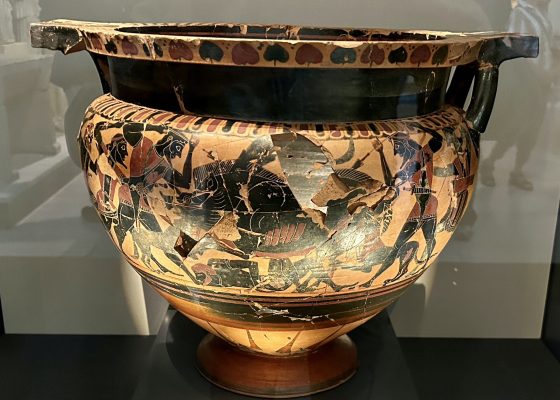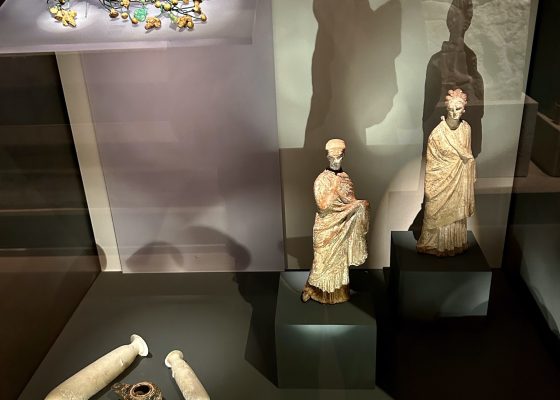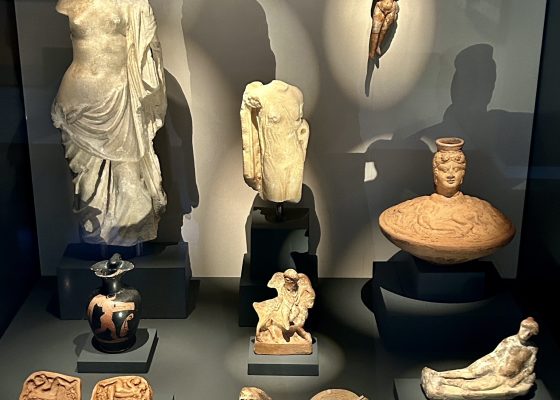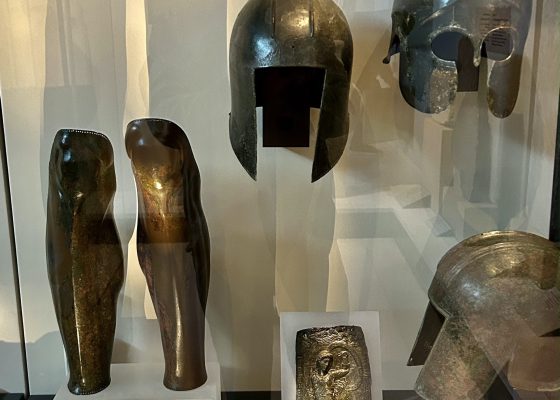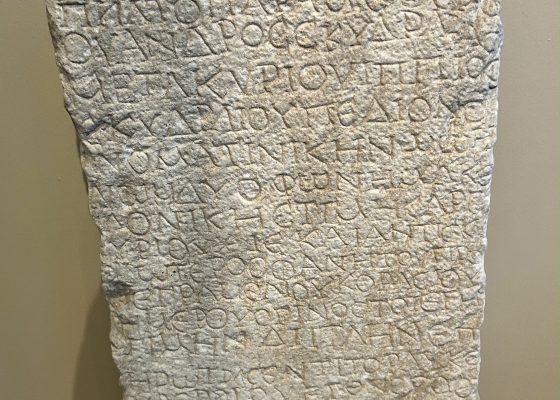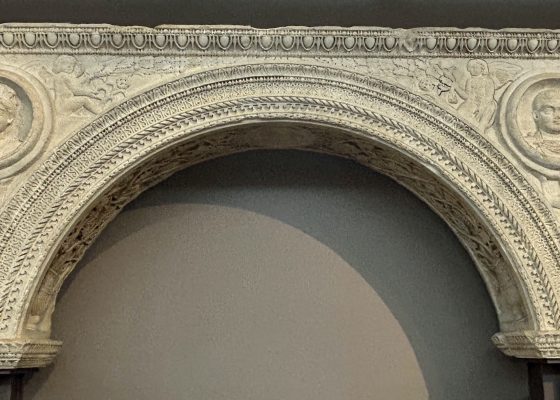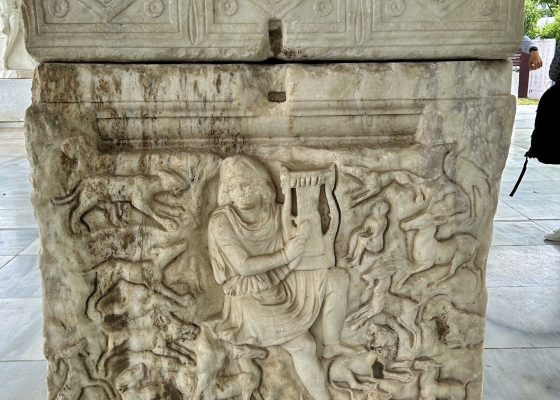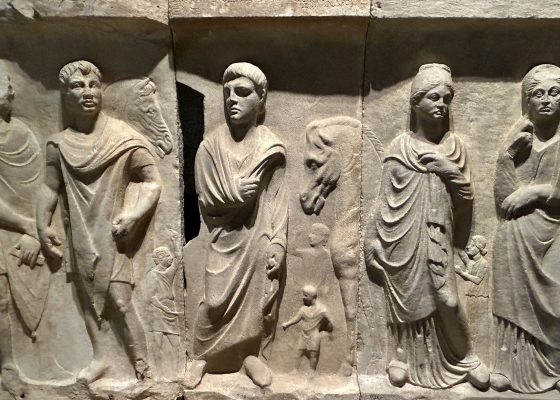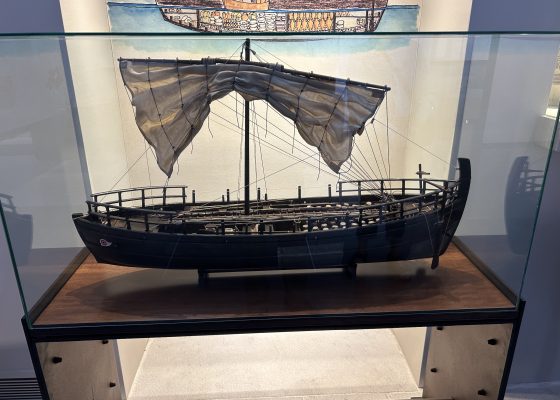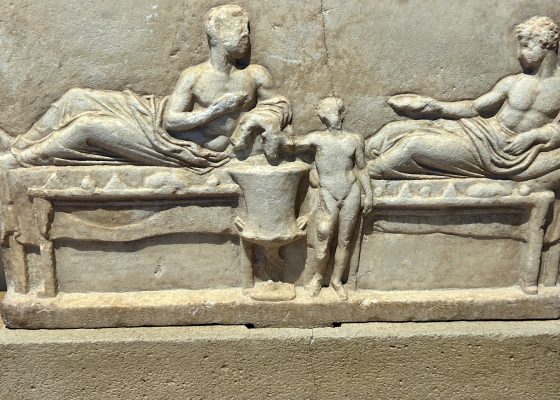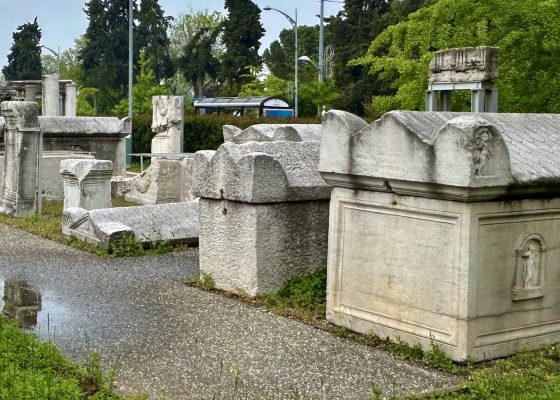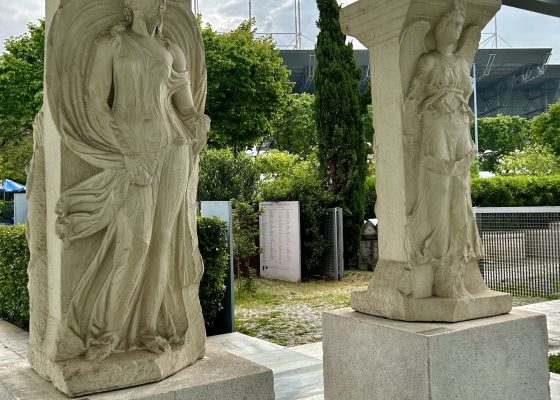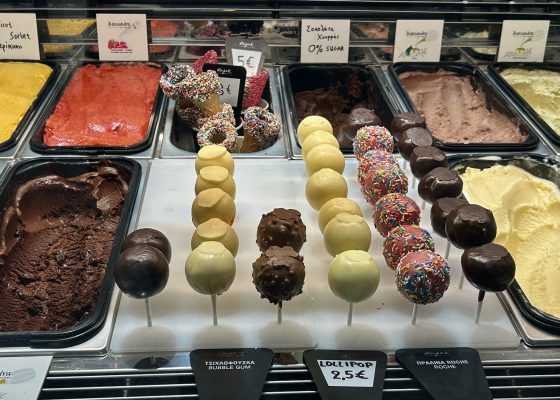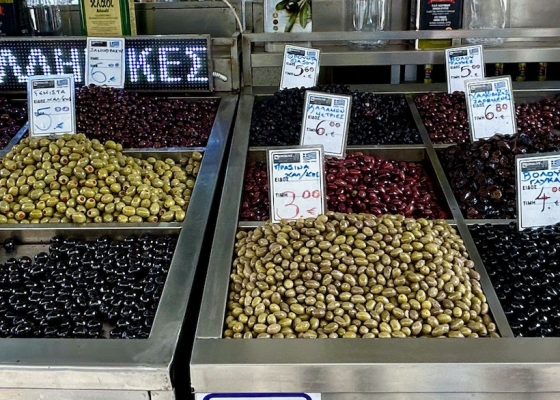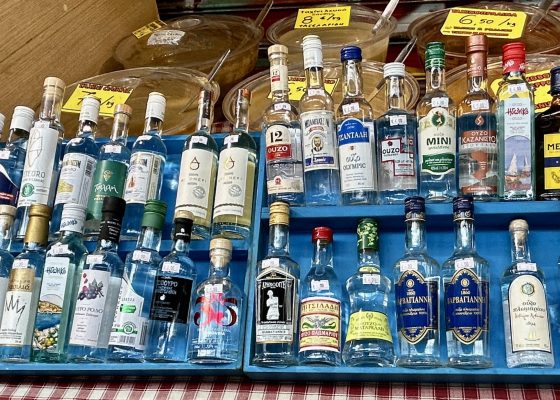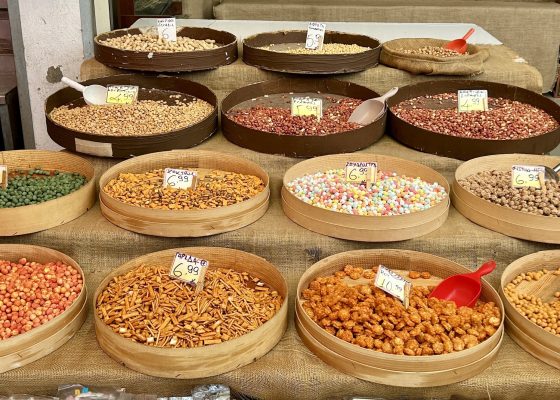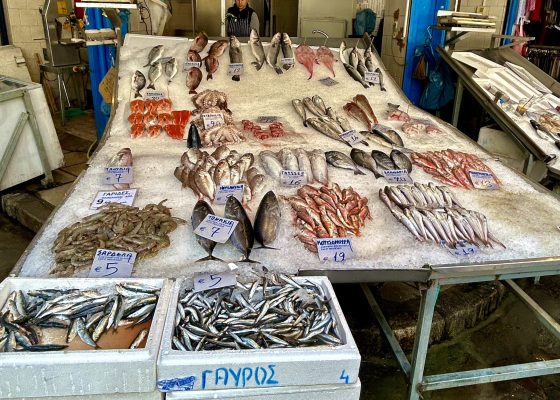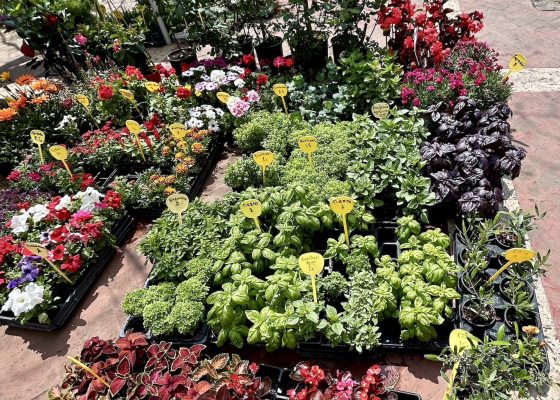Thessaloniki – Exploring Greece’s Second City
In the second last post from the Adventures Abroad Via Egnatia tour led by esteemed guide Victor Romagnoli we visited the UNESCO World Heritage Site of Philippi where St. Paul preached and was briefly imprisoned. In this post we’ll follow St. Paul to his next stop, the ancient city of Thessaloniki. It is a place I have long wanted to visit because so much history was made within its walls from Aristotle right up to the 19th century when Kemal Ataturk began his life’s journey here. So please join our little band as we spend two full days exploring Thessaloniki.
History of Thessaloniki
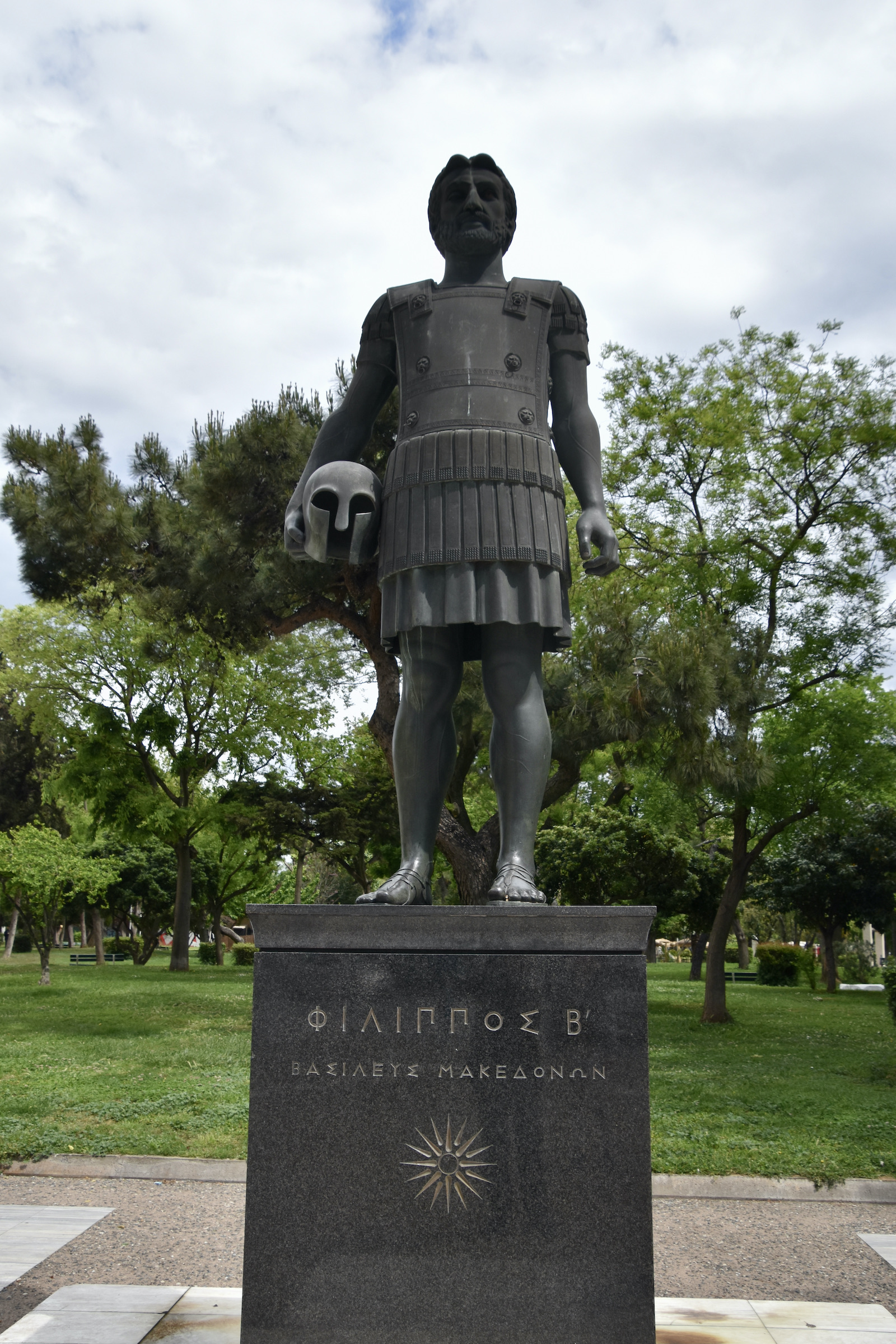
Although you will find this statue of Philip of Macedon and a larger one of his son Alexander the Great which we’ll visit later, neither ever set foot in Thessaloniki. That was because the city didn’t exist during their time, but was founded in 315 BCE by Cassander who became king of Macedonia after Alexander’s death. He was part of group along with Alexander, Ptolemy and Lysimachus who studied under Aristotle. He secured this position by having Alexander’s only legitimate son murdered along with Alexander’s wife Roxana. This happened some years after he founded the city which he named after Alexander’s half sister, Thessalonike who was also his wife. The name was given to her by her father Philip after a major victory in Thessaly over the Phocians. It literally means victory in Thessaly which is somewhat weird because Thessaloniki is nowhere near Thessaly. The murder of his nephew was only one of Cassander’s many misdeeds and it was perhaps a blood omen of what was to come for the city he founded which has seen more massacres than any city I can name.
Thessaloniki really came into its own during the Roman era when it was the major city on the Via Egnatia and the most important port in the northern Aegean. It was during this period that St. Paul made his two visits, the epistles of which are now two books of the New Testament. Later in the 4th century the city acquired its patron saint, Demetrius who was a Roman proconsul who was martyred for his Christian beliefs. Ever since then he has been a major figure in the Greek Orthodox religion and Thessaloniki is one of the most important bastions of that religion today. We will visit the vast church dedicated to him which was built on the site where he was murdered.
The 4th century also saw the first of those many massacres when German troops in the pay of the Emperor Theodosius I ran amok and killed over 7,000 men, women and children. This is somewhat astonishing considering that Theodosius I is considered one of the great Christian emperors, responsible for establishing the Nicene creed and much of the trappings of the religion as it has come down to us today. After the fall of the Western Roman Empire, Thessaloniki became the second most important city in the Byzantine Empire after Constantinople. Unlike Constantinople, Thessaloniki was ravaged on a number of occasions by Bulgarians, Saracens, Normans and Christian crusaders, until finally falling under Ottoman control in 1430. It remained under Ottoman control until 1913 when it was finally included in the modern country of Greece.
Under the Ottomans not only did the Muslim population increase dramatically, but so did the Jewish population, to the point that Thessaloniki was one of the largest Jewish enclaves in the world. Everything changed in 1917 when occupying French soldiers started a fire that virtually destroyed the city, especially the Jewish quarter. Many of them chose not to rebuild, but to emigrate to Palestine and the United States. However, they were replaced by thousands of Greeks who were expelled from their homes in Turkey in the great population exchange of the early 1920’s. In turn thousands of Muslims left the city for Turkey, including Kemal Ataturk’s family. It was only after these events that Thessaloniki truly became a Greek city as opposed to a much more diversified metropolis. During WWII, the Nazis occupied the city and proceeded to exterminate the remaining Jewish population which was still as high as 60,000. Less than 1,200 survived. We will visit a museum dedicated to the Jewish experience in Thessaloniki later in this post.
Today Thessaloniki is a thriving port city of just over 800,000 inhabitants. In 1988 the city’s early Christian and Byzantine churches and the city walls were inscribed as a UNESCO World Heritage Site with this description: The monuments of Thessalonika inscribed on the World Heritage List are public edifices of various functions, religious, secular, military, including the 4 km long city walls. Because of their outstanding design and major artistic value these monuments are included among the most significant of the Byzantine period. Throughout the Byzantine era, the city constituted a cultural centre that determined the developments not only in immediately surrounding but also in neighbouring areas. It played an active or even competitive role in artistic trends originating in Constantinople. Note that UNESCO refers to the city as Thessalonika which is the spelling I grew up understanding, but the proper name is Thessaloniki so I am using that instead.
We arrived in Thessaloniki after finishing our boat tour of the Mount Athos peninsula which I described in the last post. It was fairly late in the day so we didn’t have time for touring and checked into the almost brand new Elisabeth Hotel which is the epitome of Greek chic. We spent three nights here and I would highly recommend it to anyone planning on visiting Thessaloniki.
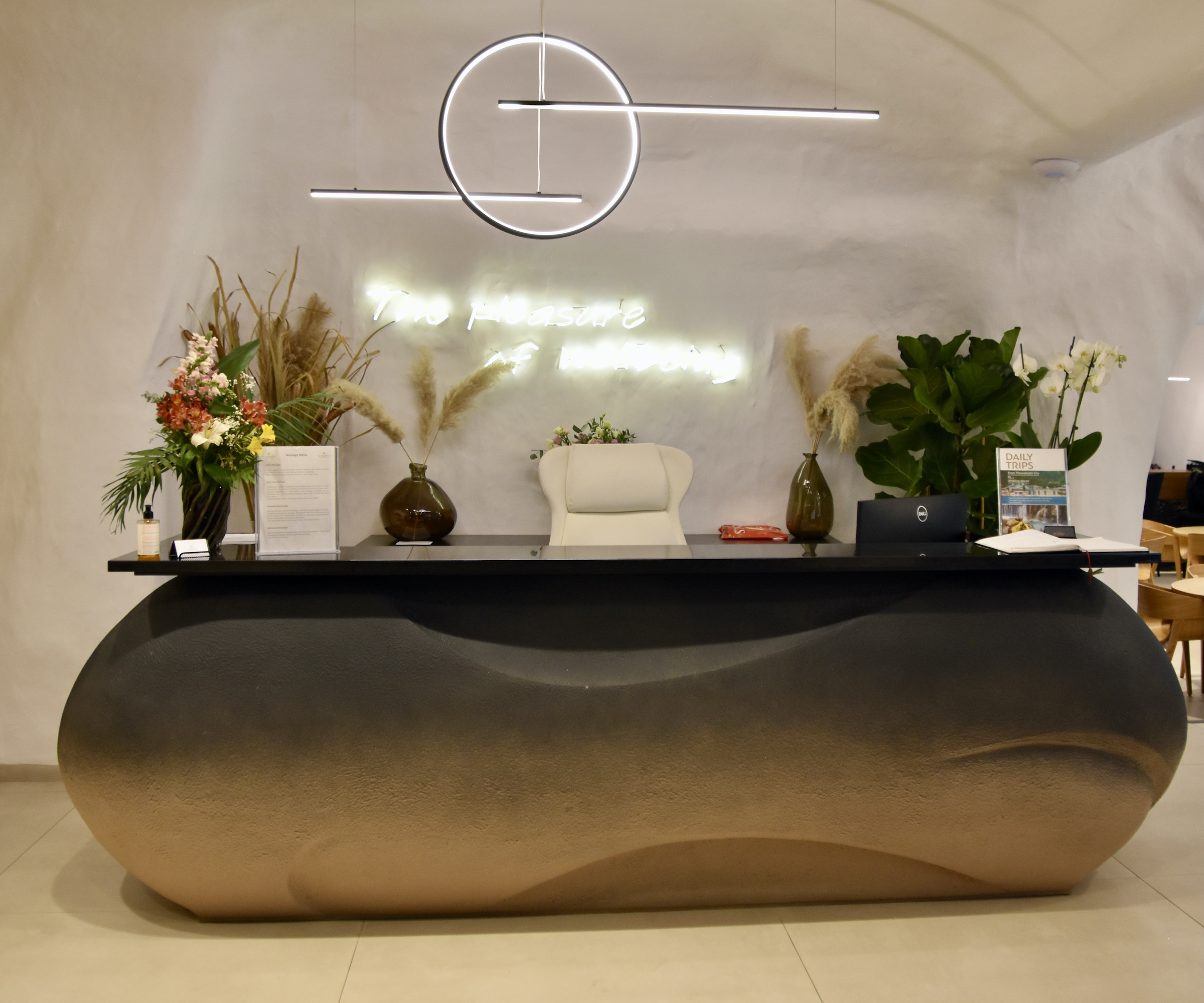
After getting settled we met Victor at a restaurant whose name I negligently forgot to record because the food was outstanding. This is eggplant with smoked paprika sauce.
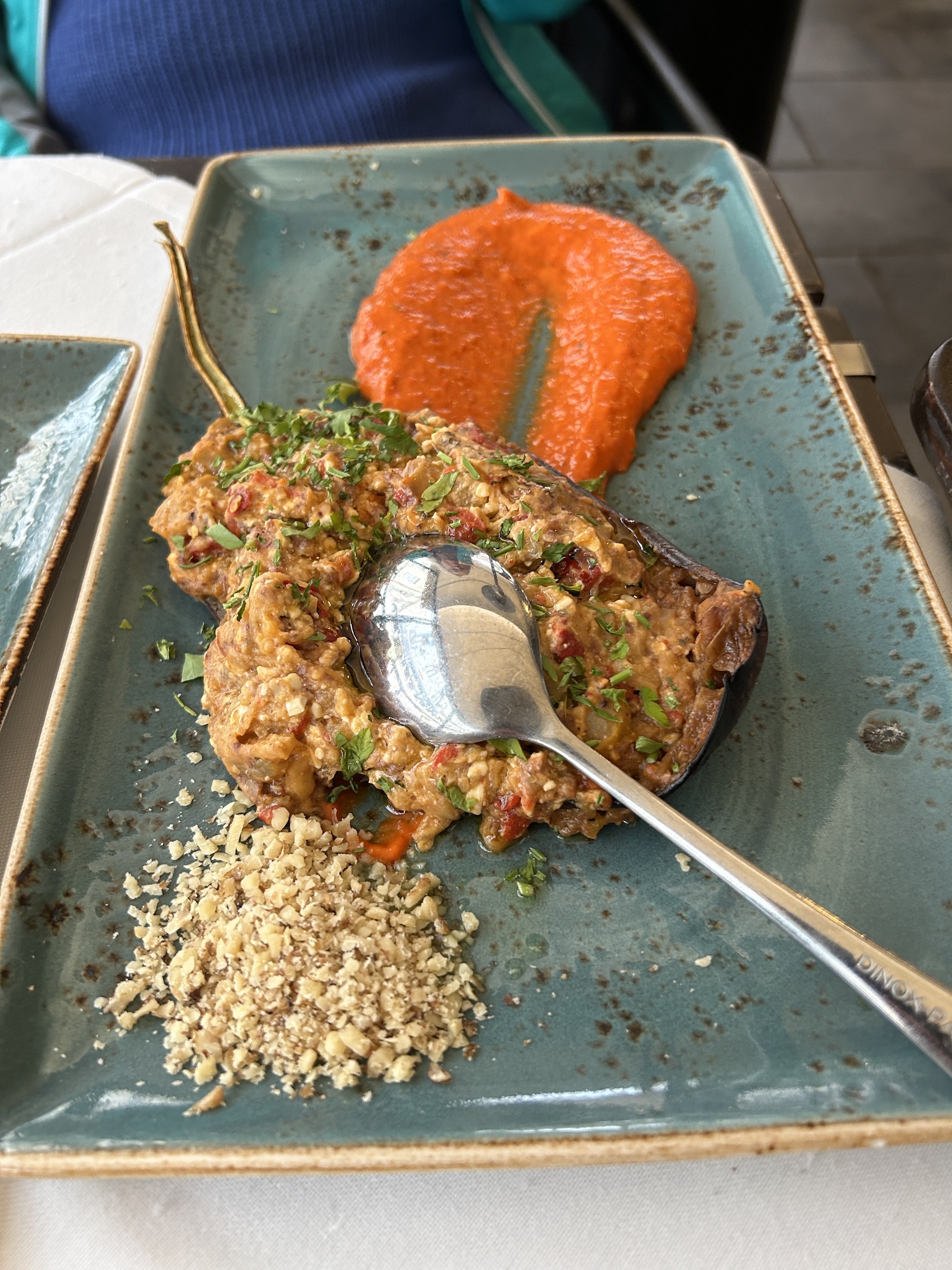
And my entree, lamb meatballs. Just looking at the photo makes my mouth water.
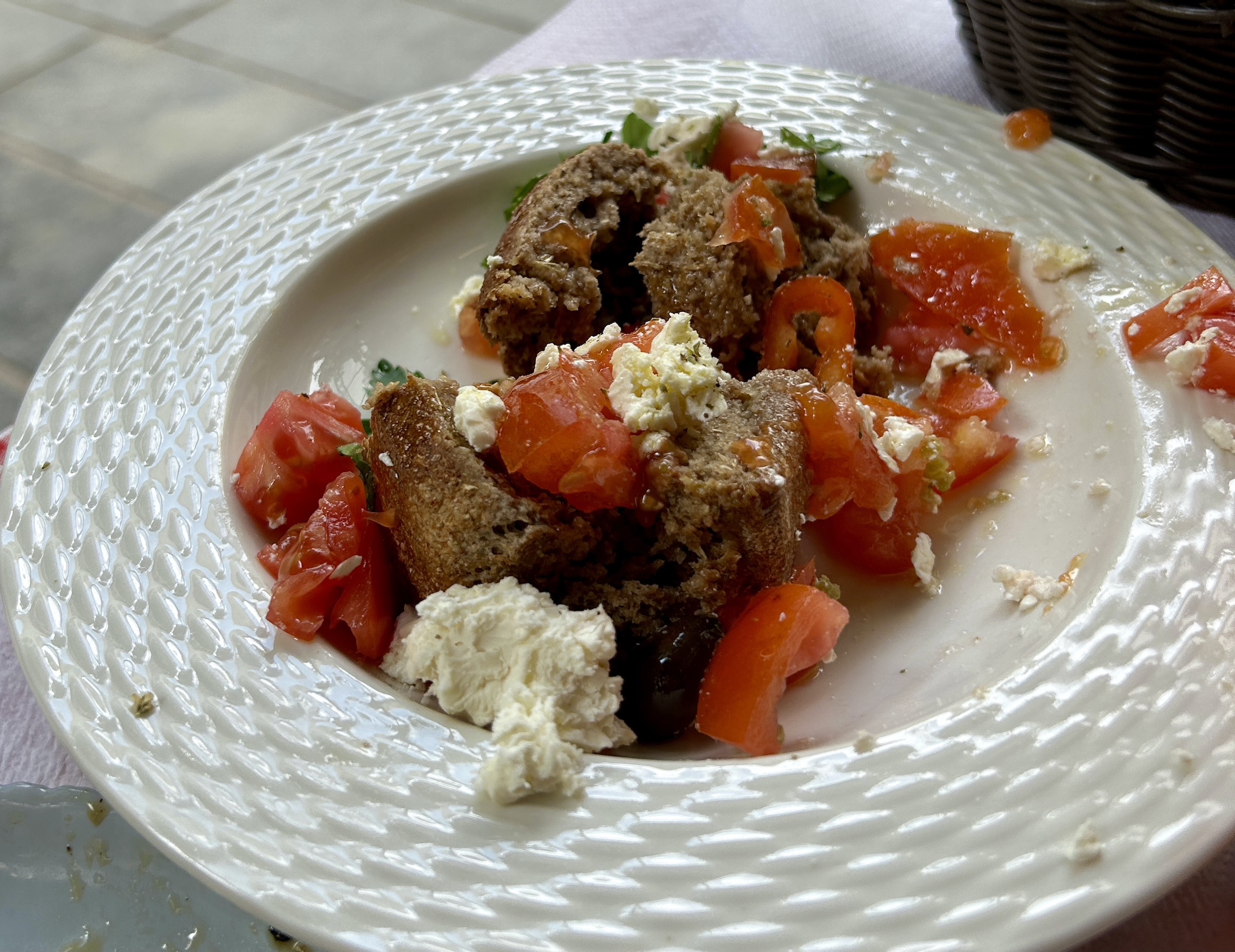
The bottom line is that we stayed at a great hotel and had great food during our time in Thessaloniki. After a great nights sleep let’s start exploring this amazing city!
Archaeological Museum of Thessaloniki
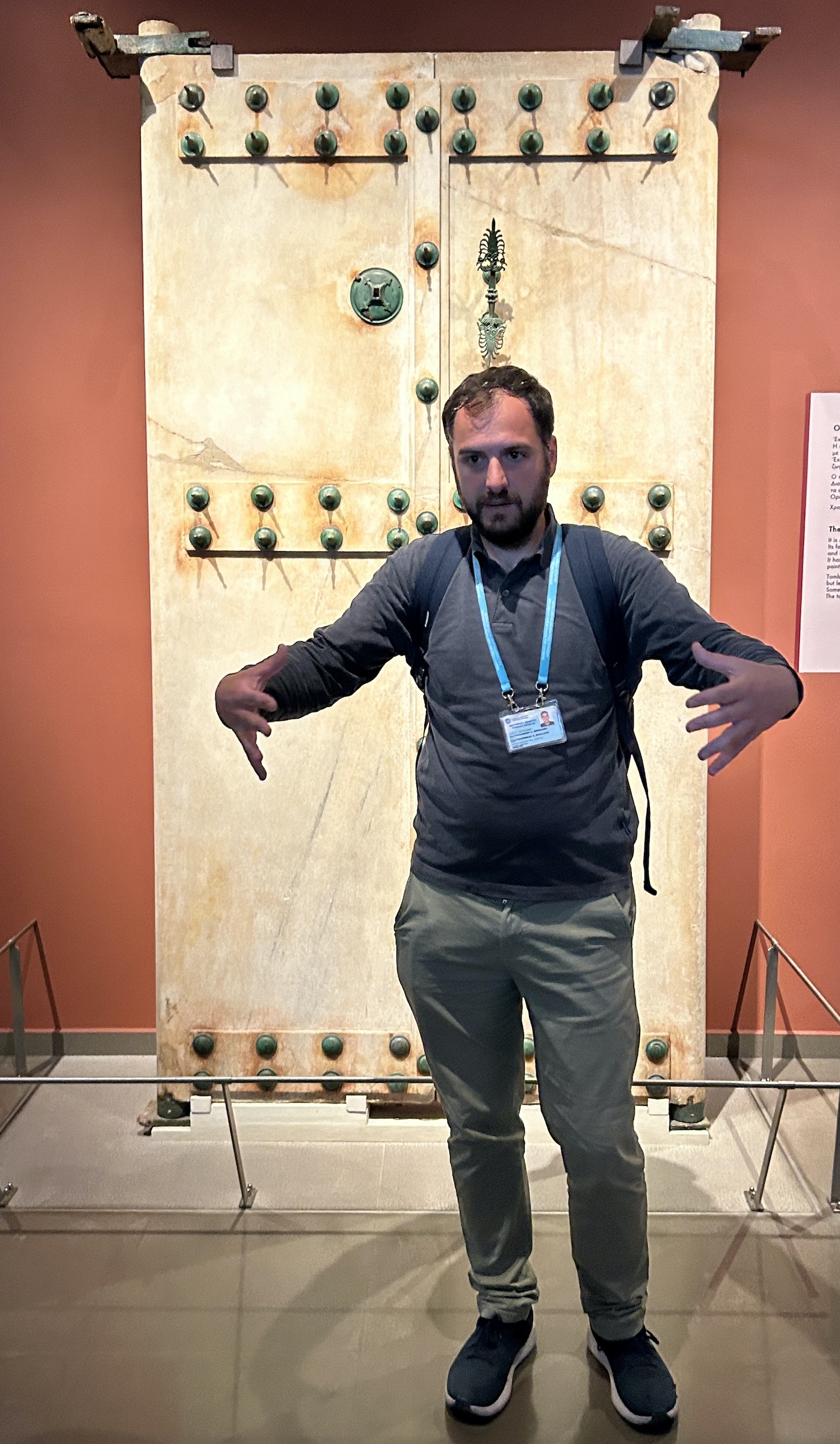
The first place our local guide Nikos took us to was the Archaeological Museum of Thessaloniki, considered to be one of the best in the country and the repository of some of the best Macedonian artifacts found anywhere. Here he is explaining the layout of a typical Macedonian tomb which is important to know as we will be visiting the tombs of Phillip II and other Macedonian nobles when we get to Vergina. I could do an entire post on some of the best objects in the museum, but will content myself with this gallery. Double click to open one and double click again to enlarge.
- Krater Painted by Lydos – 6th Century BC
- Macedonian Tomb Objects
- Macedonian Love Objects
- Macedonian Armour
- Bill of Sale for a Slave Girl
- Little Arch of Galerius
- Orpheus Sarcophagus
- Relief from a Grave Marker
- Ship Model
- Symposium
- Outdoor Artifacts
- Replicas of the Statues in the Louvre
I did take the time to have my picture take with Augustus. Remember this pose because we will be seeing it again in a completely different setting.
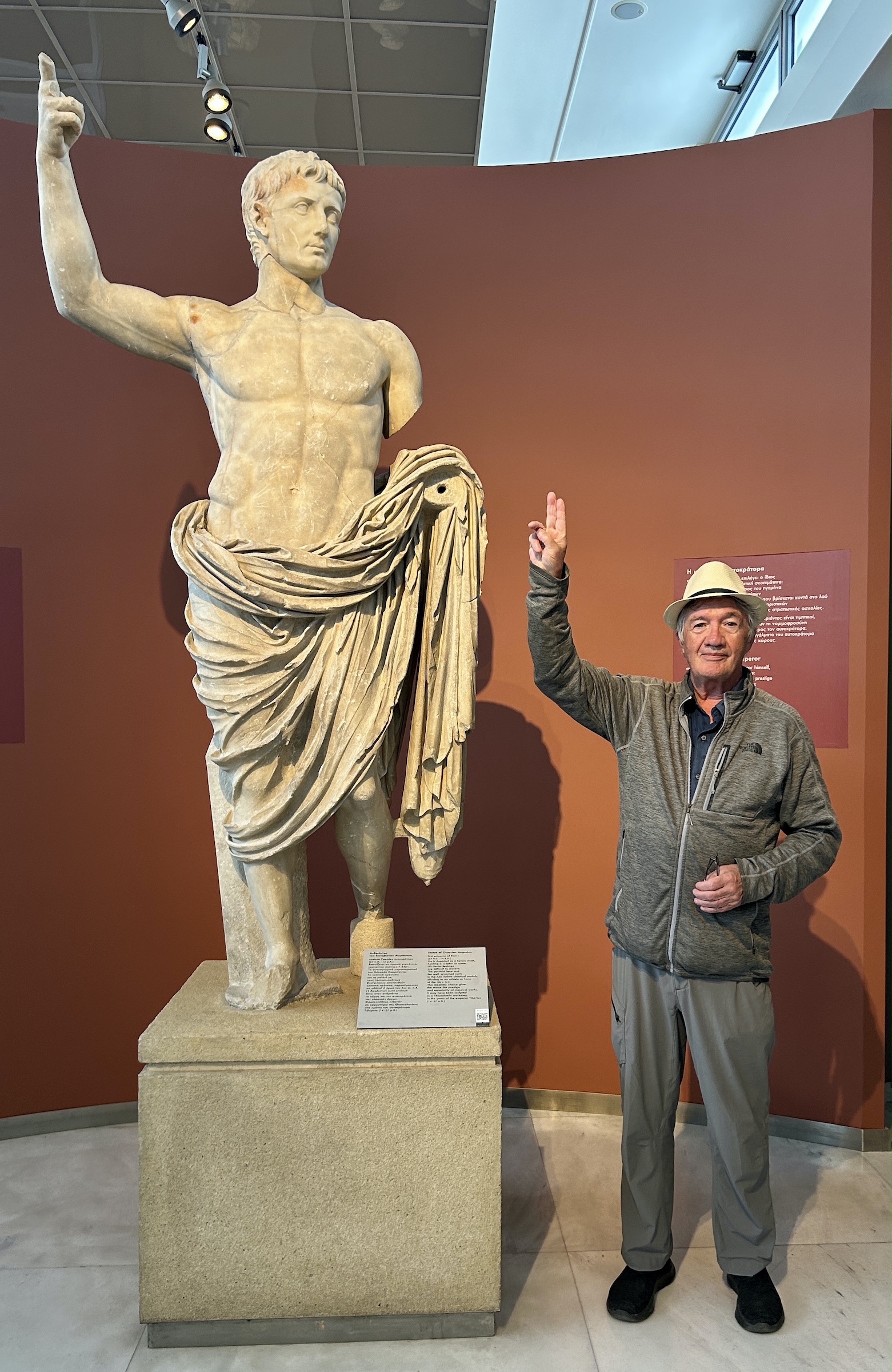
The Promenade
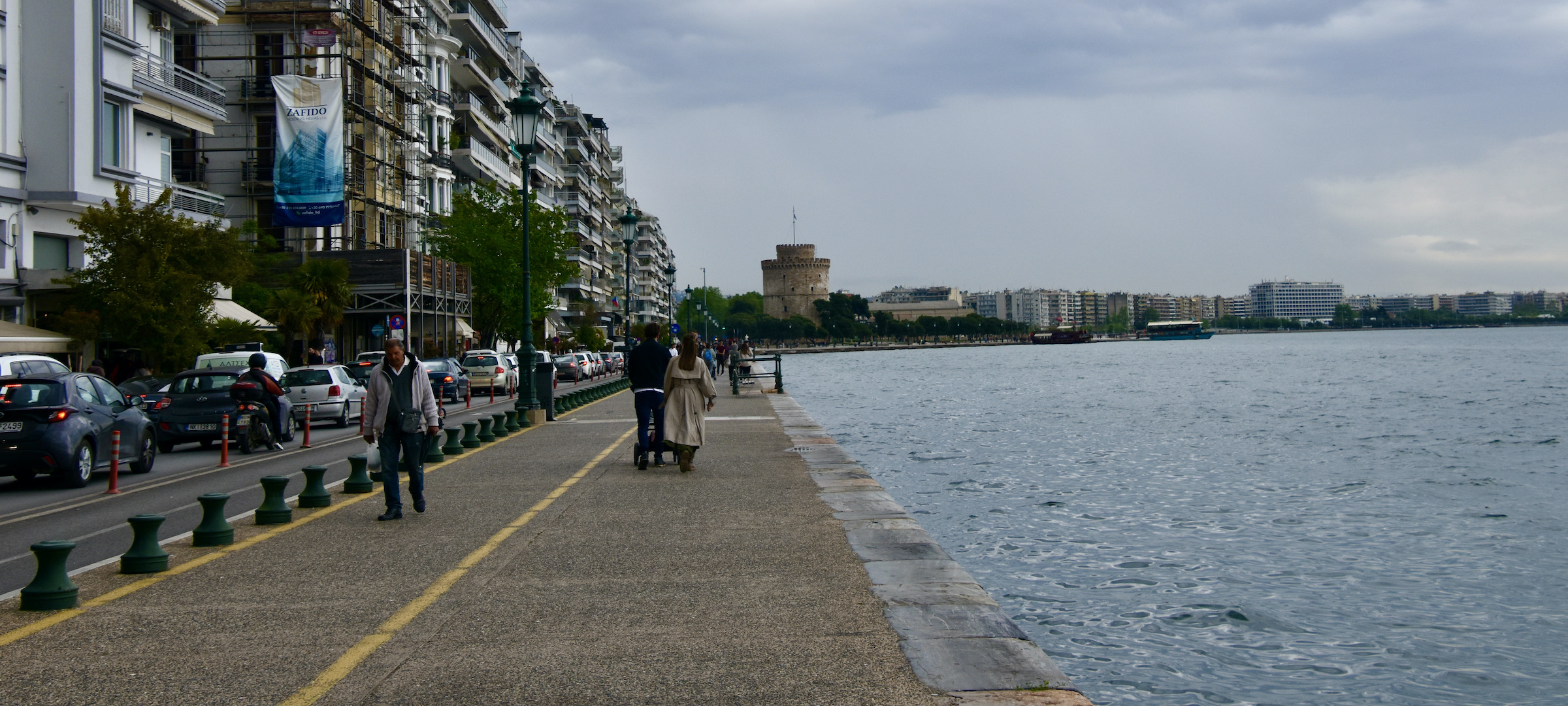
It’s only a short walk from the museum to the waterfront promenade which is one of Thessaloniki’s greatest attractions. Stretching for some 5 kms. (3.1 miles) along the Aegean, it is where you will find the iconic White Tower that is the symbol of the city and this wonderful statue of Alexander the Great on his famous horse Bucephalus.
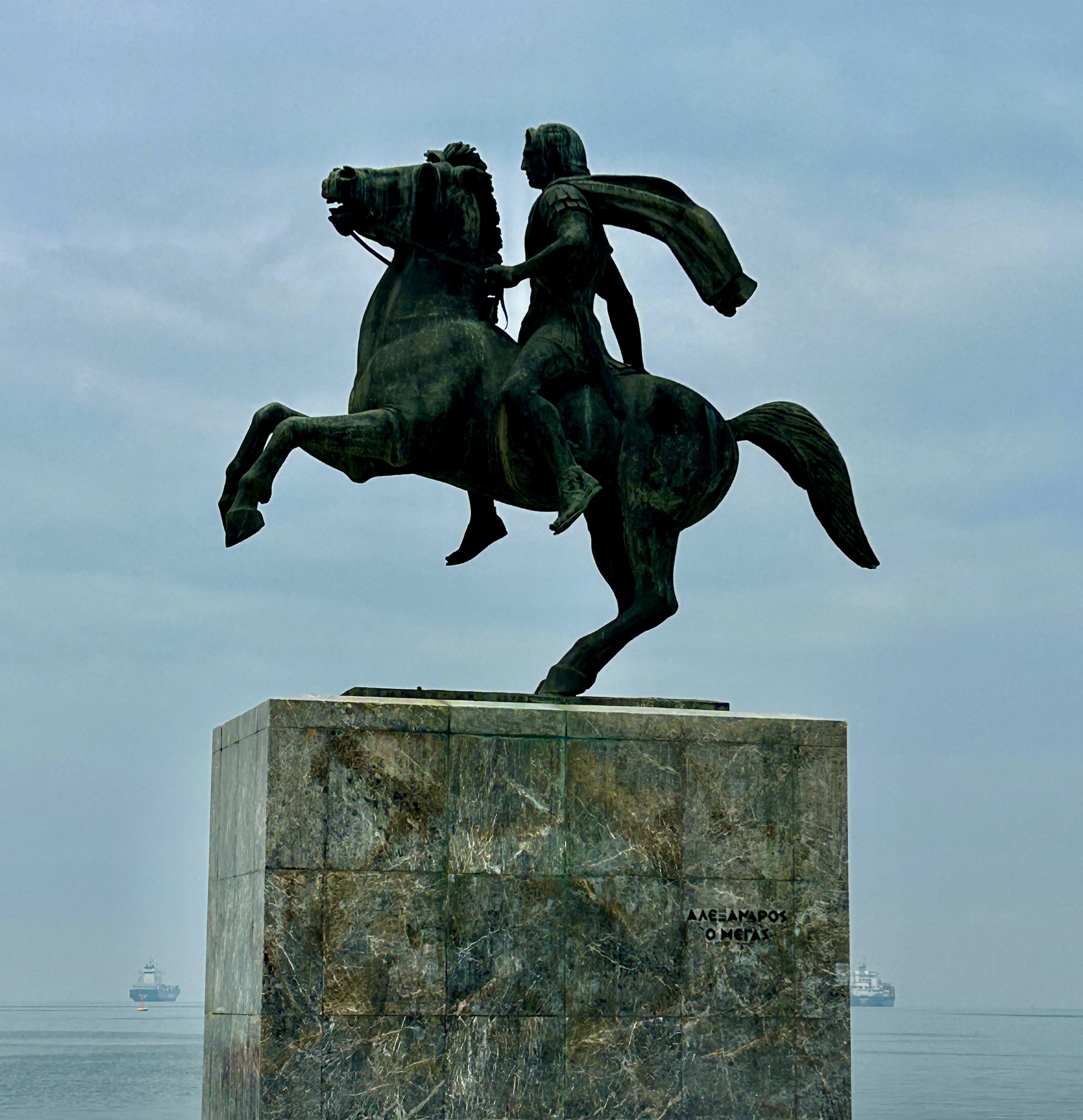
Paid for by volunteers, the statue was erected in 1973 and ever since has become a magnet for group photos, including us.
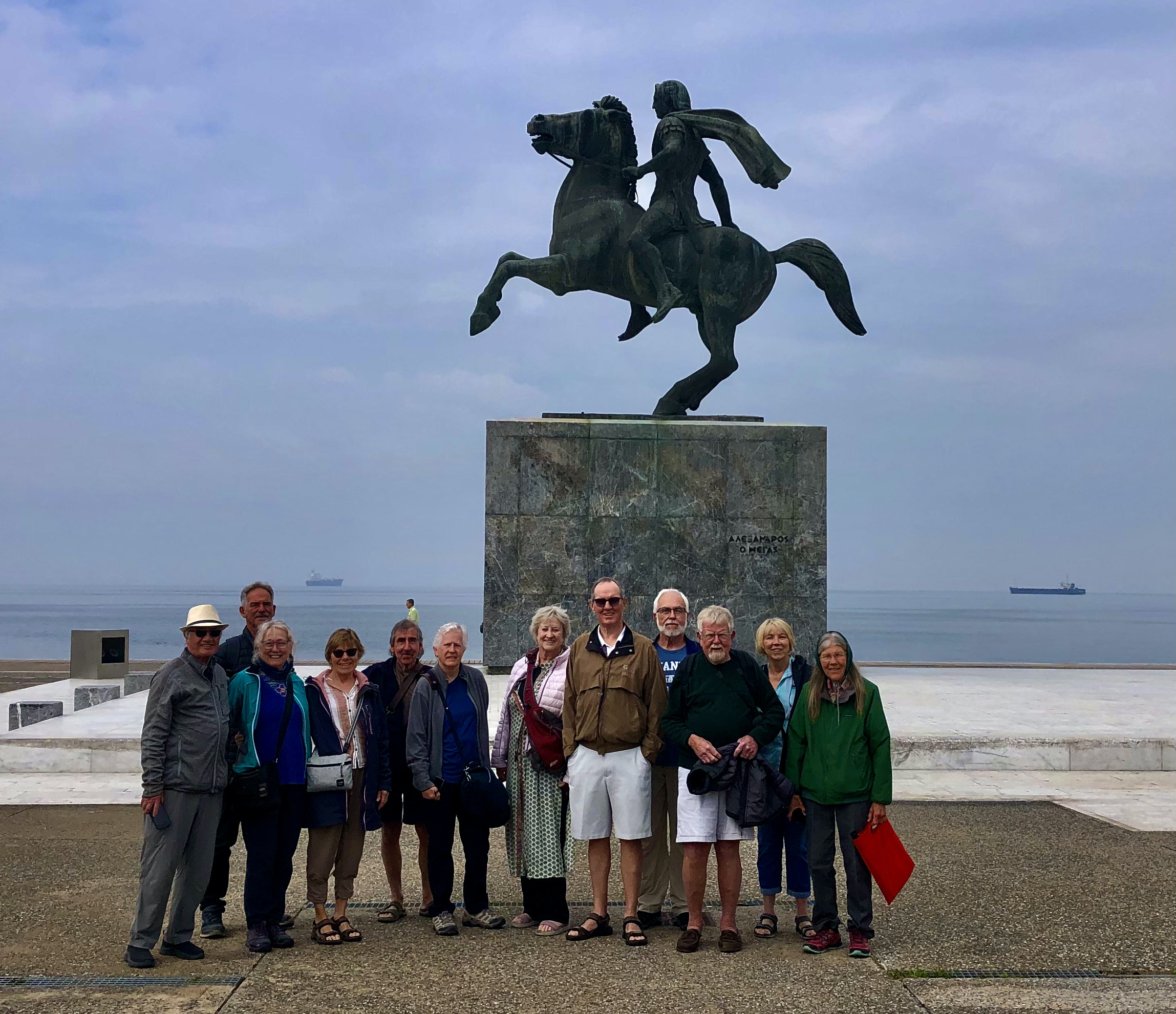
Further down the promenade you come to the White Tower which was built by the Ottomans on top of an older Byzantine structure, sometime after they captured the city in 1430.
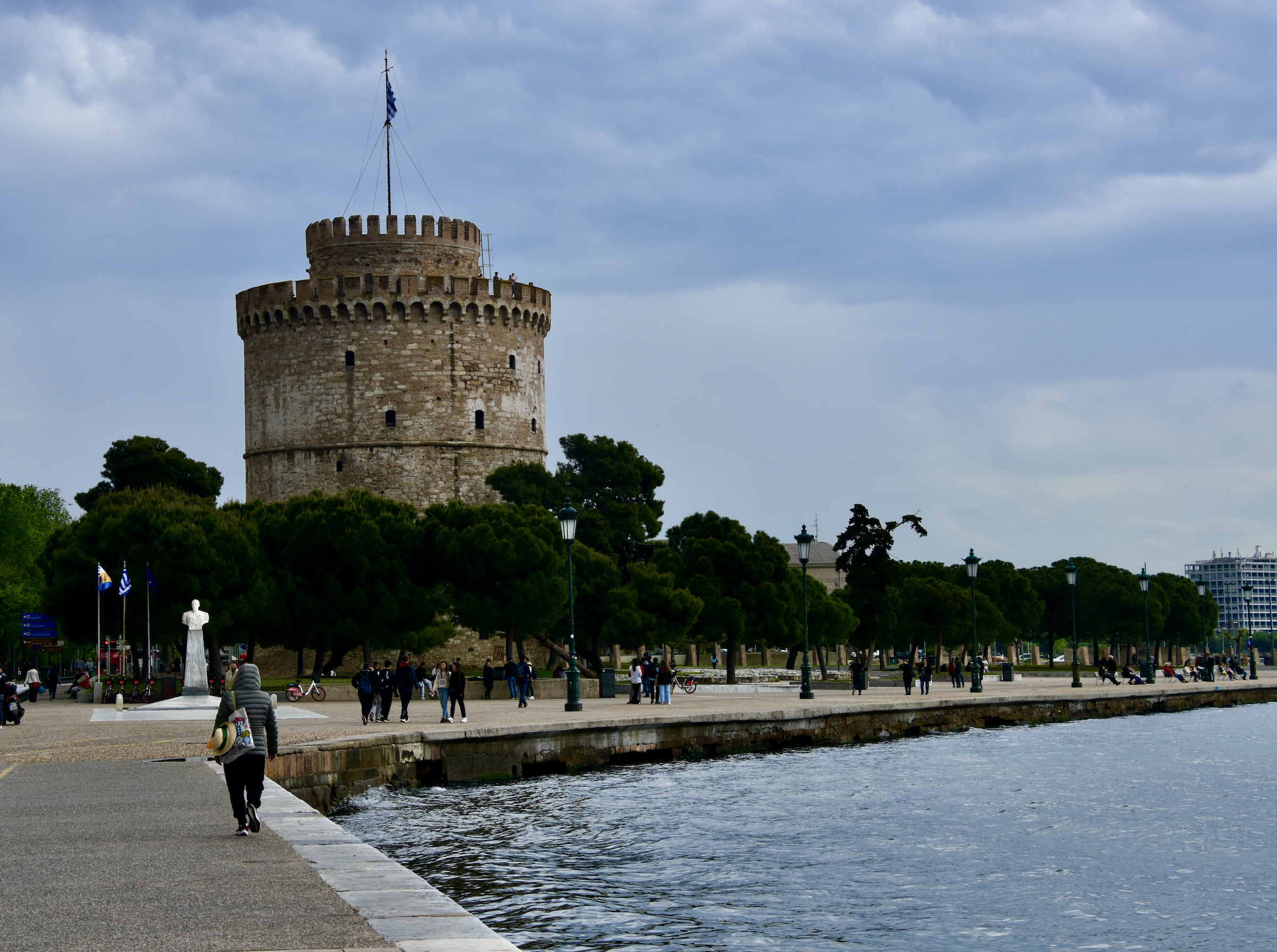
There is no agreement as to why or when it got its name, but there are some pretty gruesome speculations. One is that its walls were actually perpetually red from the blood that flowed down them from the prisoners executed on its roof. Another of Thessaloniki’s many massacres was carried out here on rebellious Janissaries in 1826. Eventually the tower did get whitewashed both literally and figuratively, but today it is more tan coloured than white. Every visitor to Thessaloniki should pay the entrance fee to climb these steps to the roof.
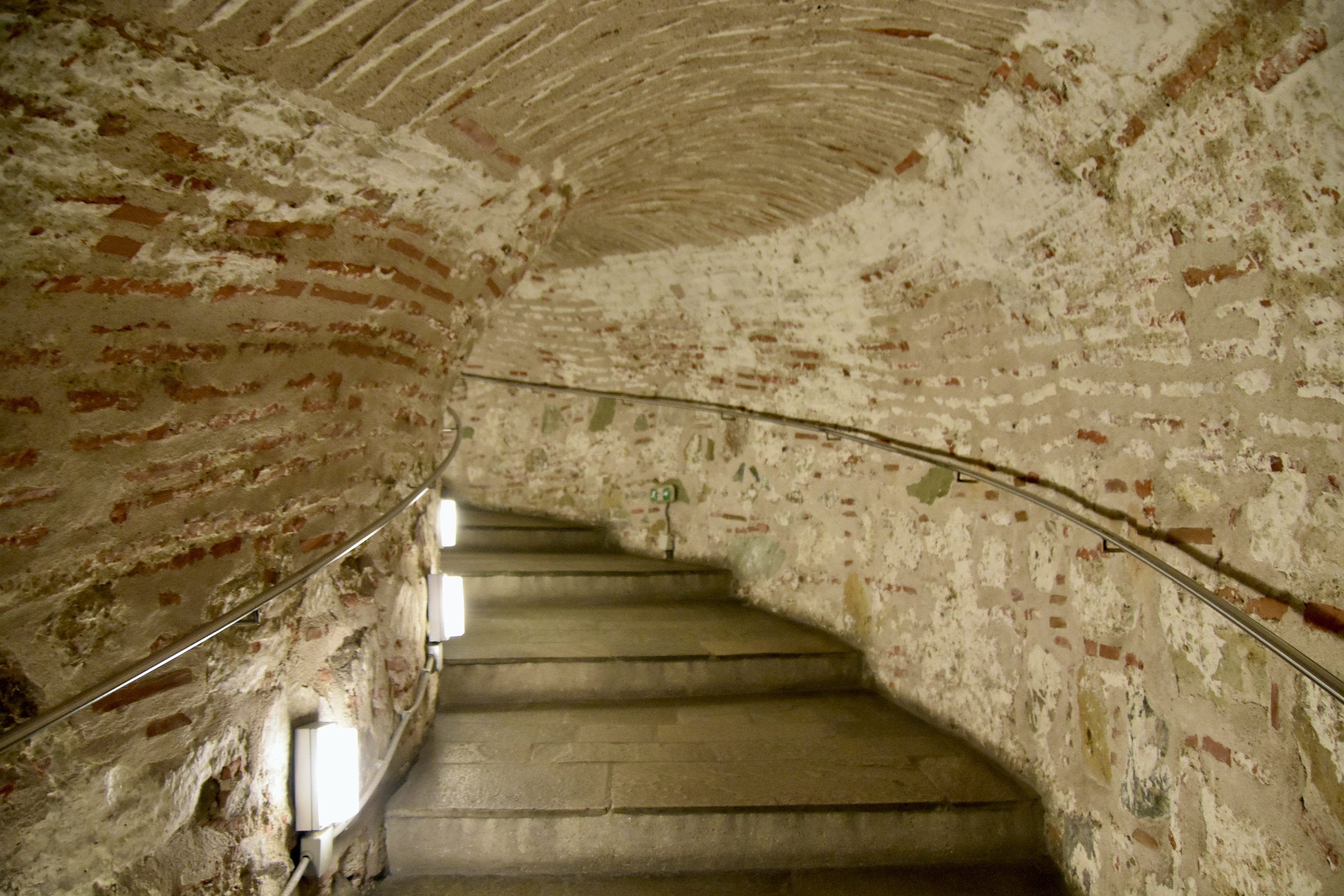
You’ll be rewarded with a 360º degree view of the city and harbour.
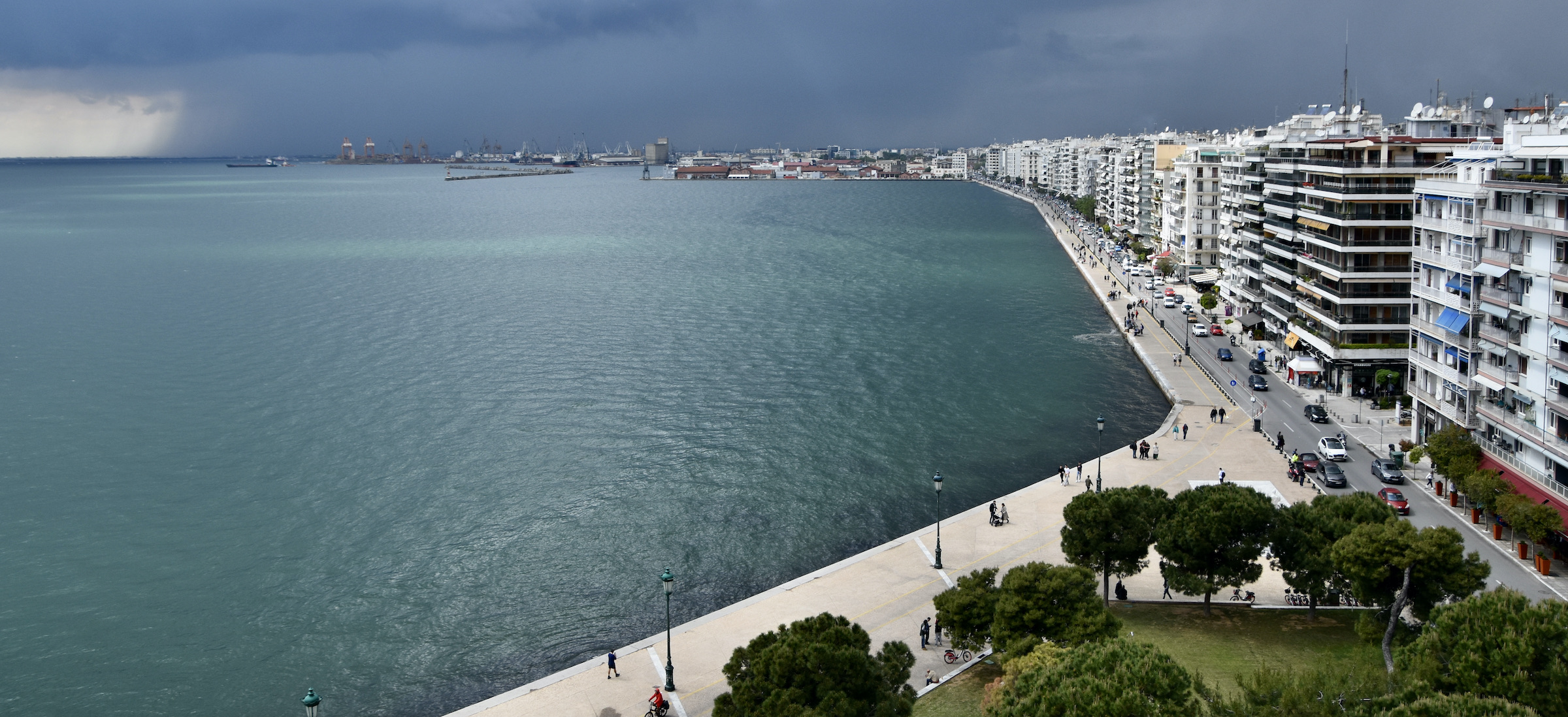
Up until the 19th century Thessaloniki was enclosed within a series of walls first constructed by Cassander and greatly expanded by the Roman and Byzantine Emperors. The White Tower was one of seven along the course of those walls. In the early 19th century the sea facing walls were removed, but thankfully the tower was spared. There are still portions of the walls remaining on the backside of the city we we will visit soon. But first, let’s check out some of the remains left by the Romans.
Roman Ruins
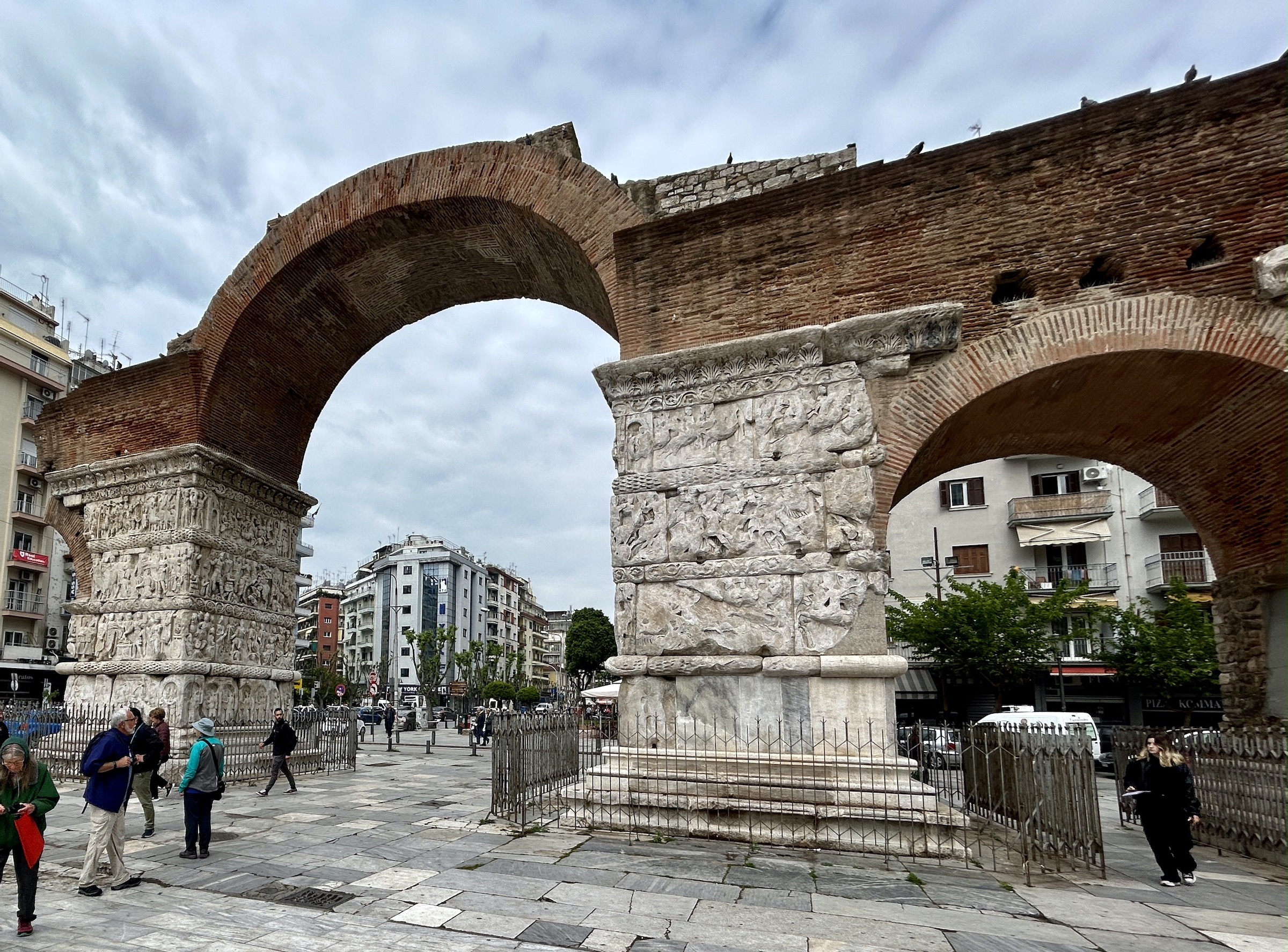
Thessaloniki has no shortage of ruins with the most interesting being the Galerius complex named for the last emperor who ardently persecuted Christians which ironically resulted in the consecration of one of the most important early Christian churches in a building erected by him. Above is the Arch of Galerius which straddled the Via Egnatia and was built to celebrate his victory over the Persians in 298. Details of the arch portray scenes from the war that was started by the Persian king Narseh, lasted four years and ended with the total rout of the Persian Empire. Parts of it are remarkably fresh even after 1,700 years including the second panel from the top that shows Galerius and Narseh in hand to hand combat. The arch, commonly called the Kamara by modern Greeks, is a popular meeting spot in Thessaloniki.
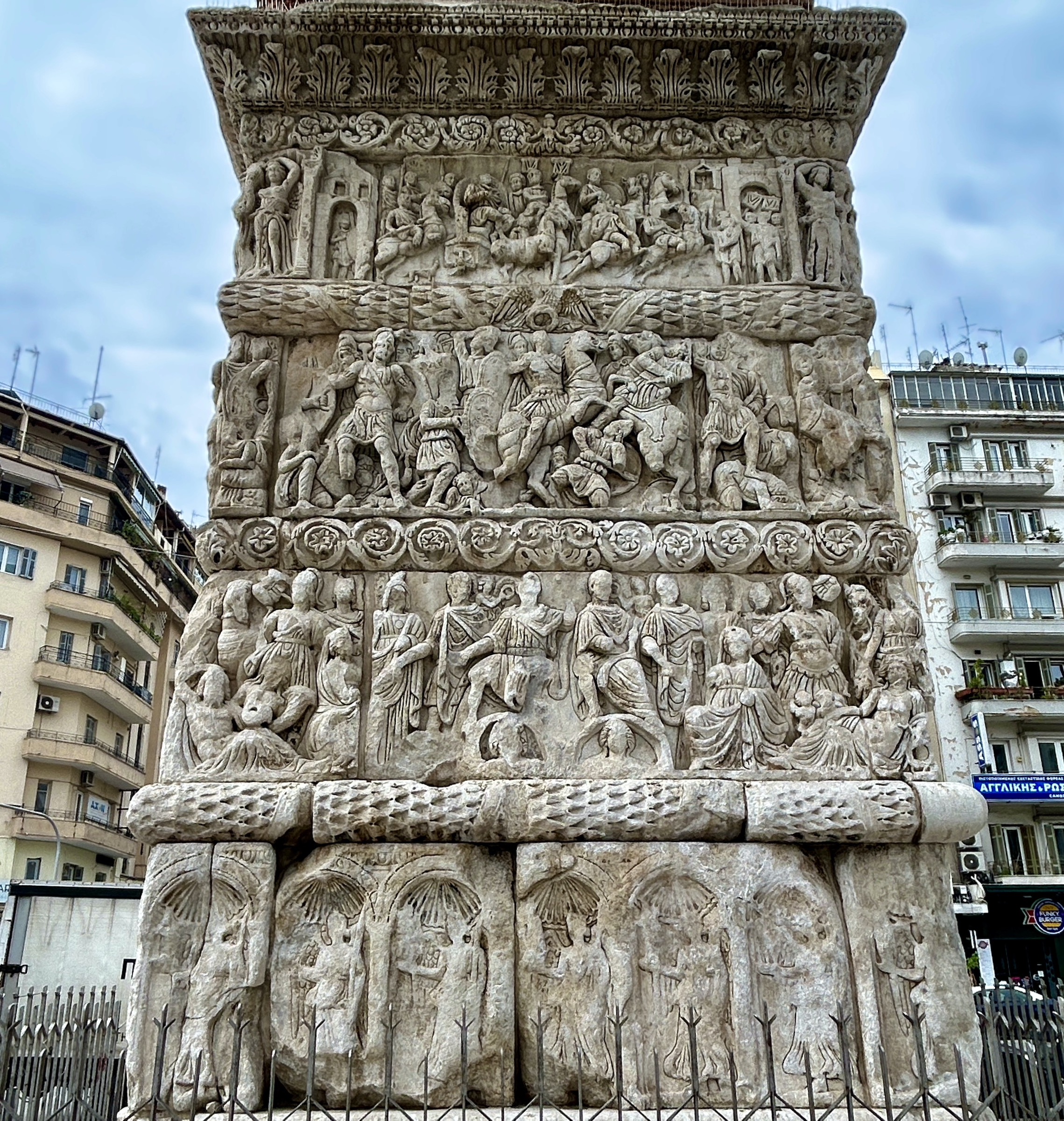
At one time the arch was only one small part of a much larger complex, which included the Palace of Galerius and many other buildings including a giant hippodrome. This is what it would have looked like at its height. The Via Egnatia runs through it near the top of this drawing and you can see a round building at the very top. This is the Rotunda and all that remains standing of this once magnificent series of buildings.
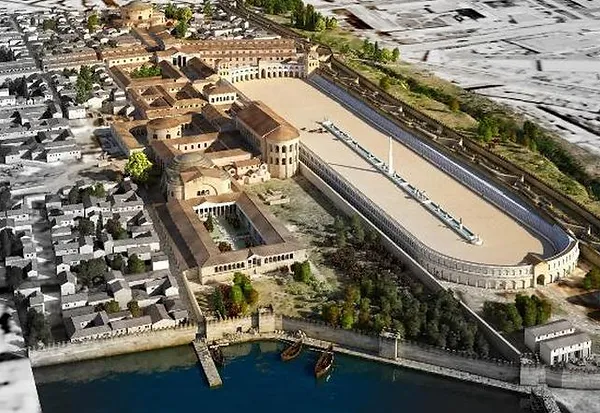
Between the arch and the Rotunda stood the mighty Apsidal Hall, but this is all that remains today.
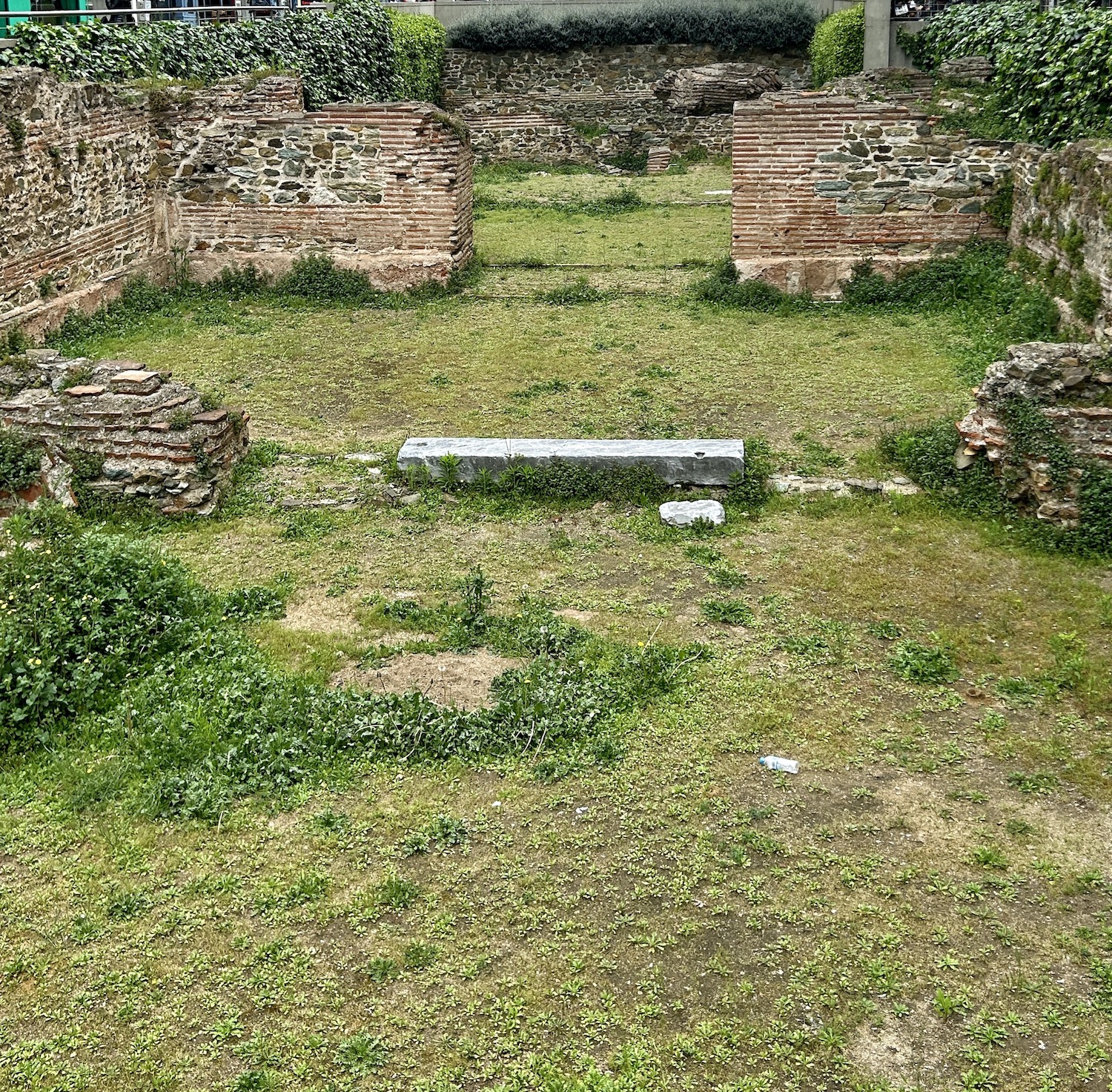
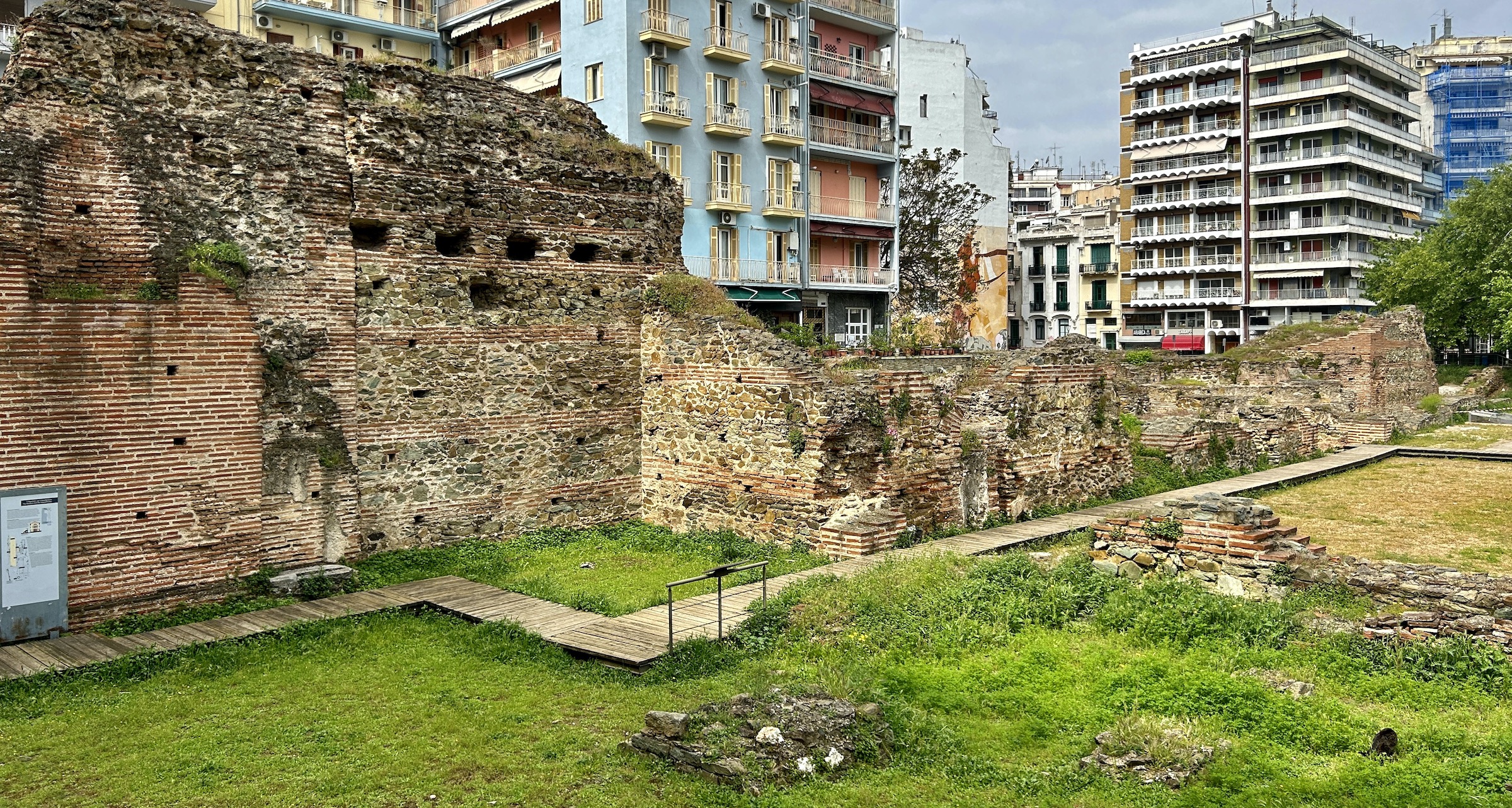
After the White Tower, the Rotunda is probably the most notable ancient building in Thessaloniki. It was built by Galerius around 306 and he intended to use it as his mausoleum. That never happened as he died in 311 from some sort of horrible disease which the Christians attributed to punishment from God for his persecution of them. He ended up instead being buried in his other palace complex Felix Romuliana in modern day Serbia, which is also a UNESCO World Heritage Site. The circular design was clearly influenced by the Pantheon in Rome which was built some 150 years earlier. Like the Pantheon it originally had an oculus or circular hole at the very top of the dome. After its completion it sat unused for over eighty years until Emperor Theodosius I had it consecrated as a church which would have made Galerius roll over in his Serbian tomb. It remained an important church in the late Roman and Byzantine eras for over 1,200 years when in 1590 it was converted to a mosque. You can also see the remains of a minaret that dates from the time the Rotunda served as a mosque under the Ottoman rulers up until 1912 when it was reconverted to a church. Today it is a national monument and not actively used for services.
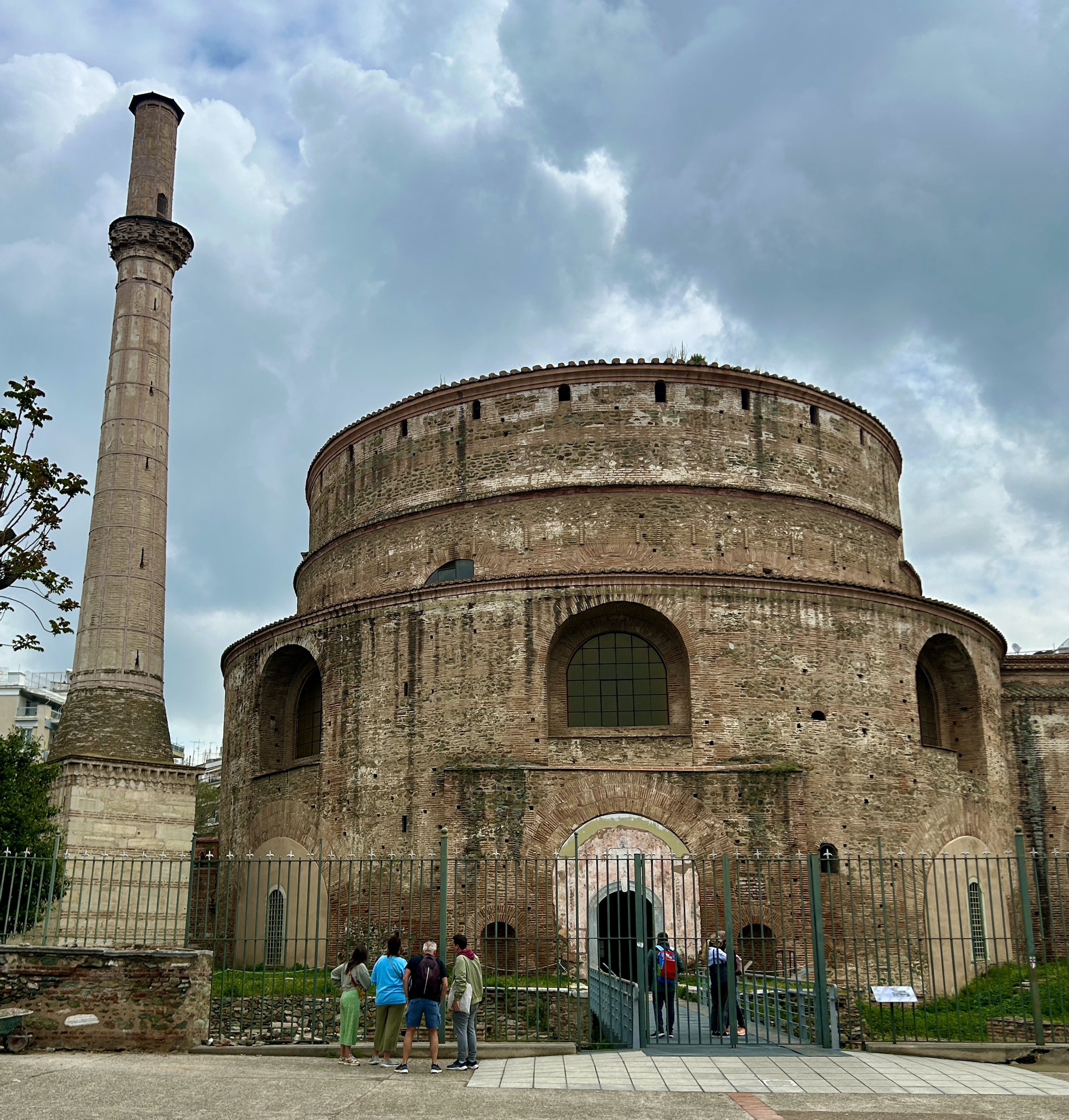
Let’s go inside.
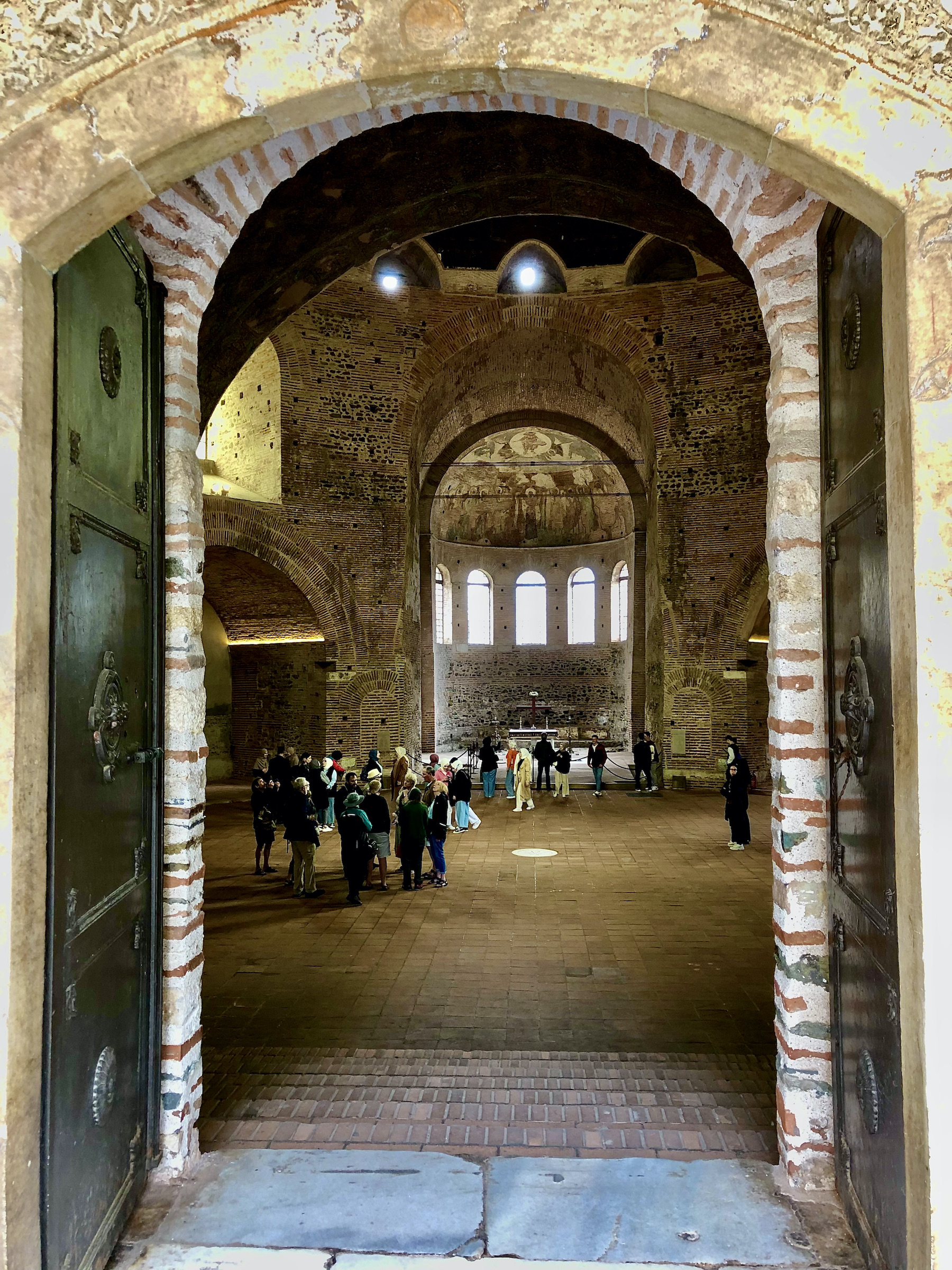
Over the entrance way are symbols of the time when it was first a church and then a mosque and back to a church again, dedicated to St. George as you can guess from the painting.
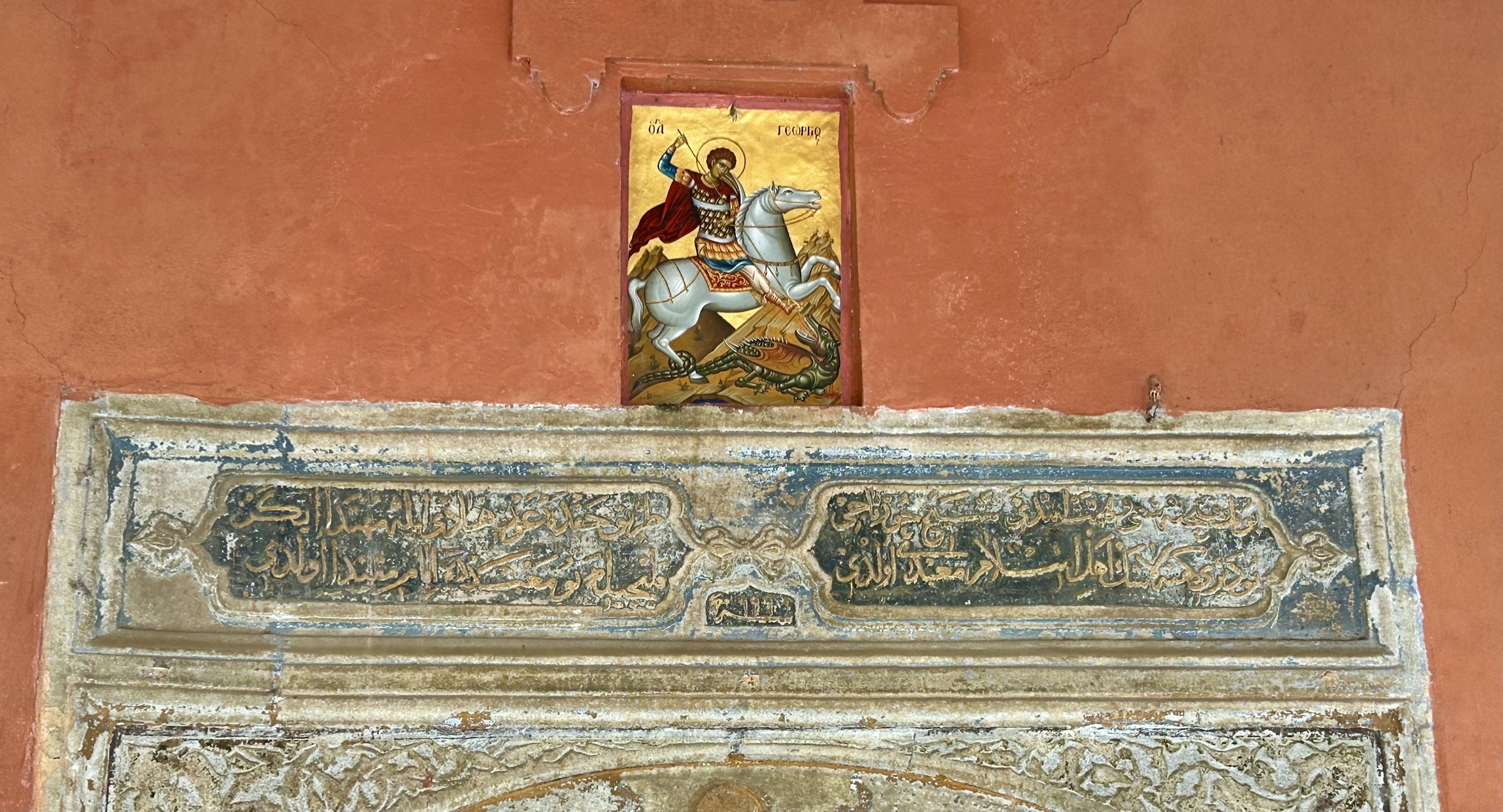
Sadly, the once marvellous mosaics and frescoes for which the Rotunda was justly famous in Byzantine times are mostly gone. This is what the ceiling looks like today.
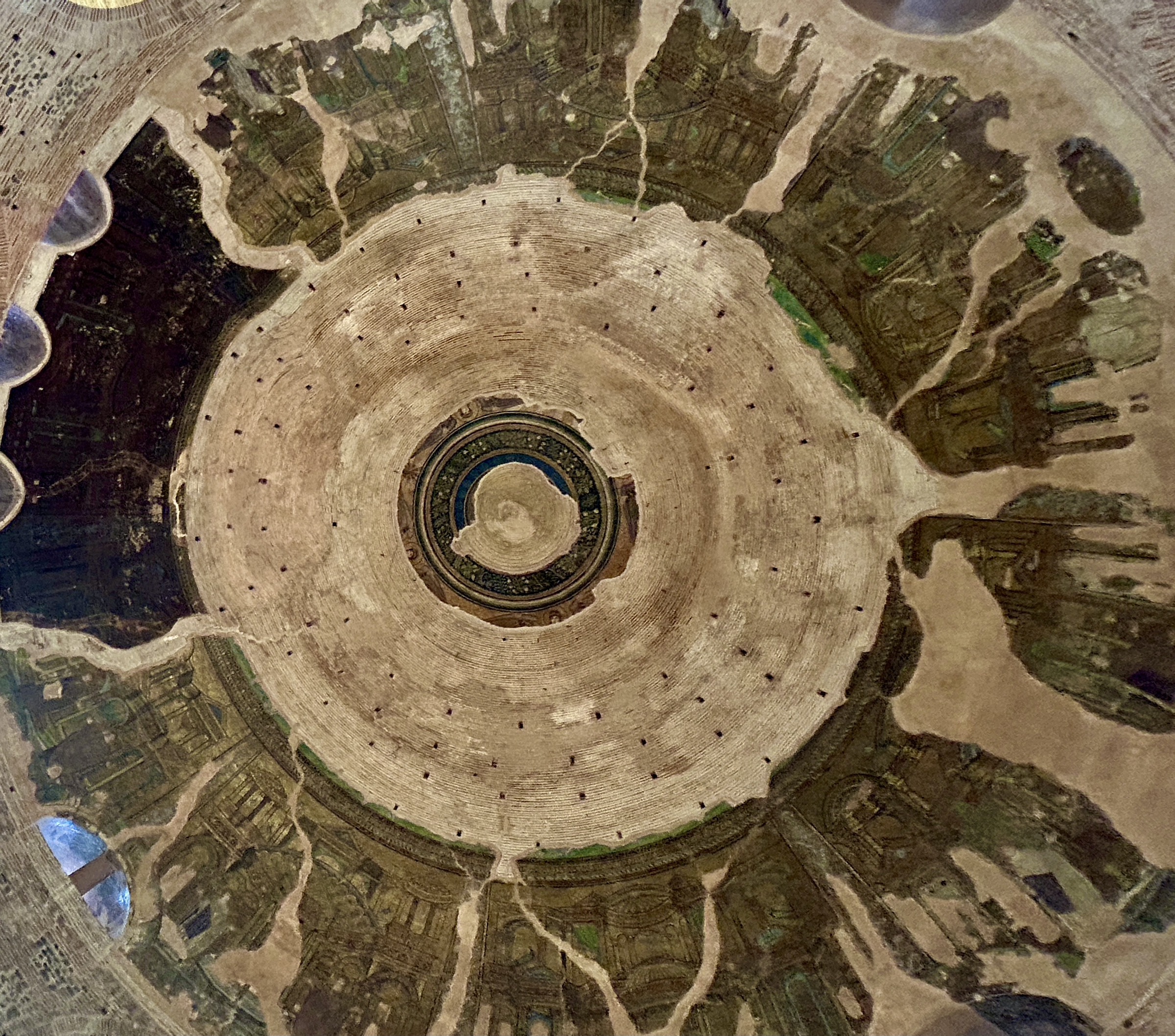
The Galerian complex is not the only set of major Roman ruins in Thessaloniki. While the Arch of Galerius and the Rotunda were always well known to natives of the city, the Roman forum was not. In the 1960’s excavation for a new courthouse were underway when a single Roman column was unearthed. Archaeologists then began investigating further gradually and only partially uncovered the remains of the original forum of Thessaloniki which in turn had been built atop the original Greek agora of the city. Here is a view of part of the forum with the sole column that saved it from complete destruction.
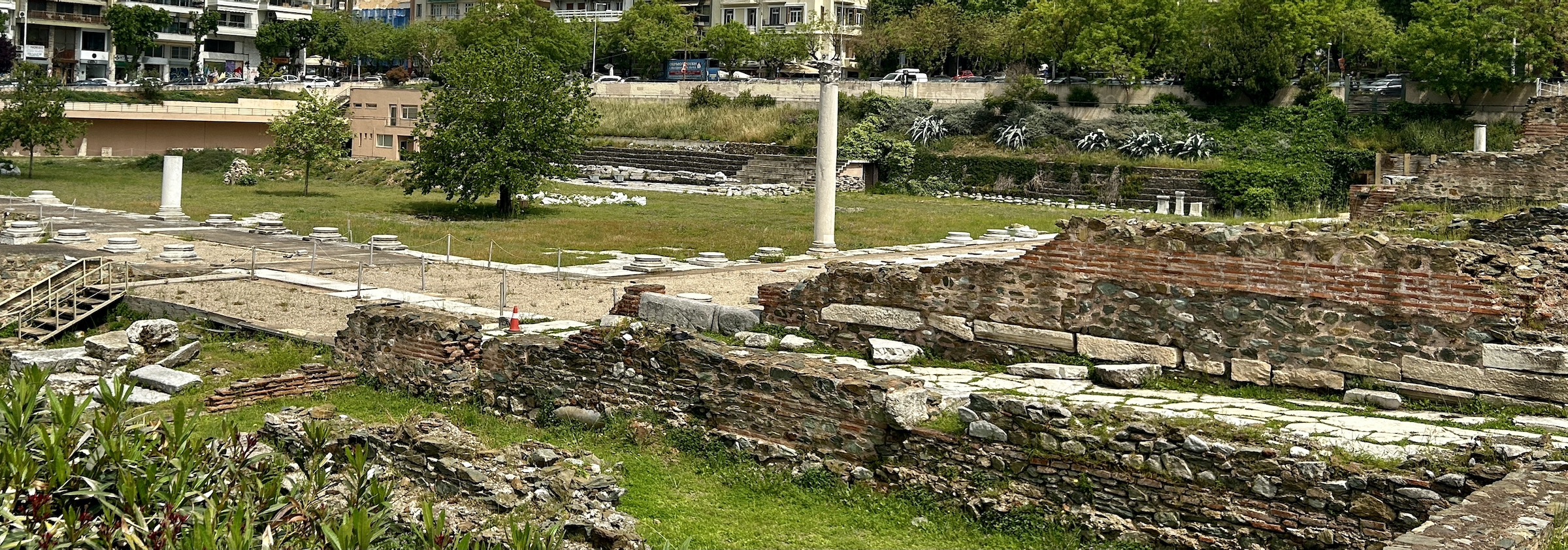
A closer look reveals the remains of many old commercial shops.
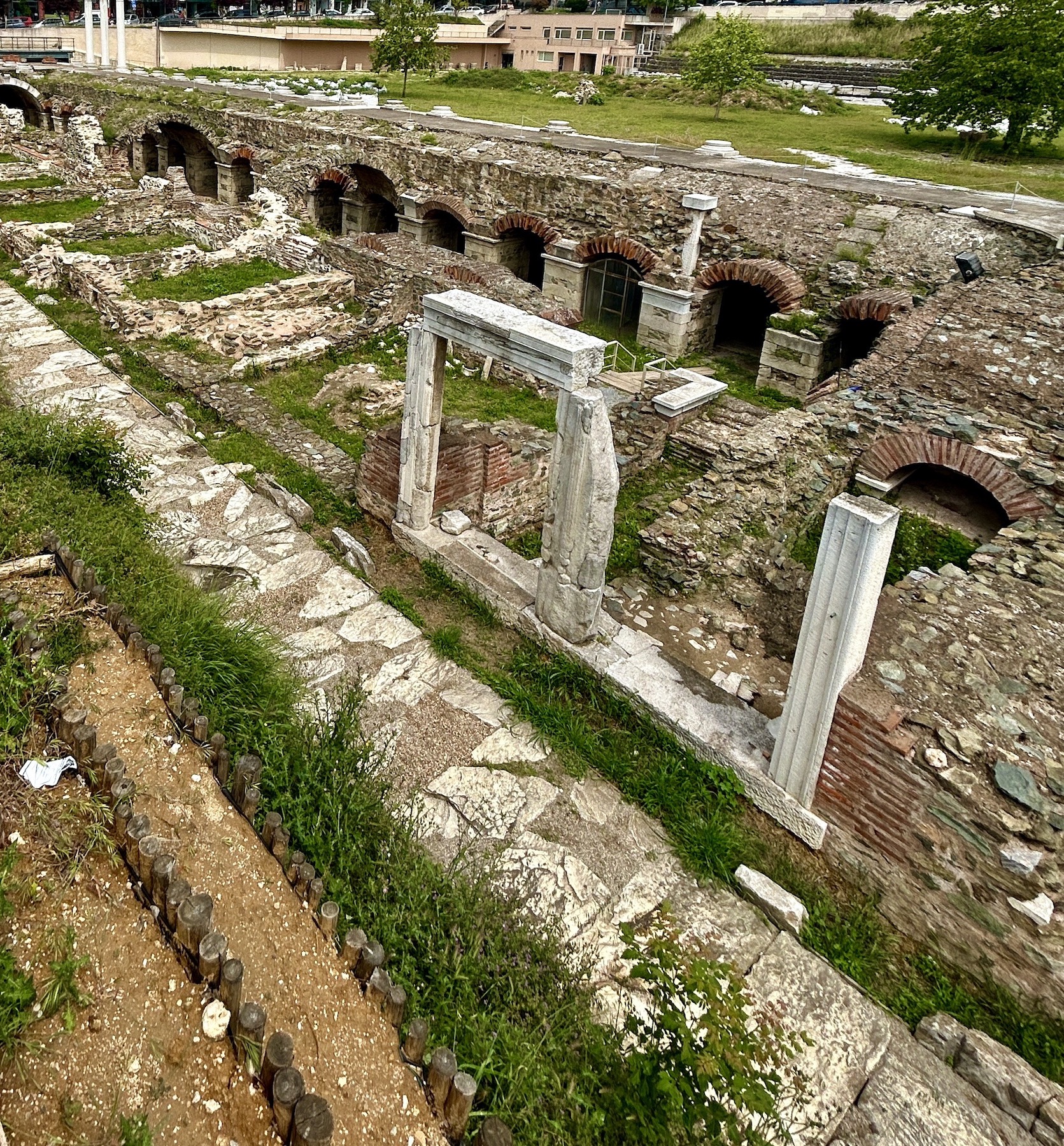
And what I at first mistook for a communal shitter, but was disabused by Nikos. It’s actually an ancient steam bath.
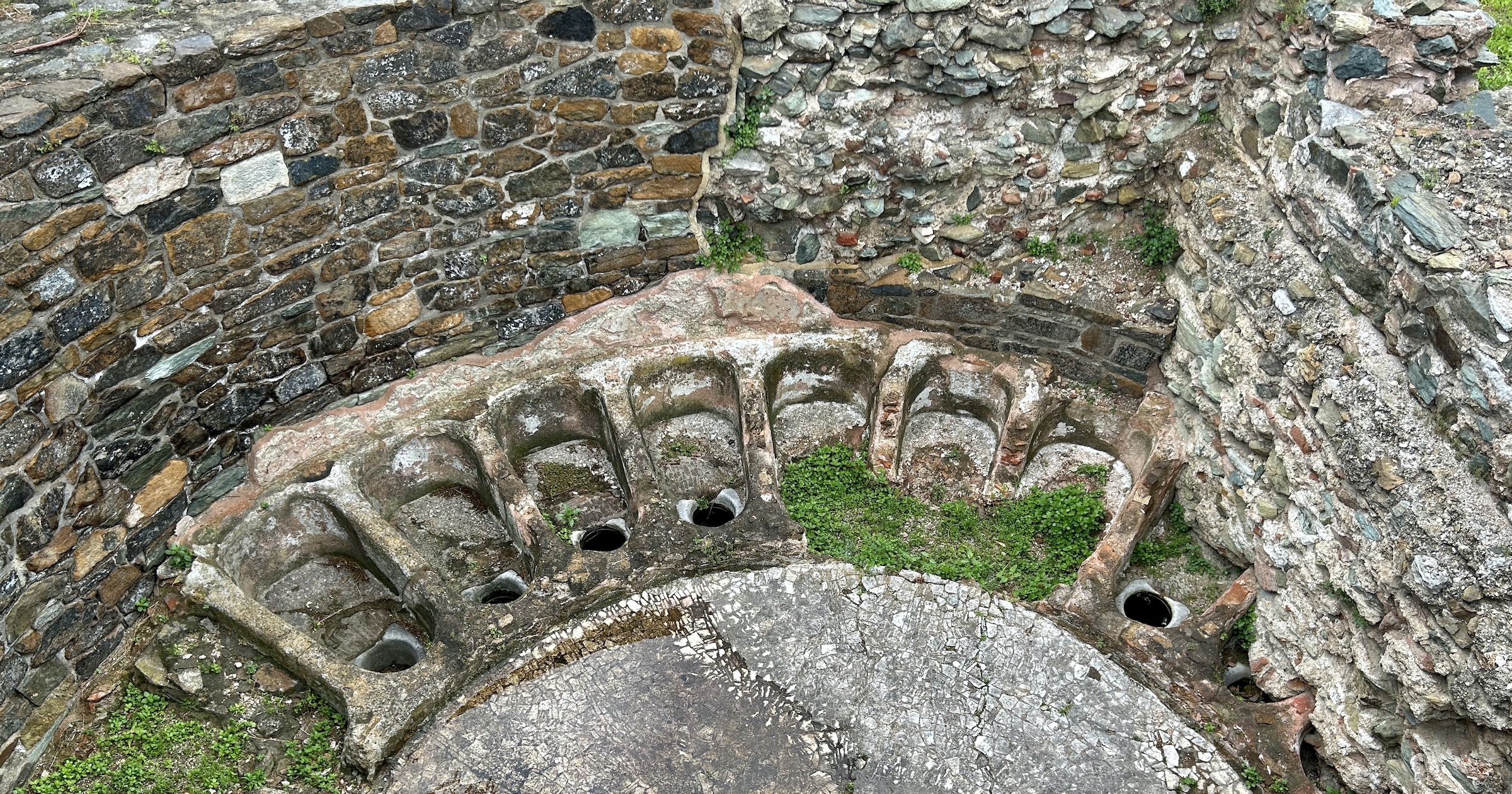
The Byzantine Churches
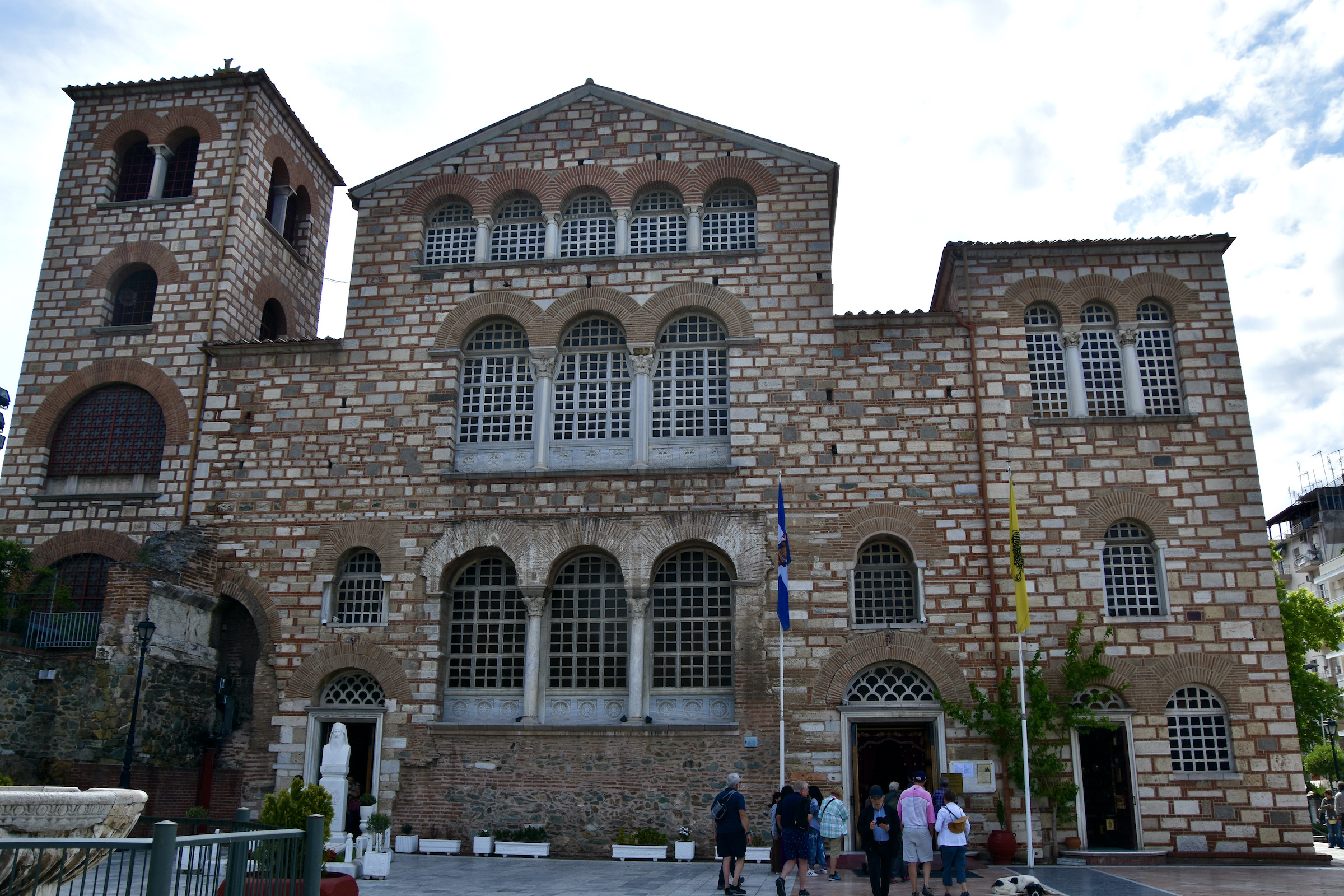
I mentioned that St. Demetrius is the patron saint of Thessaloniki and this is the church dedicated to him and the most important of a number of Byzantine churches in the city. The first church was built on this site in the 4th century on the site of a Roman bath where St. Demetrius was executed and buried. The foundations of the present church date back to one constructed in 629-634 and it has largely looked like this from that time. However, much it was destroyed in the great fire of 1917 and it wasn’t until 1949 that it was reconsecrated. That is why, despite its age, parts of it look almost new. As with the Rotunda, it became a mosque for a substantial period of time during which most of the original mosaics and frescoes were destroyed. Today it is one of the most important churches in the Greek Orthodox church and a site of pilgrimage to the tomb of St. Demetrius. It is said to be the largest church in Greece. Here is the interior.

And the apse with the archangels Michael and Gabriel venerating the mother and child.

This is the coffin of St. Demetrius and for once they might actually contain the saint’s bones given the short passage of time between his execution and the conversion of the city to Christianity. St. Demetrius is known as the ‘Myrrhgusher’ because there have been miraculous events associated with him that include clouds of an oily substance identified as myrrh surrounding his body and the entire church interior at various times. The last outbreak of myrrh gushing took place in 1987 and is described in detail in this link.
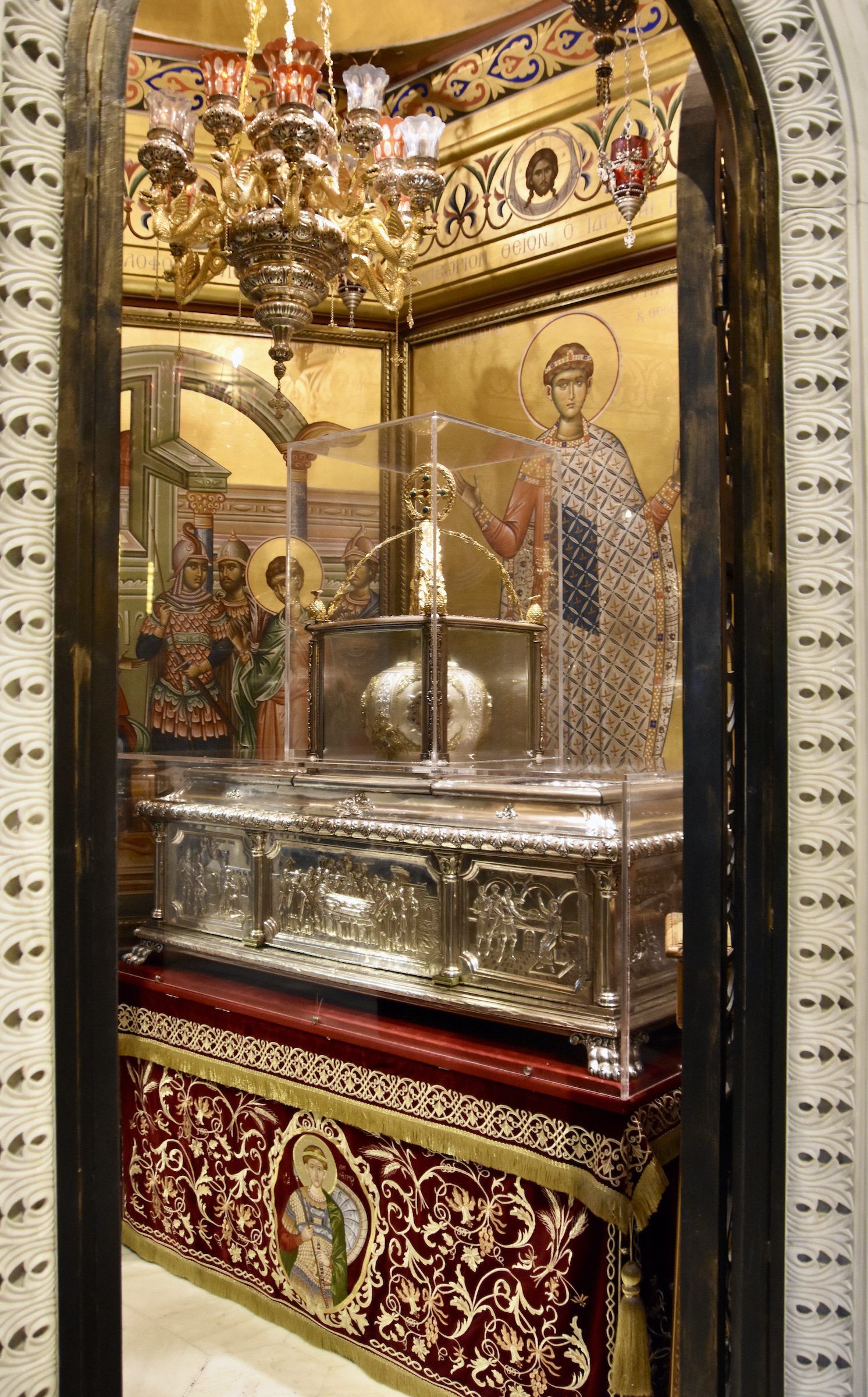
Even more revered than the saint’s body is the sacred well into which the deceased saint’s body was shoved after his execution. It too is a site where miracles are alleged to have happened. While I don’t put much stock in these claims, I have to say there was some type of mystical aura about this area of the church that was almost palpable.
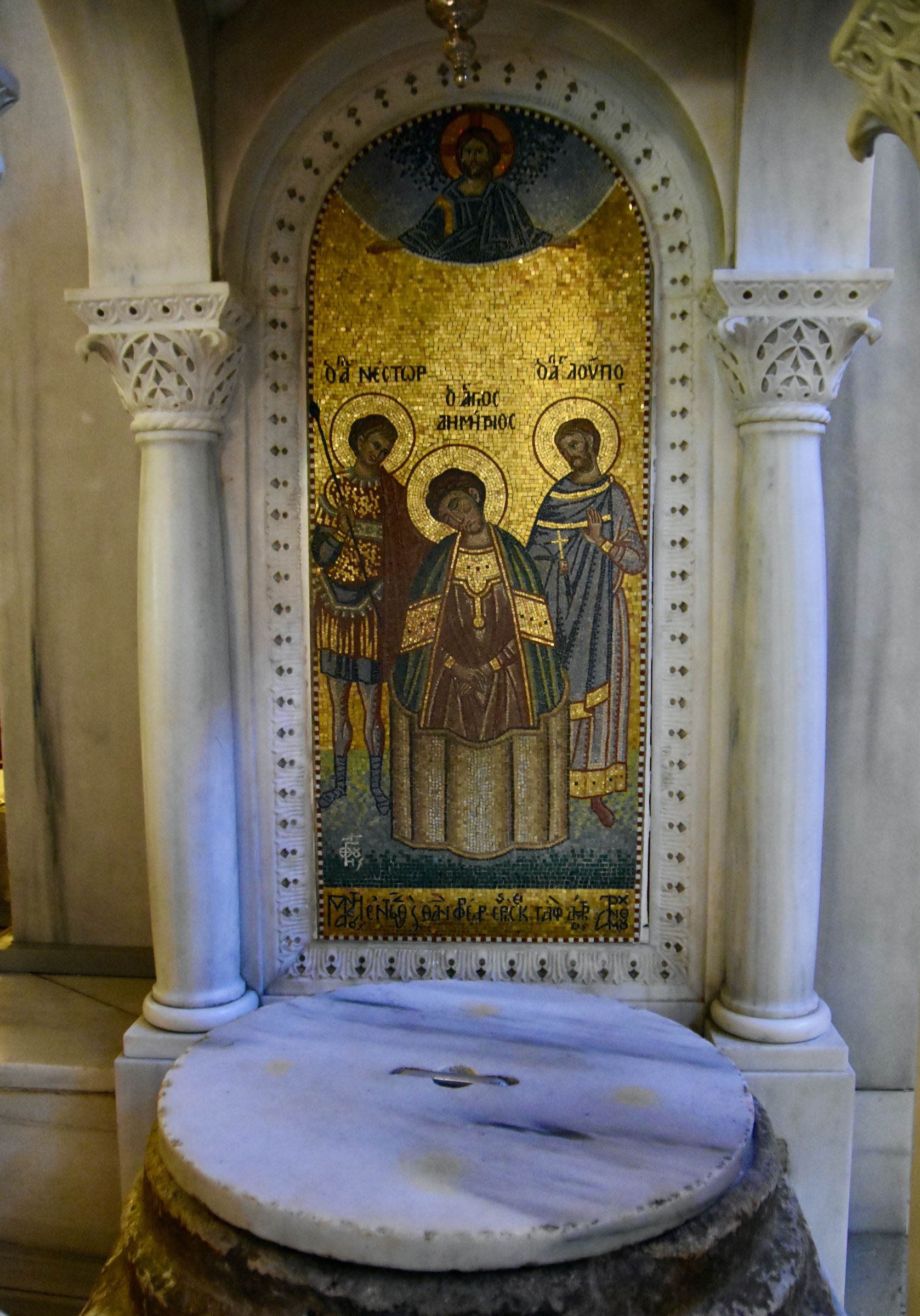
We did visit a second church in the old part of Thessaloniki, the much smaller Church of St. George which also dates back to the early Byzantine era. It has a few mosaics that have survived the inevitable transition from church to mosque including this 6th century one that depicts birds and plants. Perhaps because it doesn’t depict God or other actual human figures it was spared.
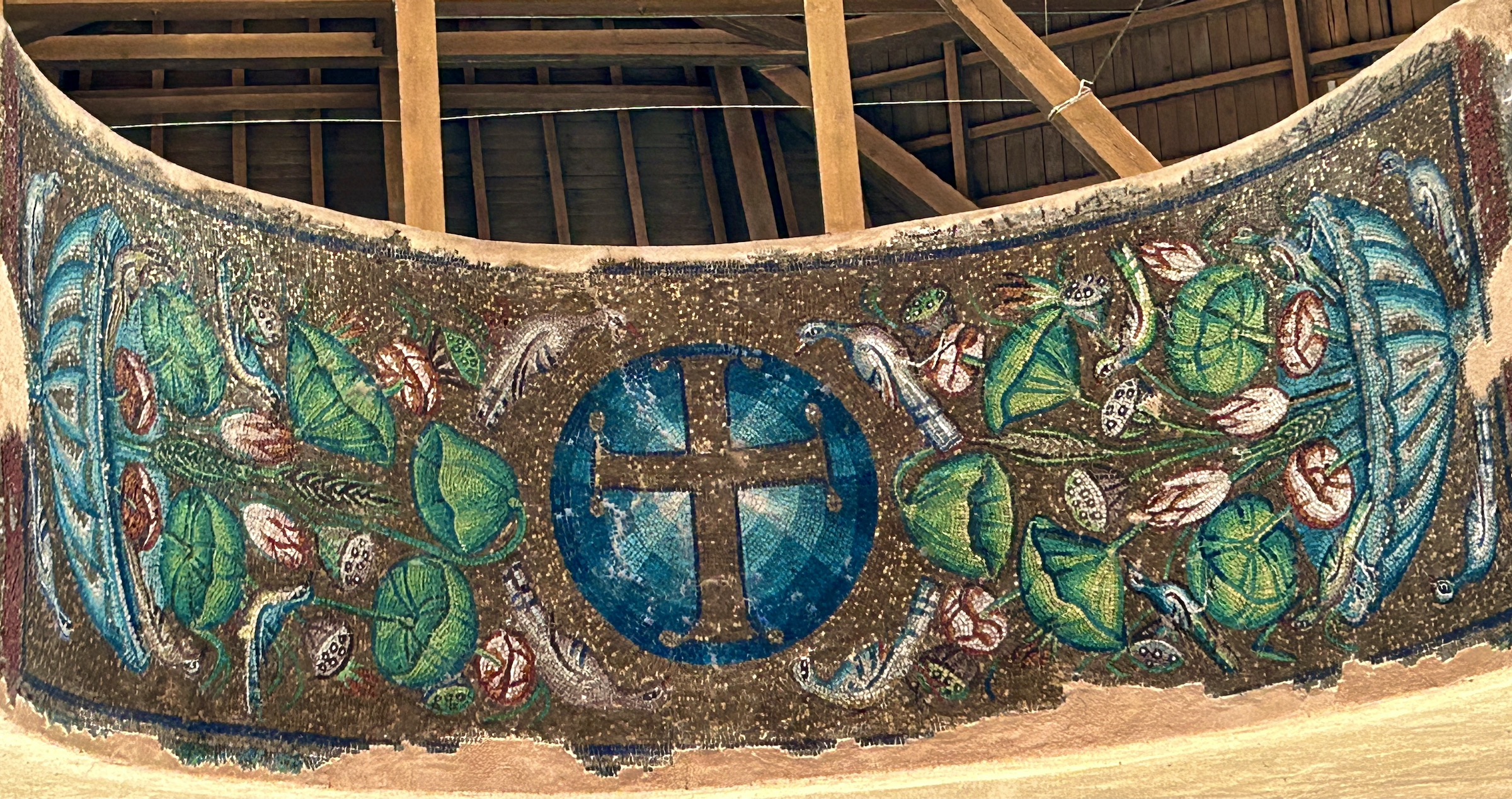
Ano Poli – Upper Thessaloniki
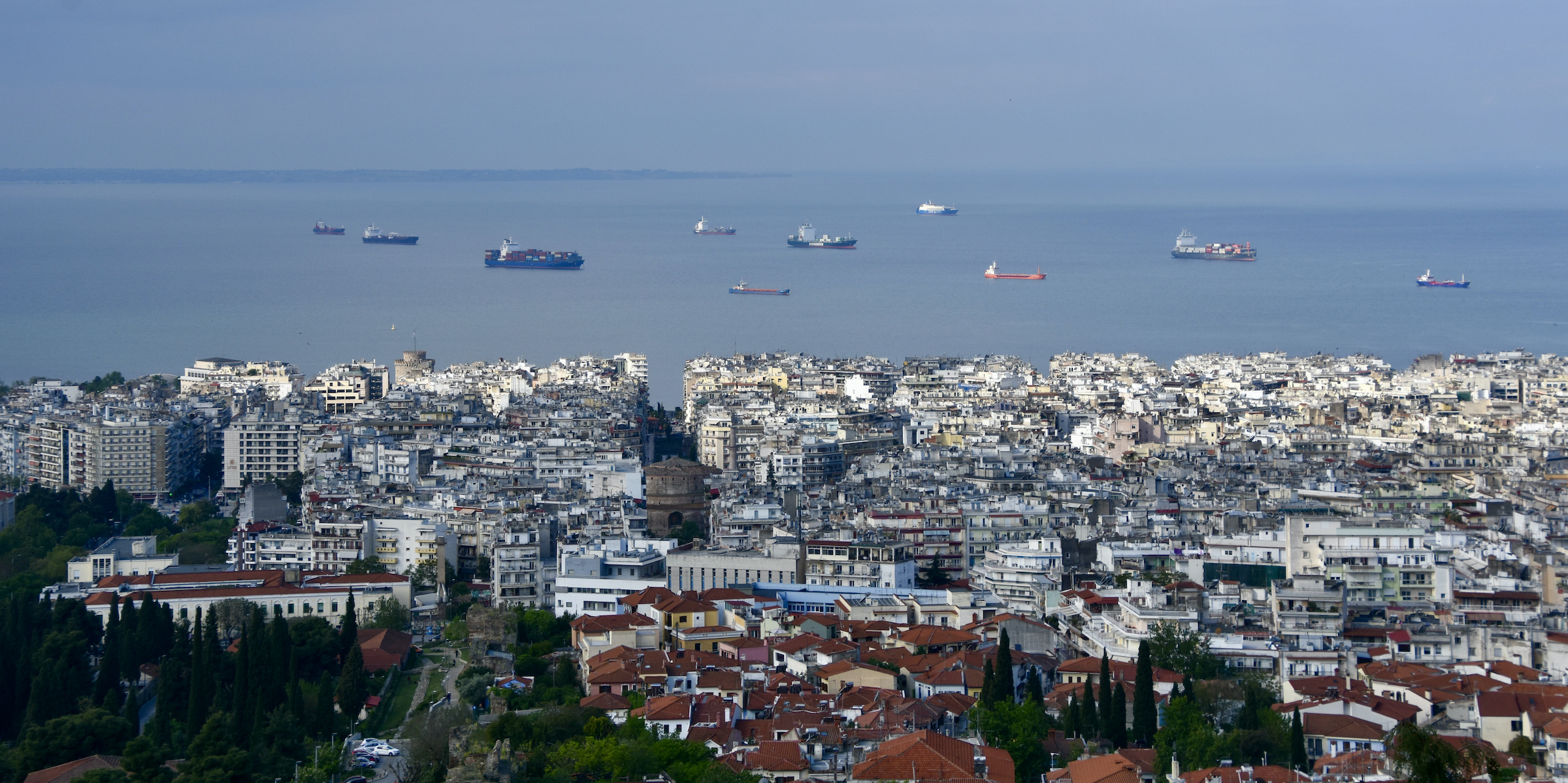
We are now going to explore the higher parts of Thessaloniki which have almost as much to see as the city centre, including this great view of the harbour below. Notice the Rotunda and the clear space in front of it running down to the waterfront. This is where much of the Palace of Galerius once stood.
This area is known as Ano Poli and is where the ancient acropolis once stood, making it the oldest part of Thessaloniki. It survived the 1917 fire largely intact and if you want to get a picture of what the Byzantine and Ottoman city looked like this is where to find it. This is where the Ottoman Turks resided, literally lording it over the Christians and Jews who lived below them.
As noted, most of the city walls were torn down in the 19th century, but not the portion that protected the northern side of the city. We are driven up here by taxi and will gradually make our way back down to city centre with a number of stops along the way.
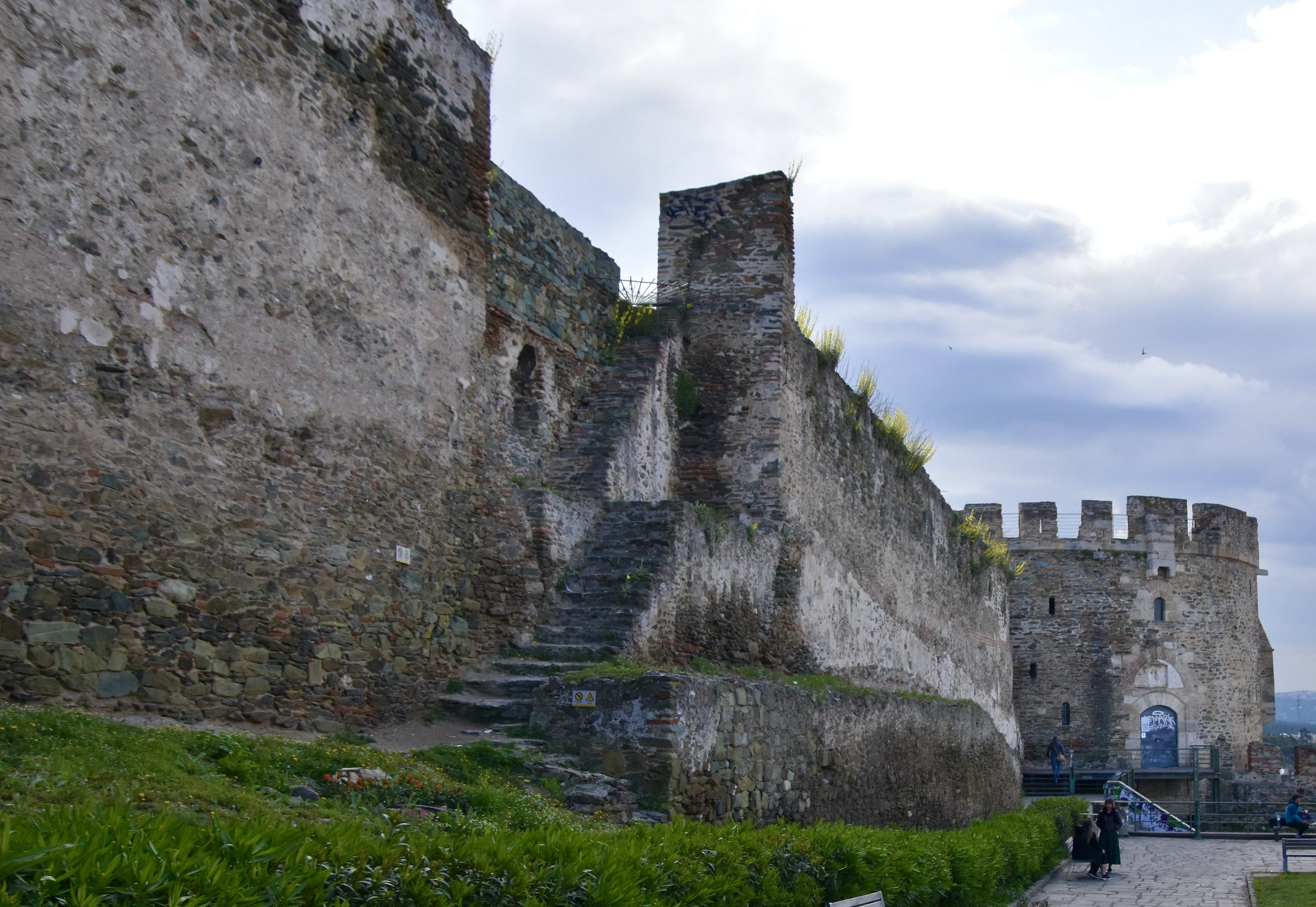
In terms of hustle and bustle, there are no tourists up here and we walk along the city walls in relative serenity coming to the gates of Vlatadanes Monastery which was one of the last Byzantine structures to be built. Built in the 14th it is still an active monastery and if you were here on your own you probably wouldn’t go in, but Nikos assures us that the monks don’t mind visitors.
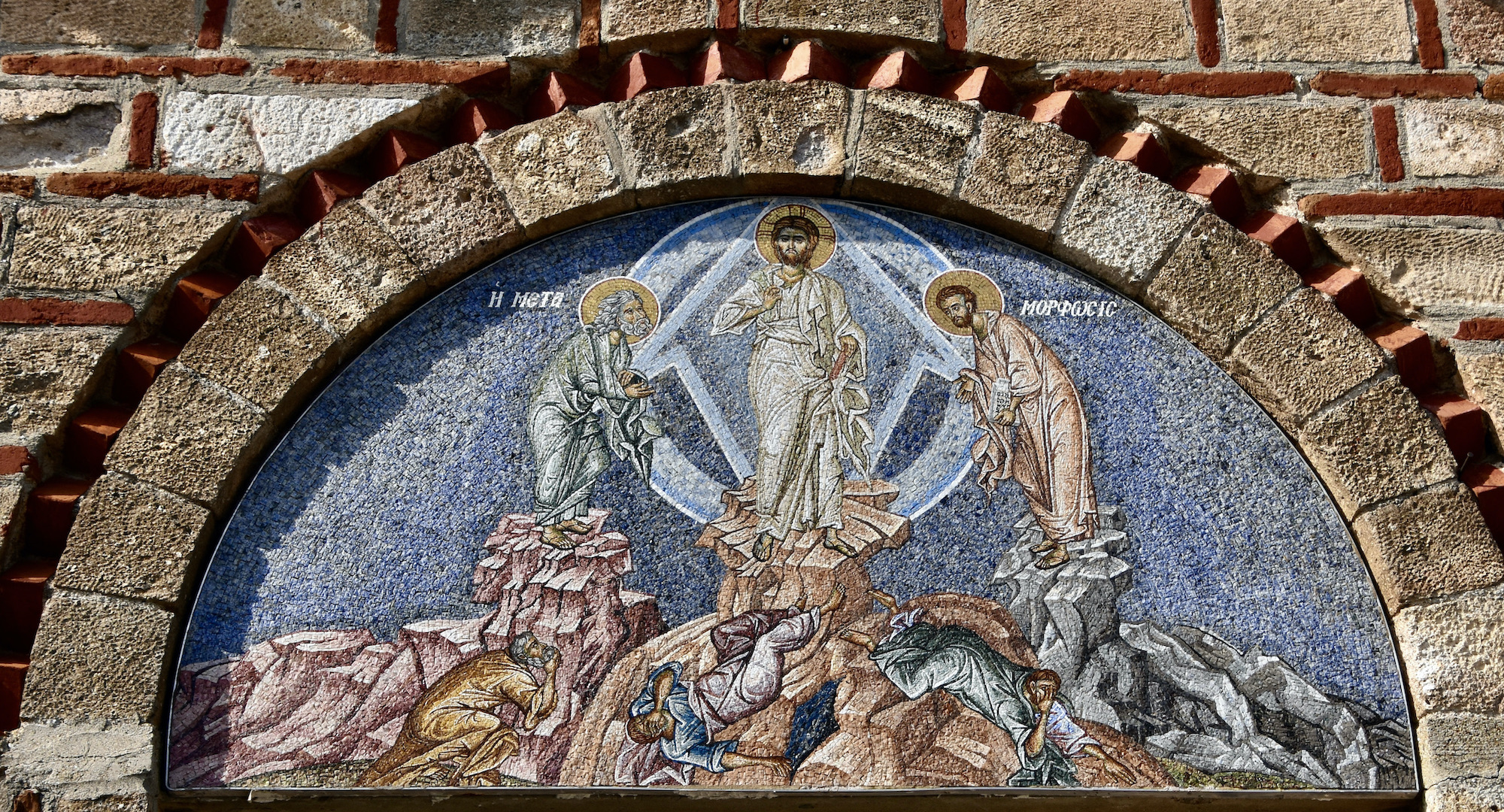
The monastery was built on the site where St. Paul is supposed to have escaped once again from angry Jewish and/or pagan mobs by disappearing into a tunnel that came out well below the hill top on which the monastery is located. Nikos points out a large church built on the site where St. Paul emerged and made good his escape. I’m starting to think that he was truly the Houdini of all saints.

The view from up here is a quite different panorama than from the city walls.
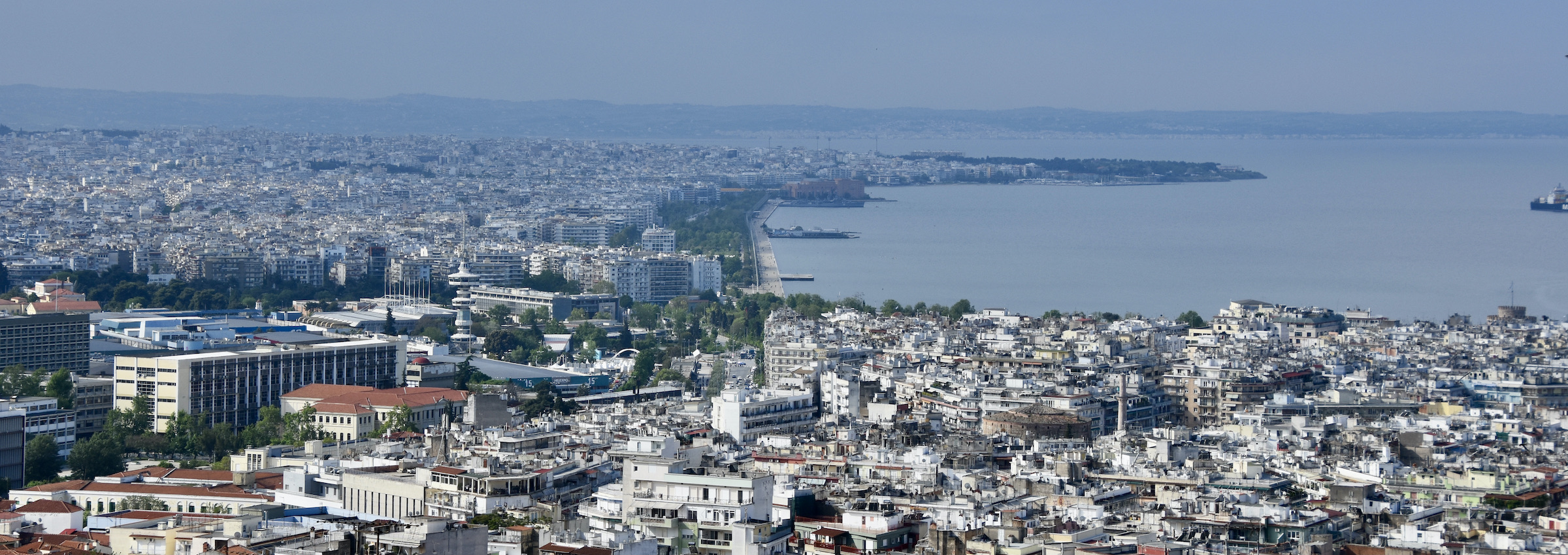
The actual church within the monastery is quite tiny compared to any other churches we’ve seen on this tour.
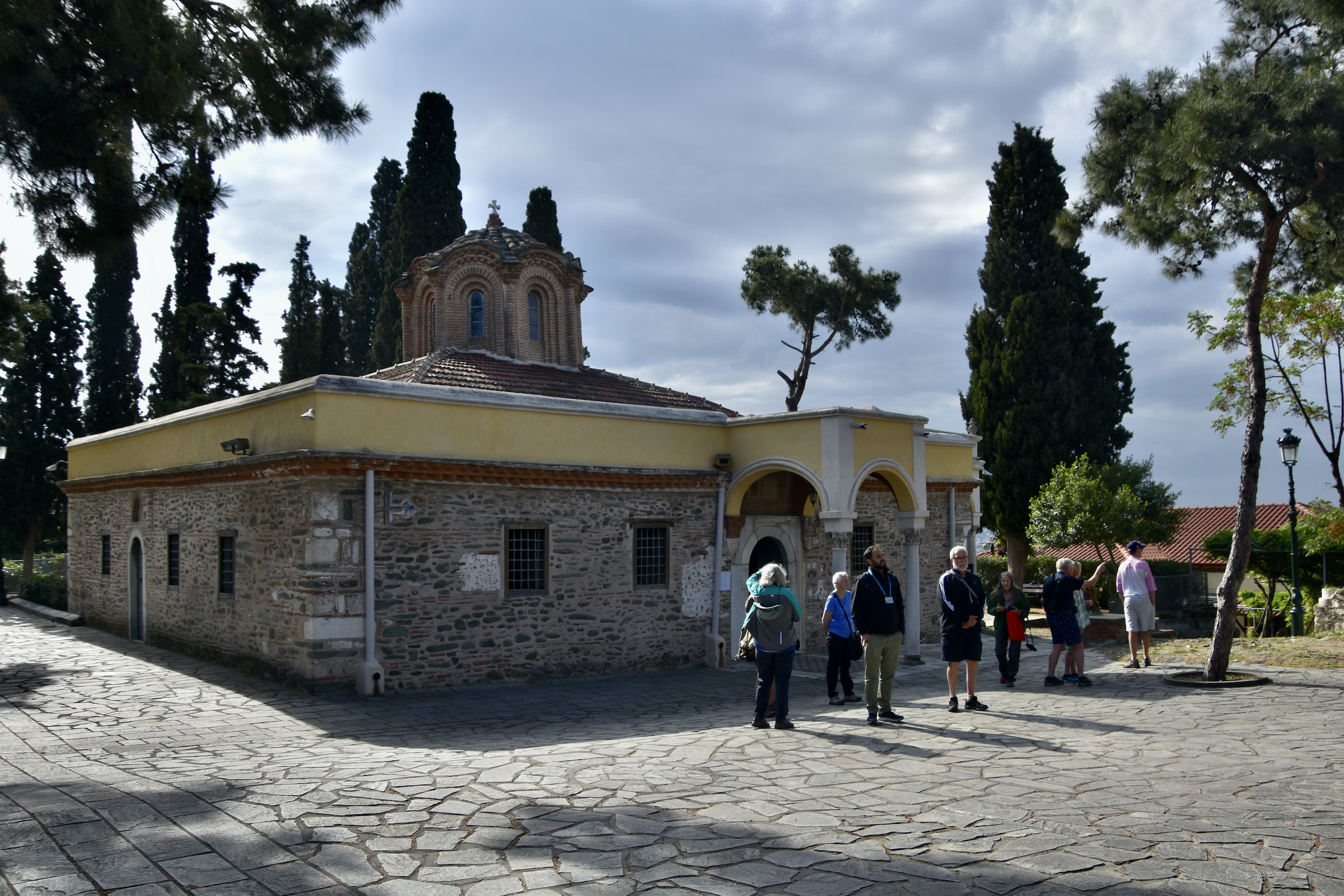
The interior is replete with many sacred icons.
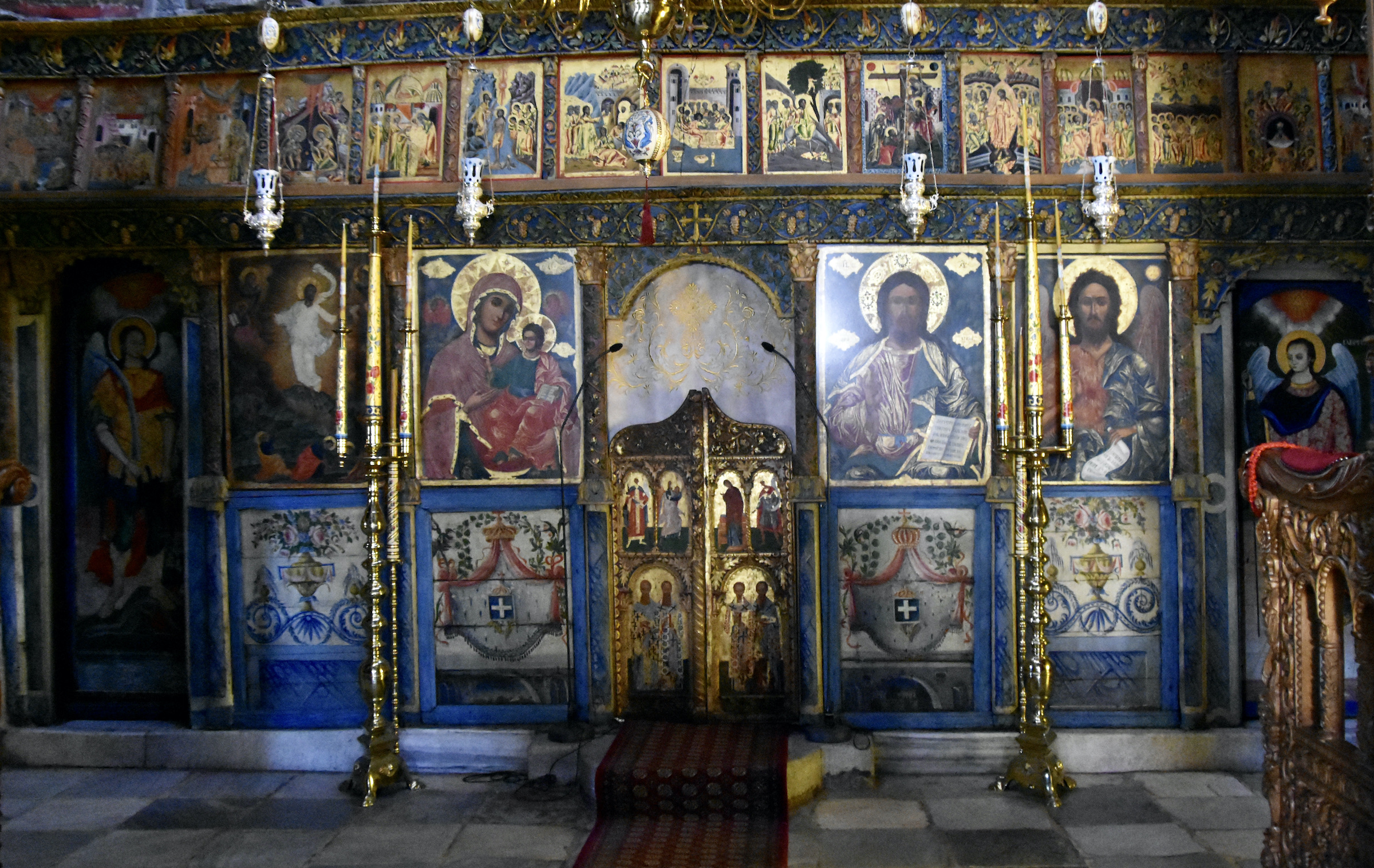
And evidence of Ottoman desecration.
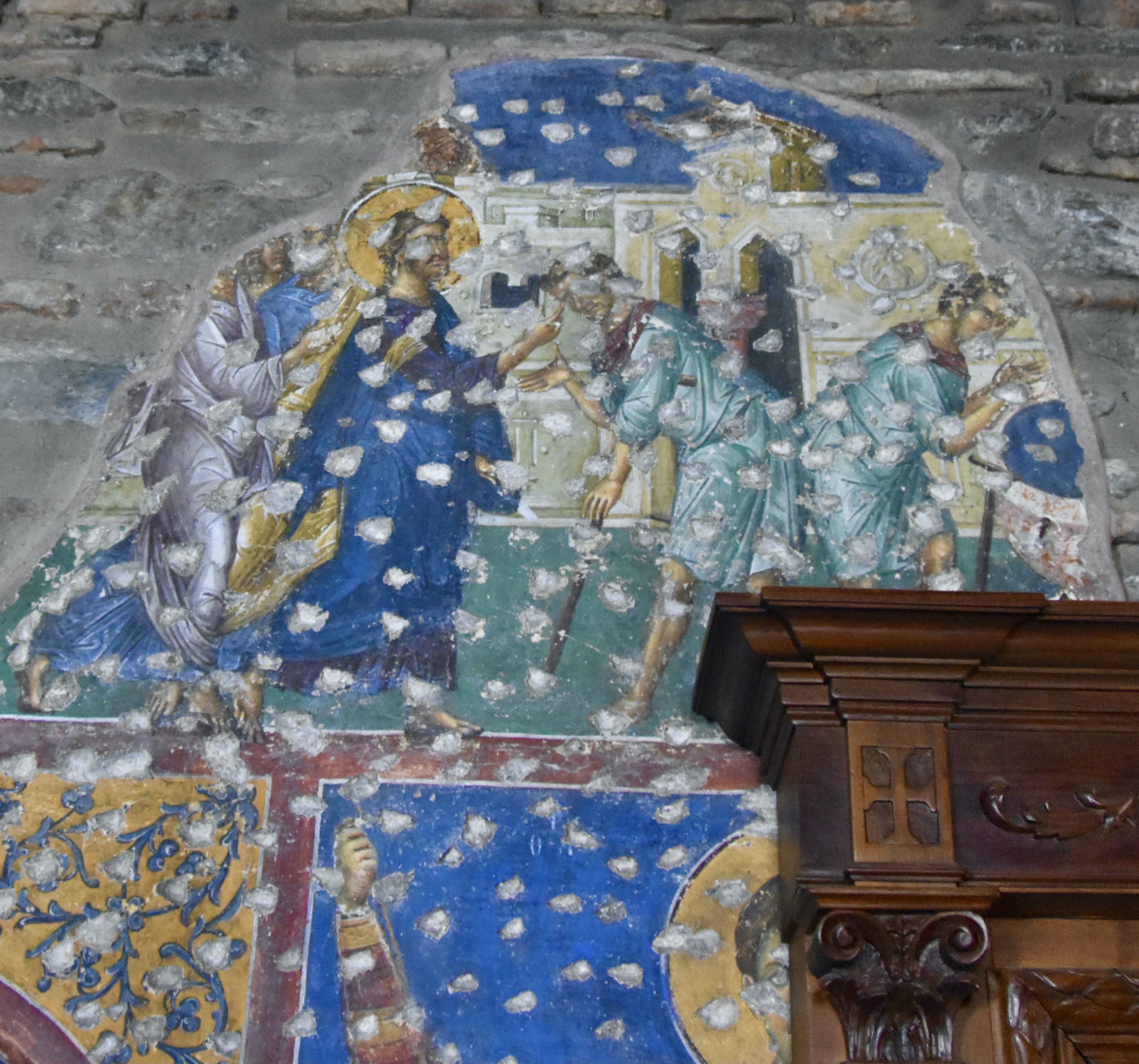
Oddly enough, during our stay here which was fairly lengthy as we explored the grounds, we never saw a single monk, although Nikos assured us they were around.
From Vlatadanes we entered a residential area with colourful Ottoman houses, narrow streets and few automobiles.
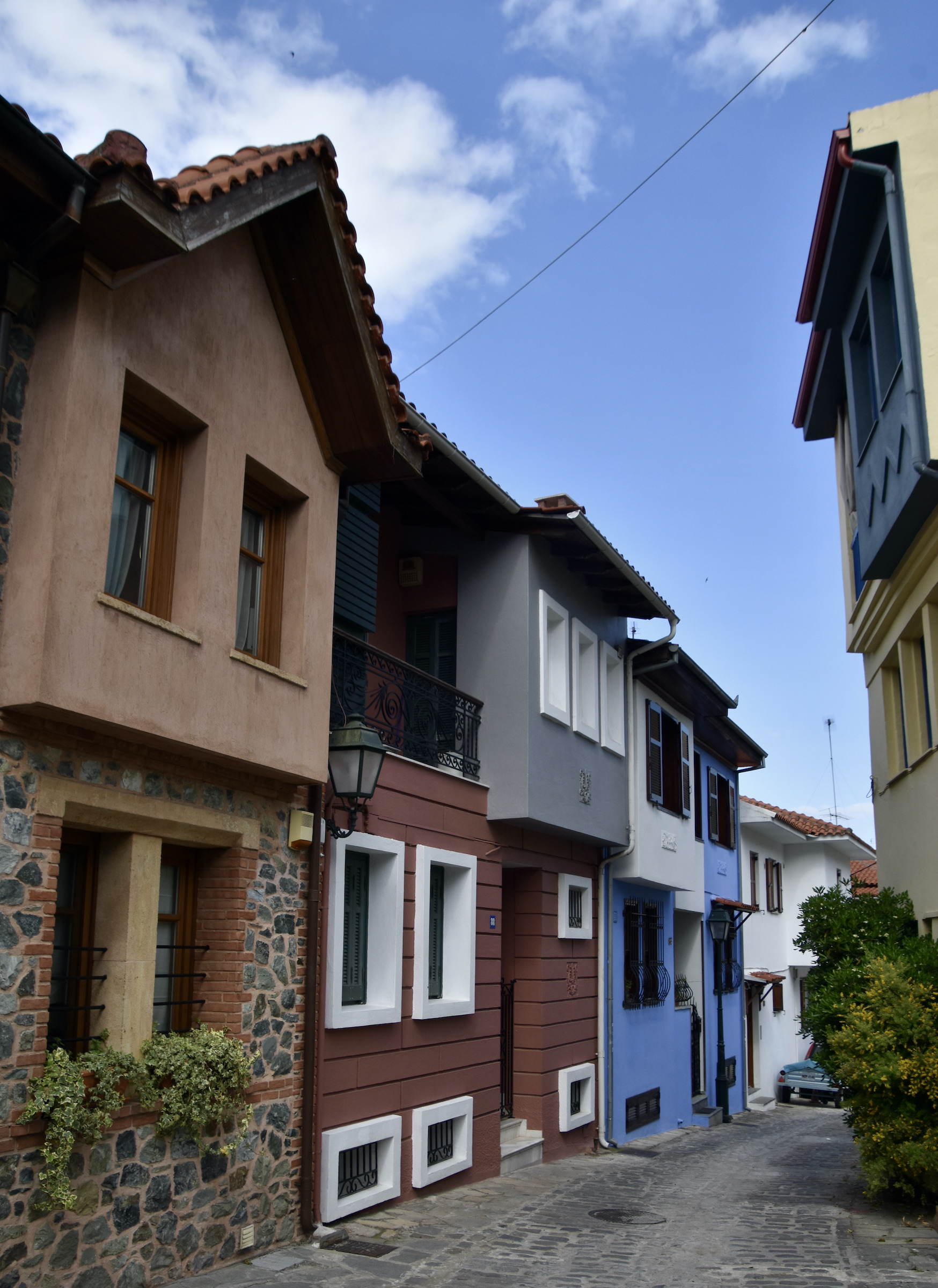
In places we could only get to the next level down by descending stairs rather than streets.
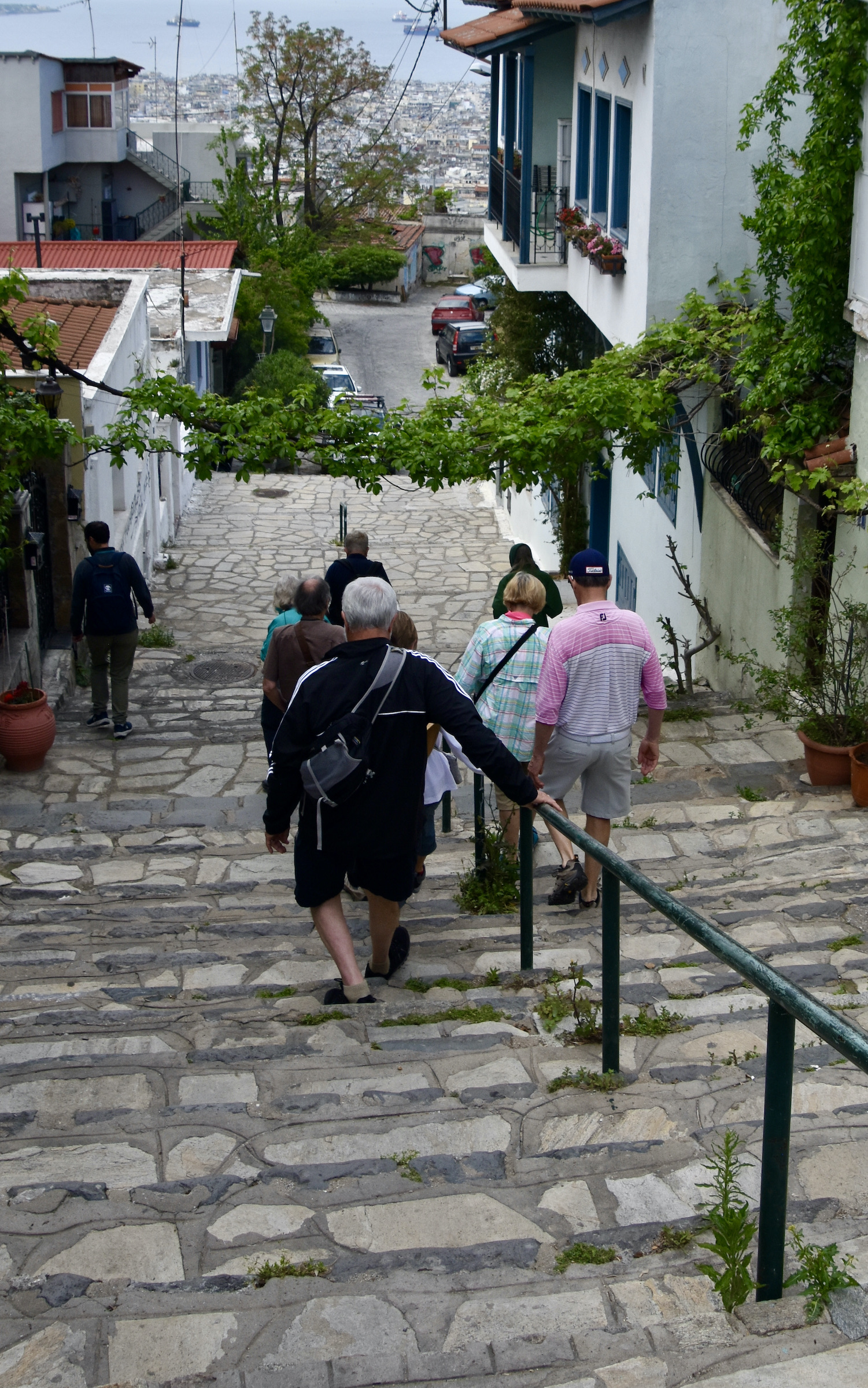
Down a narrow dead end lane Nikos led us to one of Thessaloniki’s hidden treasures, the minuscule Church of St. David or Hosios David as it is known in Greek. It is almost a thousand years older than the Vlatadanes Monastery, dating from the 5th century, making it the oldest of all the UNESCO inscribed Byzantine churches in Thessaloniki.
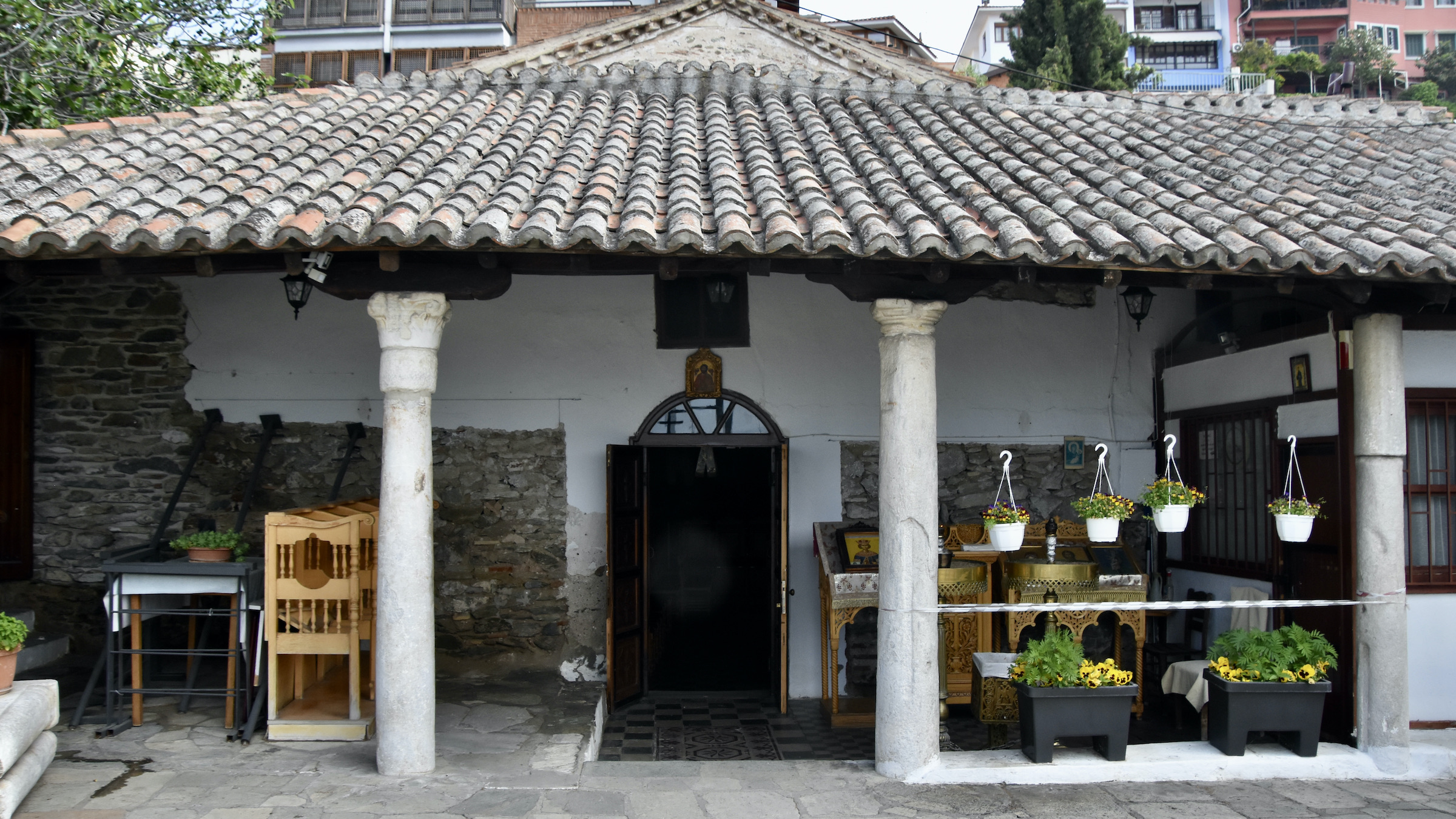
Two amazing and important items were plastered over by the Ottomans, rather than being defaced as we just saw at Vlatadanes Monastery. Only in 1921 were they rediscovered and gave us an insight into early Christian art that we would not otherwise have. This is the Icon of Christ of Latomos and it is considered to be one of the rarest of all Byzantine art works, an acheiropoieta. These are works that were created not by the hand of man, but by a miracle, or so the faithful believe. It’s provenance allegedly pre-dates the church itself and was found intact by the Christian daughter of the pagan emperor Maximian who had it hidden here until rediscovered many years later by an Egyptian monk who travelled to the spot as a result of a dream.
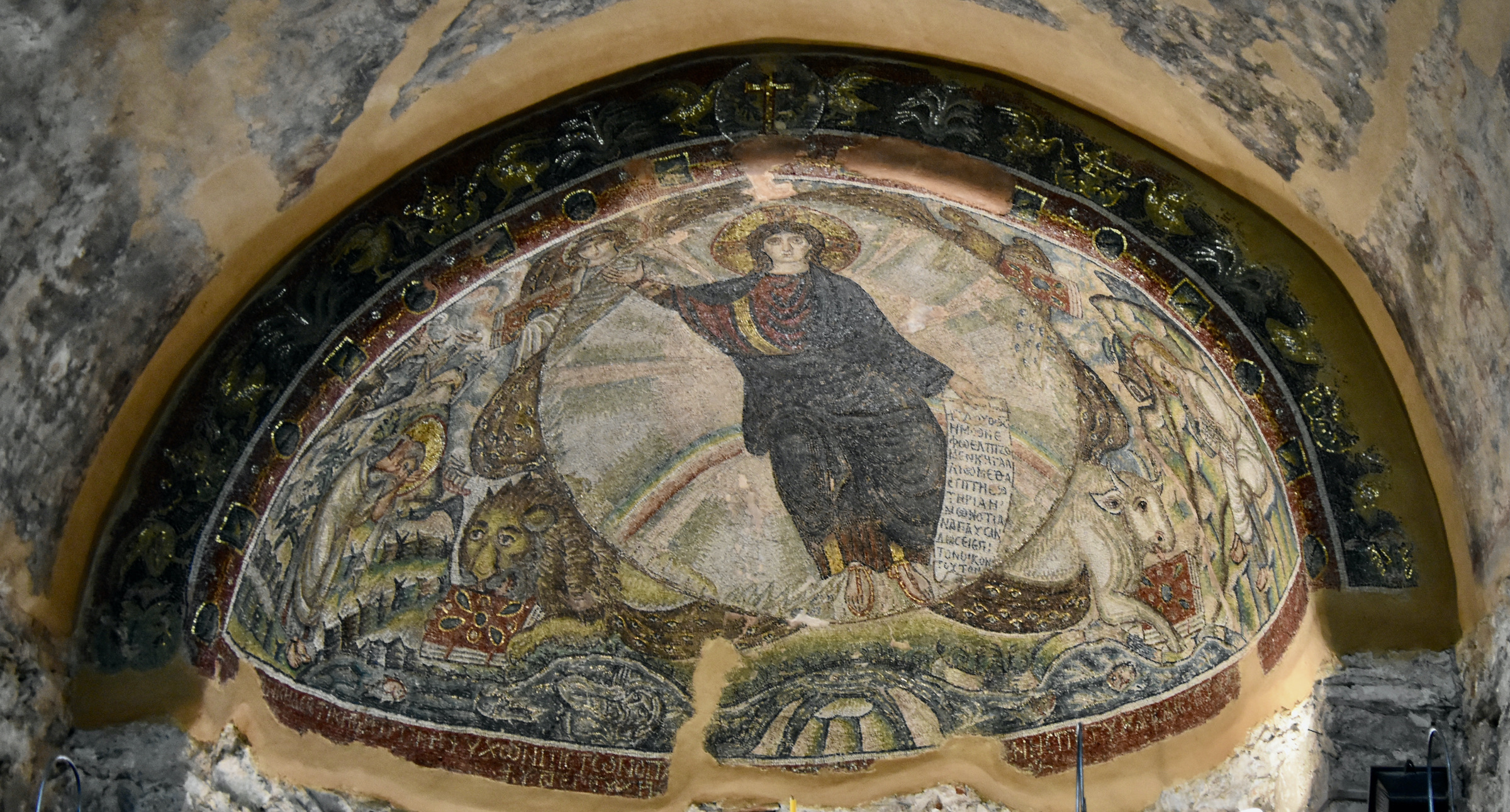
The scene depicts an apocalyptic scene from the Book of Ezekiel, but what’s really noteworthy is that Christ is depicted as a god like figure, showing the classical Greco/Roman influence on early Christian art. Remember the statue of Augustus in the Archaeological Museum? This is the same pose. I had never heard of an acheiropoeita before seeing this and it truly is one of the most wondrous works of art I’ve ever laid eyes upon. The secretive history and location only adds to its mysterious power. I won’t ruin the atmosphere by delving into how this was actually created – sometimes it’s best to just let miracles be miracles.
The other outstanding art work in Hosios David is a fresco showing the bathing of Jesus just after his birth. The large figure on the left is Joseph who seems to be in despair as he knows that he cannot be the father of this child. The figure holding the child is not Mary, but rather the midwife Salome. These and other frescoes in the church date from much later than the mosaic and are very impressive in their depiction of scenes you don’t often see in Western Christian art.
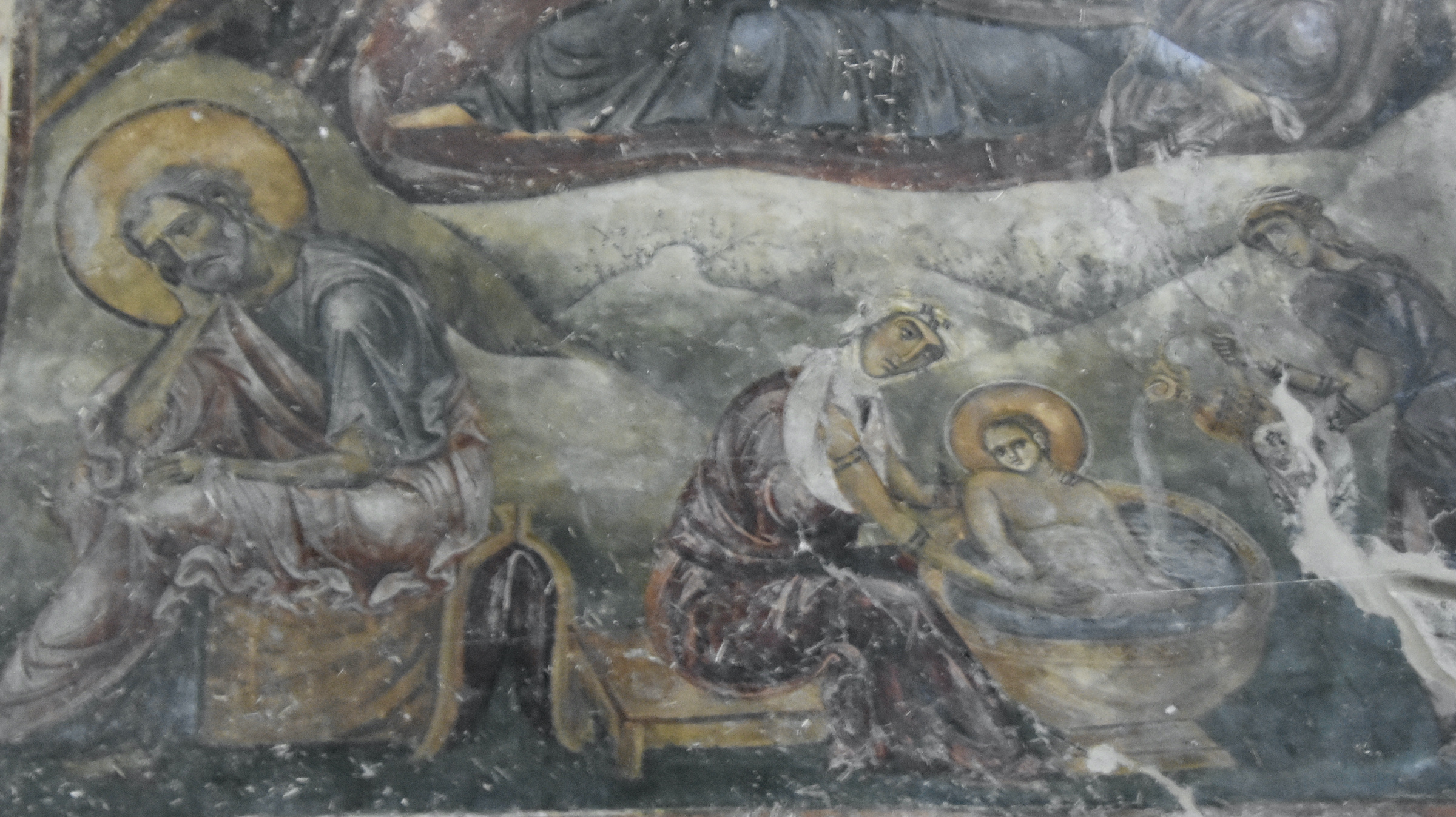
From Hosios David we continued to wend our way downward passing some interesting things along the way including this mother hedgehog carrying her baby in her mouth to avoid an all to curious cat.
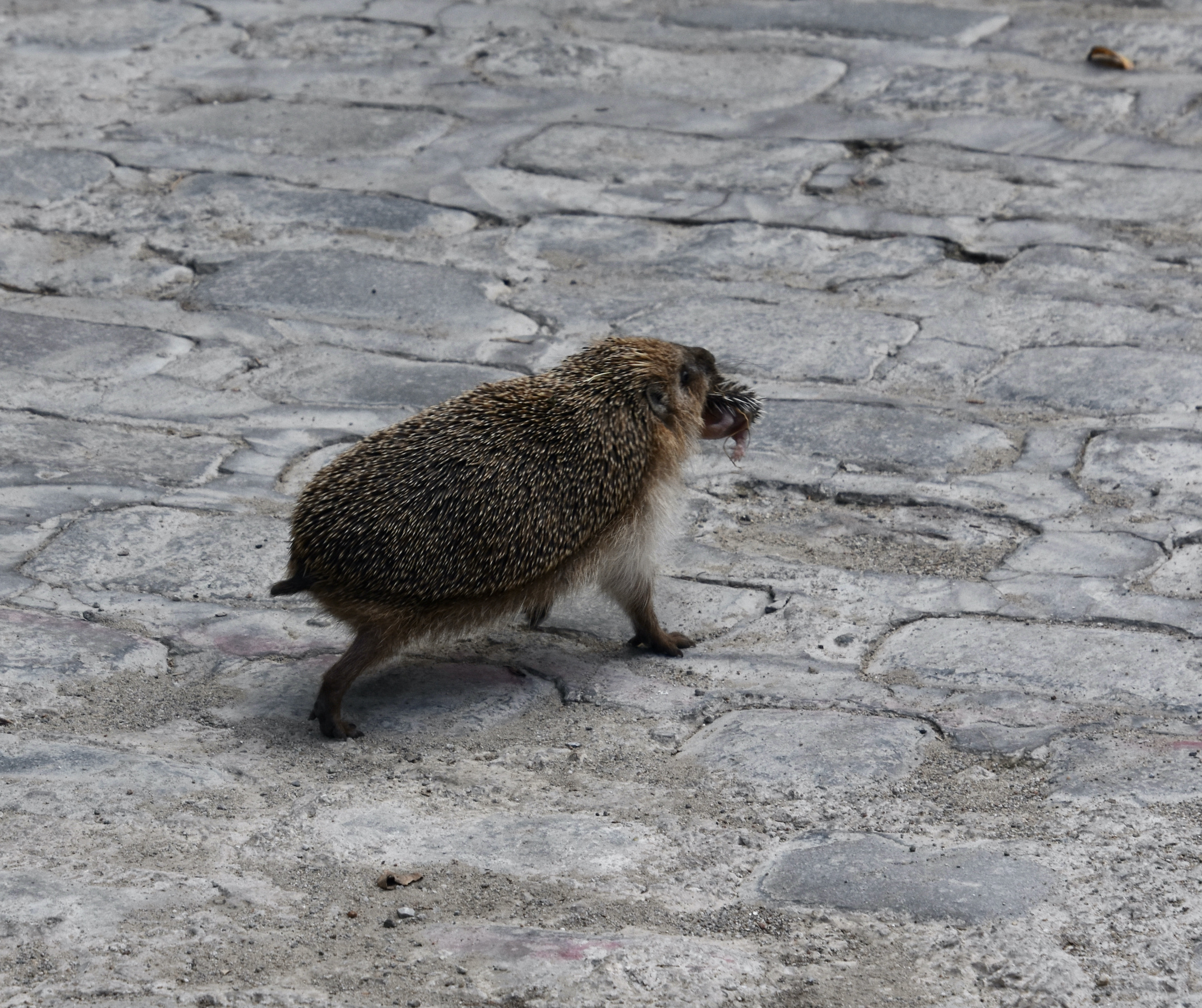
And this all too explicit piece of graffiti.

Aside from this last scene, the visit to Ano Poli showed us a completely different side of Thessaloniki and one that few tourists get to see. I don’t think any visit to the city would be complete without seeing it.
Back in the lower part of the city we had some free time which Alison and I took to explore the Kapani market which straddles a number of streets and includes a fairly new indoor arcade. We never miss the opportunity to visit a city’s market area and Kapani did not disappoint. In fact, I found it much more interesting than its counterpart in Athens which we visited after Via Egnatia tour was over.
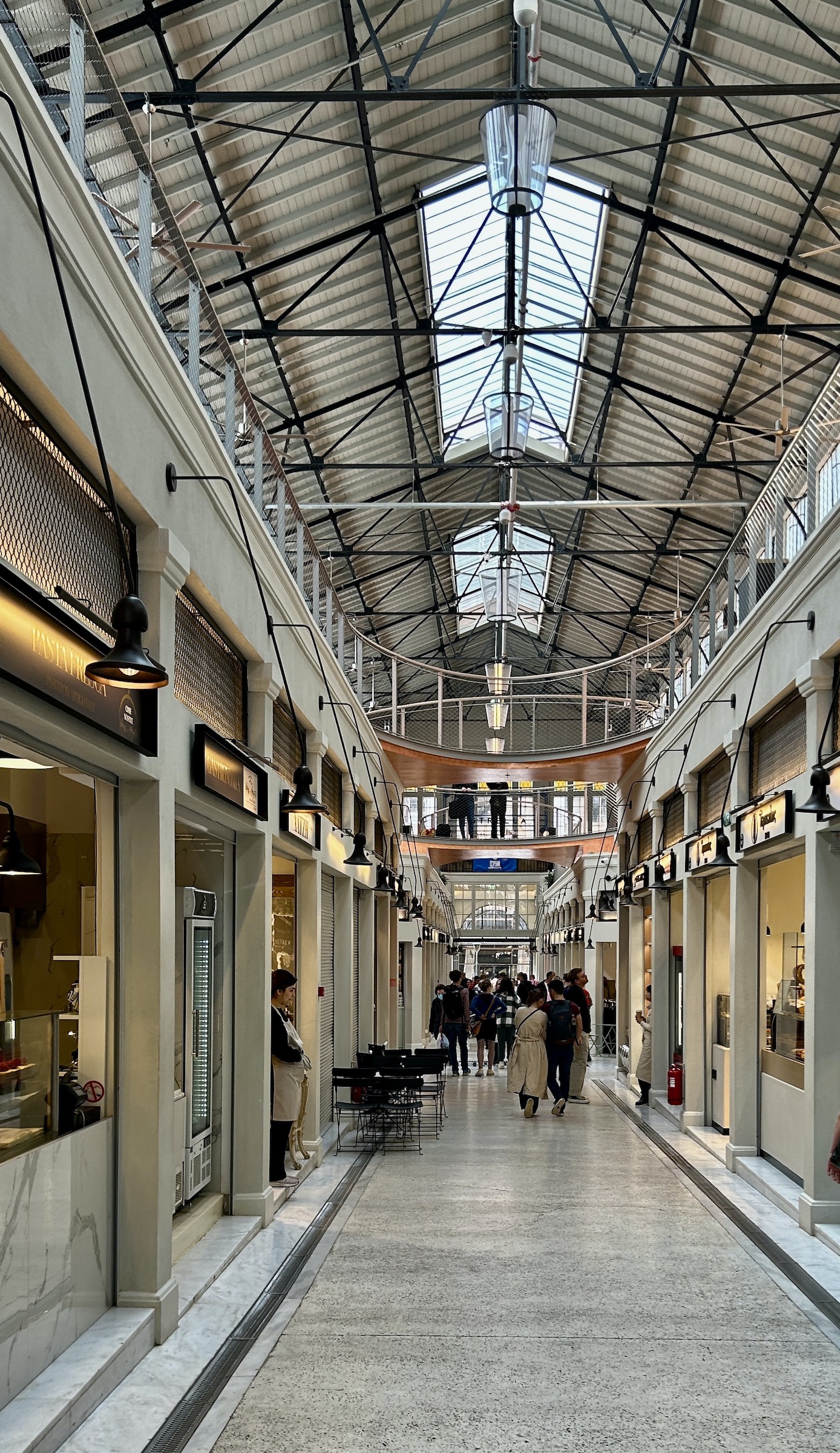
Here is a small gallery of some of the more interesting sites.
- Ice Cream Made from Olive Oil
- Olives for Sale
- Ouzo For Sale
- Crunchies for Sale
- All Types of Fish
- Basil for Sale
We also paid a visit to Aristotle whose birthplace we passed on the way to Thessaloniki. He is seated in the square named after him which was created during the rebuilding of Thessaloniki after the Great Fire of 1917. You can see his feet are well polished from people thanking him for his great contributions to mankind.

Our final stop on the official Via Egnatia itinerary was to the Jewish Museum of Thessaloniki which was opened in 2001 and seeks to preserve as much as possible of what remains of the 2,000 year Jewish heritage of the city.
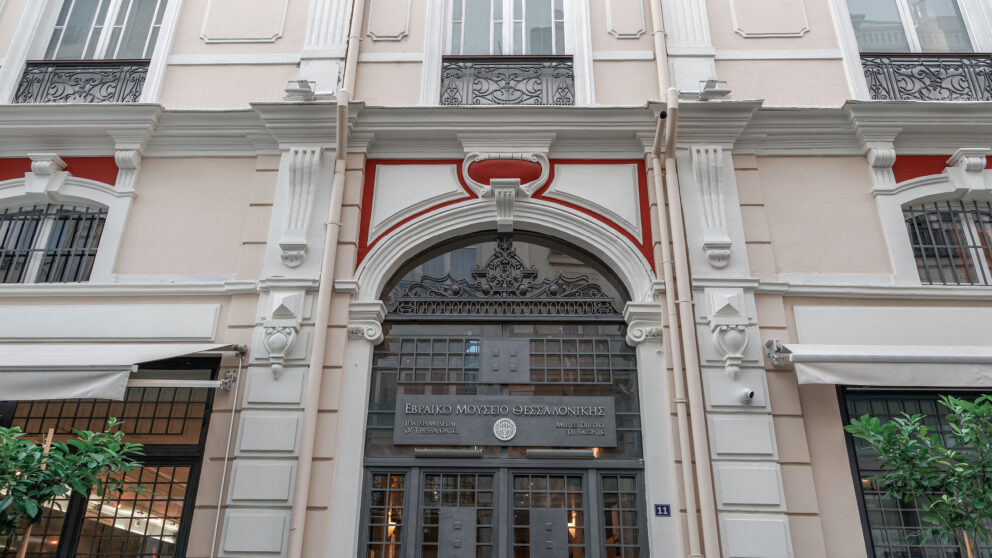
There is no photography allowed inside so I have no photos, but I can state that, although it is a somber experience, it is one worth undertaking. With the word ‘genocide’ thrown around so frequently and flippantly these days, it is sobering to see what a true genocide looked like. Hopefully it was the last of the massacres that have plagued this wonderful city for millennia.
There were still two places Alison and I wanted to see in Thessaloniki as did Victor.
Kemal Ataturk Birthplace
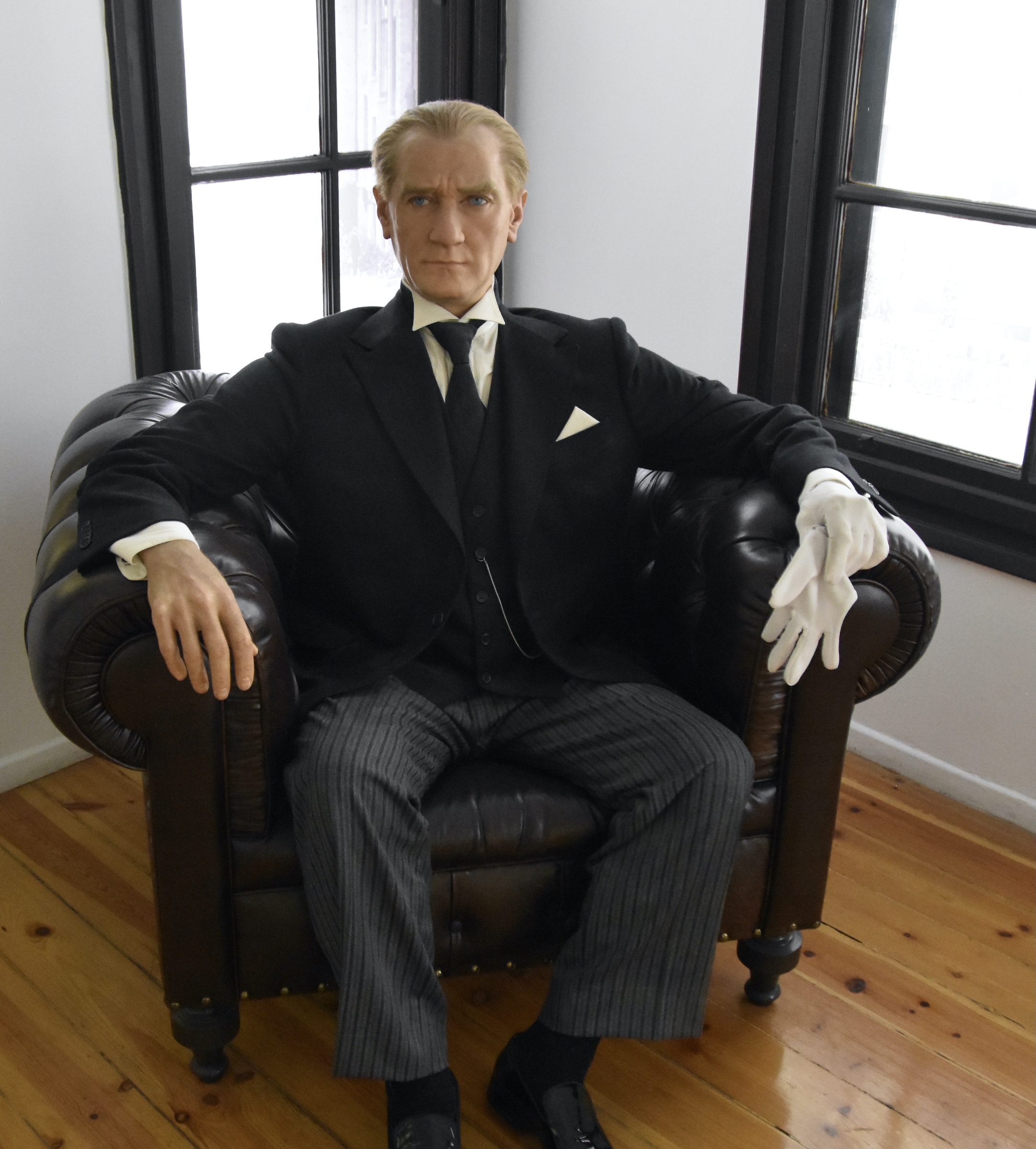
I have long been an admirer of Kemal Ataturk, the founder of modern Turkey and the man who almost single handedly dragged that country into the 20th century. Admirer is probably not the right word, because he certainly did things during the course of the Turkish War of Independence that were anything but. However, he was not the one who perpetrated the well known Armenian genocide (there’s that word again) which occurred before he took power.
In visits to Turkey prior to this trip I have visited and written about his role as the victor of Gallipoli and his mausoleum in Ankara.
Despite his name meaning ‘father of the Turks’, he was not born in Turkey, but rather right here in Thessaloniki. His ancestral home is now a museum and after some difficulty finding the entrance, Victor, Linda, Alison and I got in. The house is that of a well to do Ottoman family in the upper part of the city.
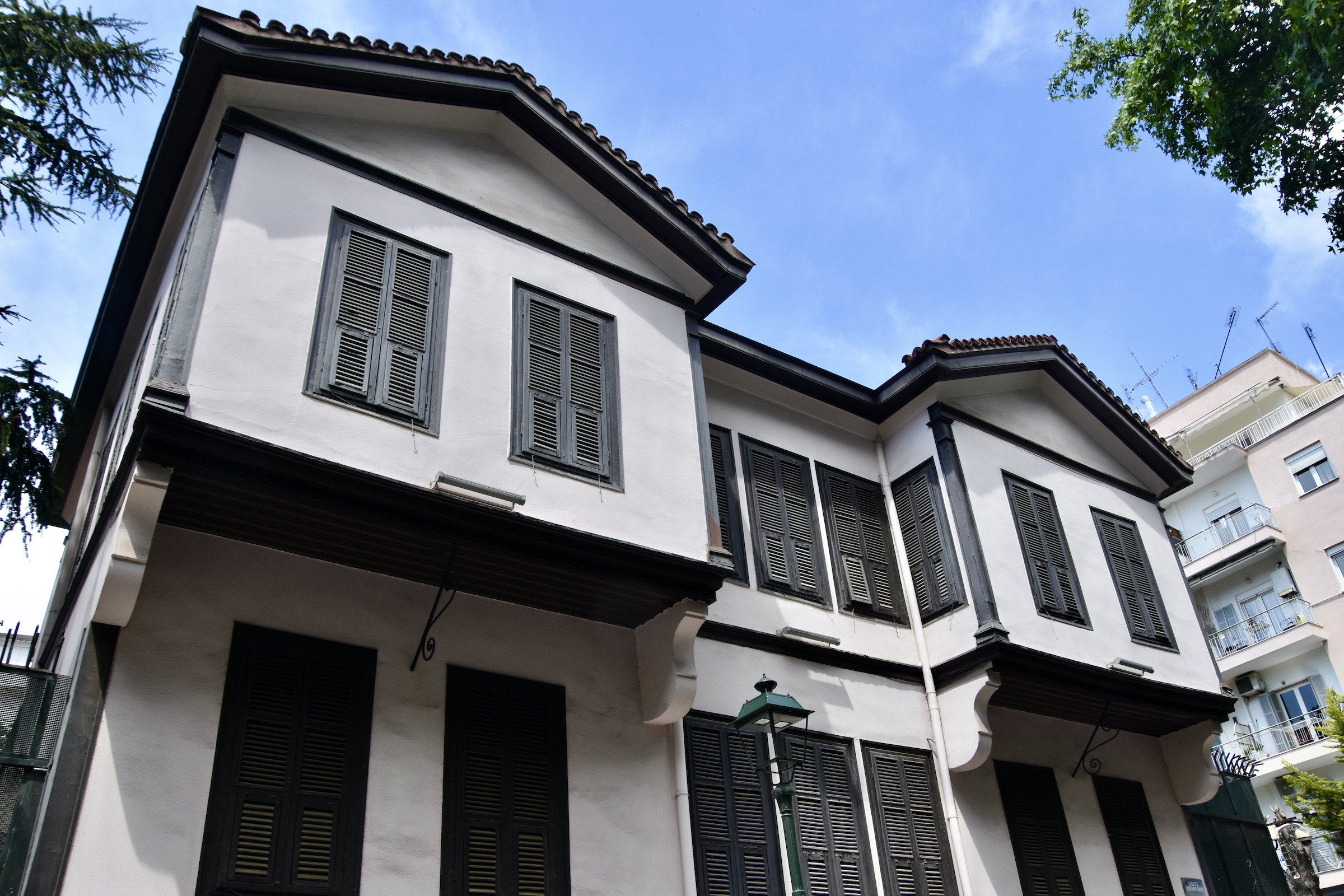
This is the room he was born in.
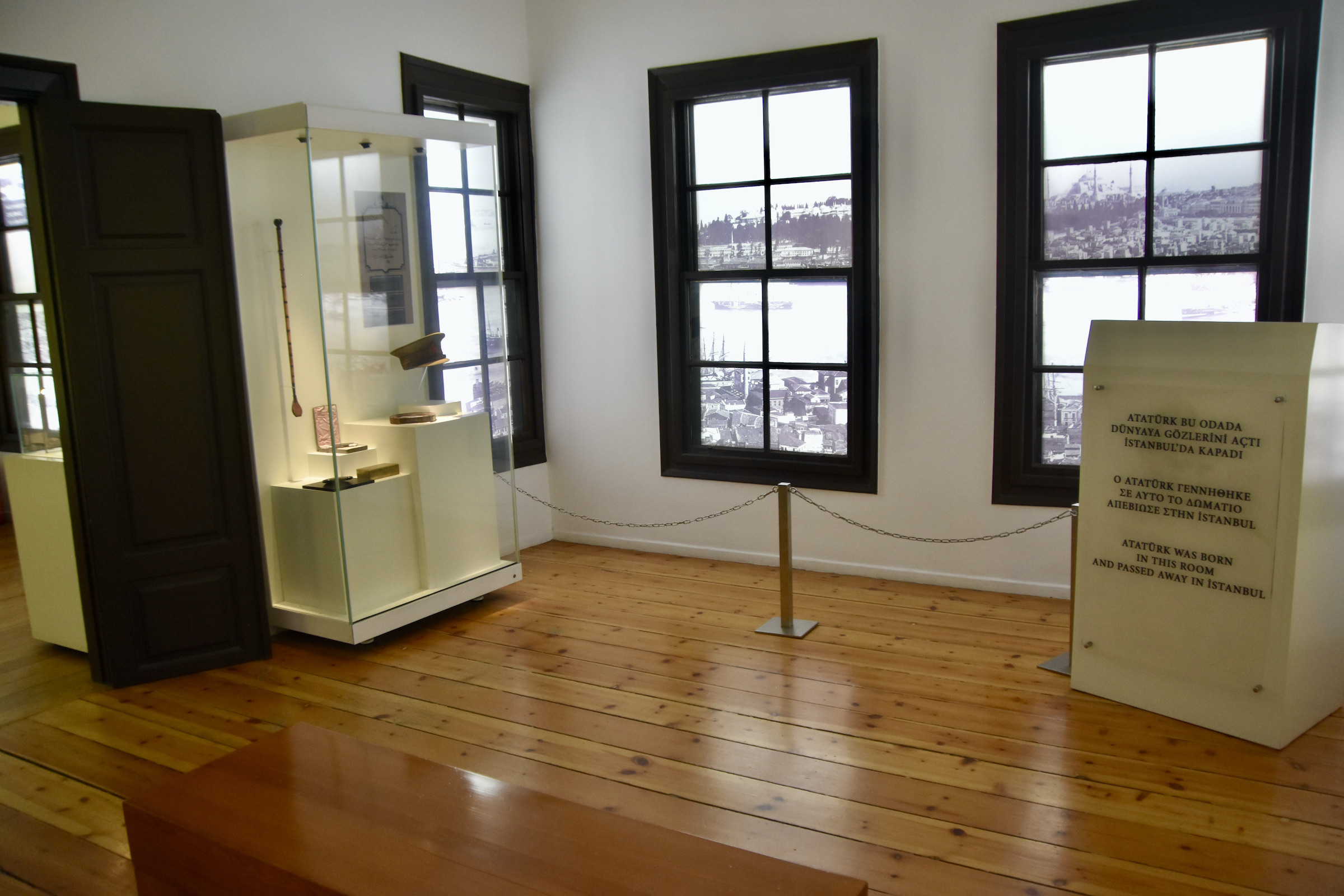
The property has a walled in backyard and a small garden which is the perfect place to get your picture taken.
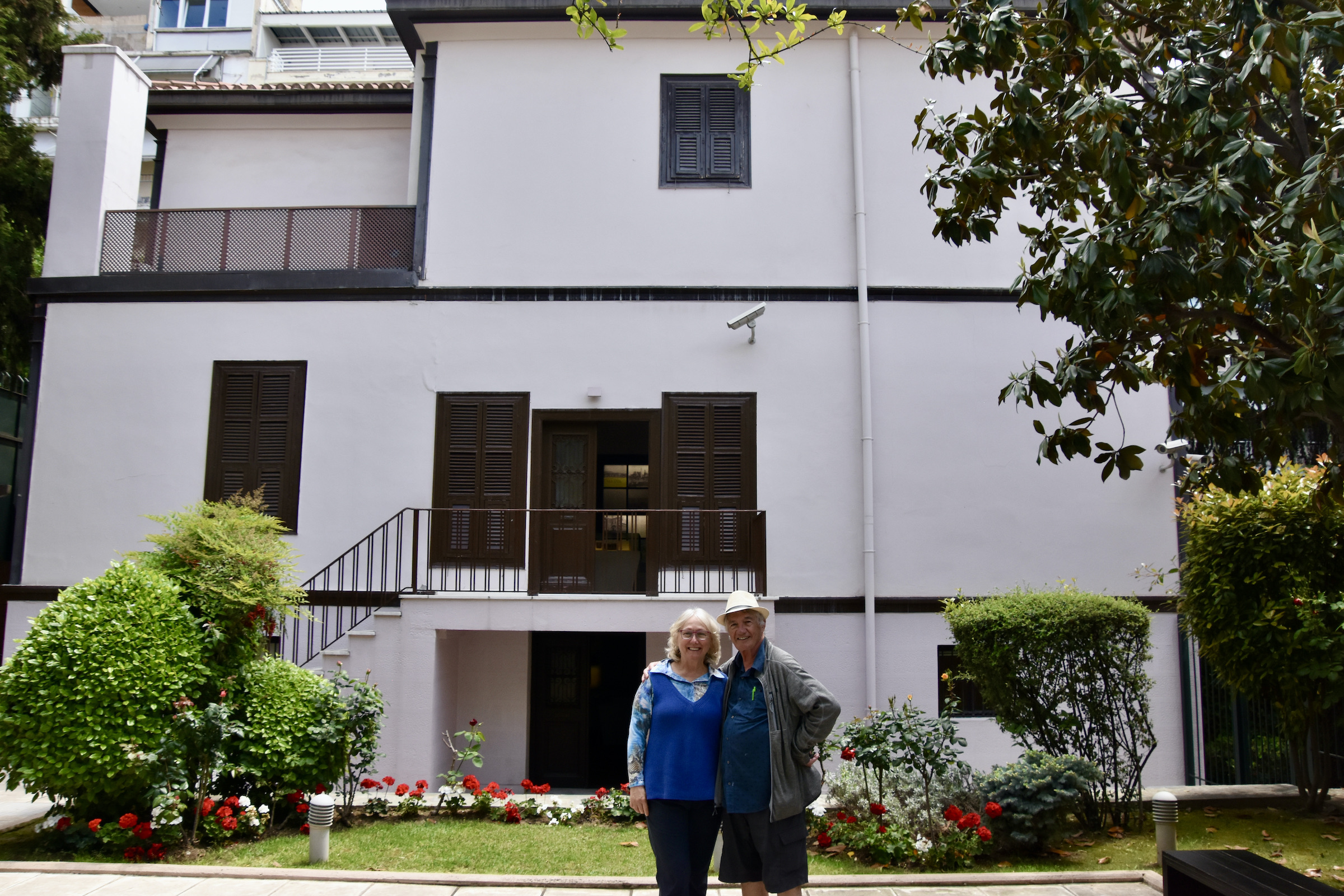
Salonika War Cemetery
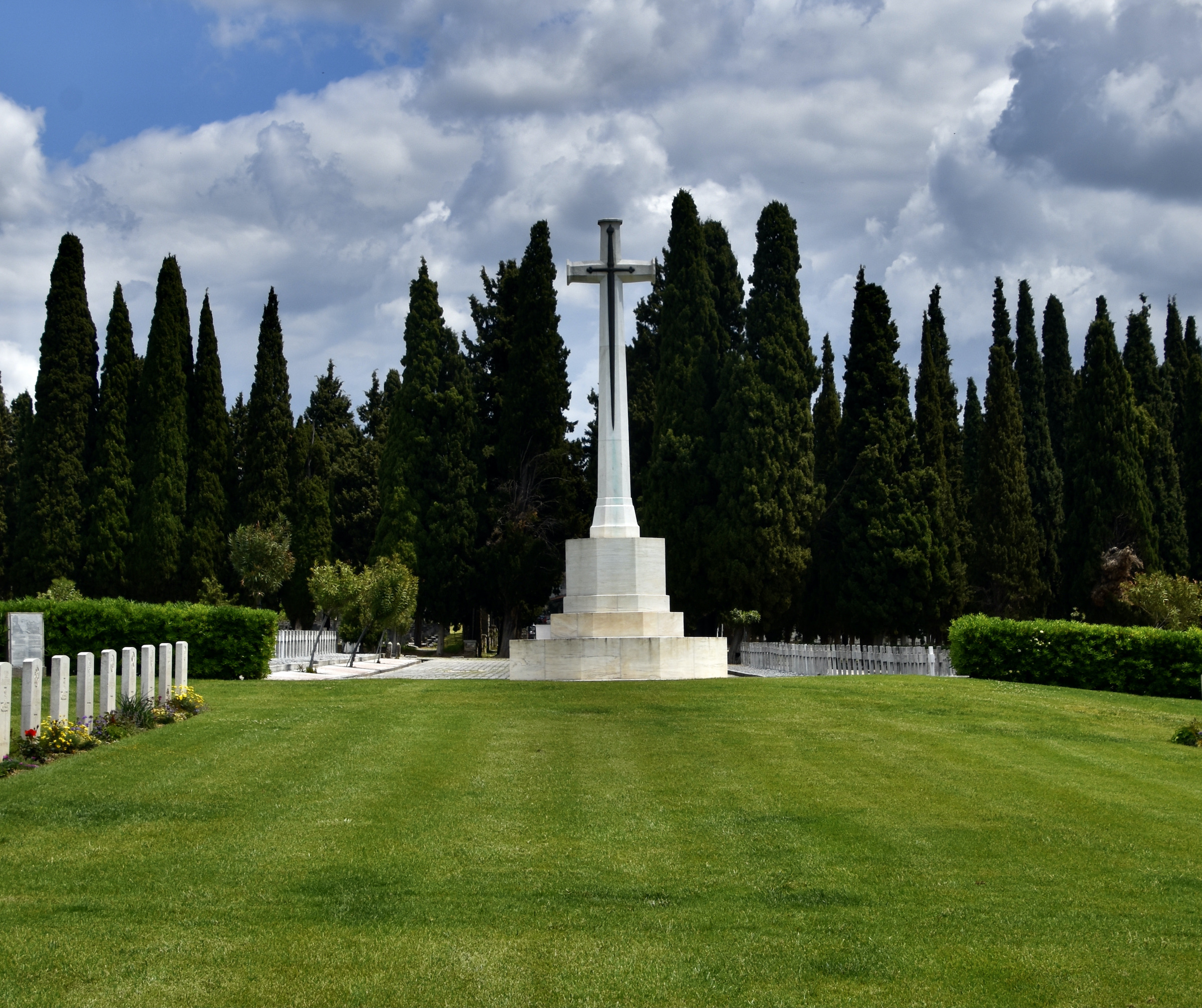
The final place we wanted to visit was the Salonika War Cemetery or Zeitenlik as it called by the Greeks inhabitants. One of the most forgotten theatres of WWI is the Salonika front which materialized after the Allied losses at Gallipoli coincided with Bulgaria joining the war on the side of the Central Powers and launching an attack on Serbia. Many of the French and to a lesser extent British forces that were evacuated from Gallipoli ended up in Thessaloniki, then called Salonika. They were joined by Serbs, Italians, Russians and after Greece joined the war in 1917 by Greeks. From 1916 to the end of the war a front was opened up from the Aegean to the Adriatic that saw well over 300,000 killed and more wounded.
Here is a map of the front that moved back and forth more so than the Western Front.
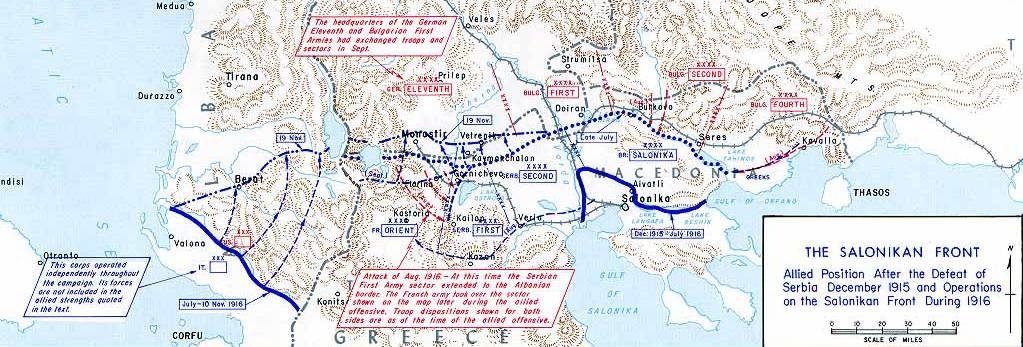
The Zeitenlik contains the graves of over 20,000 Allied soldiers including 1,683 British buried in the Salonika Military Cemetery, which is maintained by the Commonwealth Graves Commission as a distinct cemetery within a cemetery. The photo above is of the Cross of Remembrance in that cemetery.
My interest in the cemetery was to visit the graves of the three Canadians buried here. Although no Canadian troops were part of the fighting, they did operate three of the 18 military hospitals in Thessaloniki during WWI. It turns out Victor also had a reason for visiting; a great uncle is buried here.
The three of us took a taxi to the cemetery entrance on the outskirts of the city. The first thing you see upon entering is the monument to the Serbian dead, some 7,500 of whom lie here.
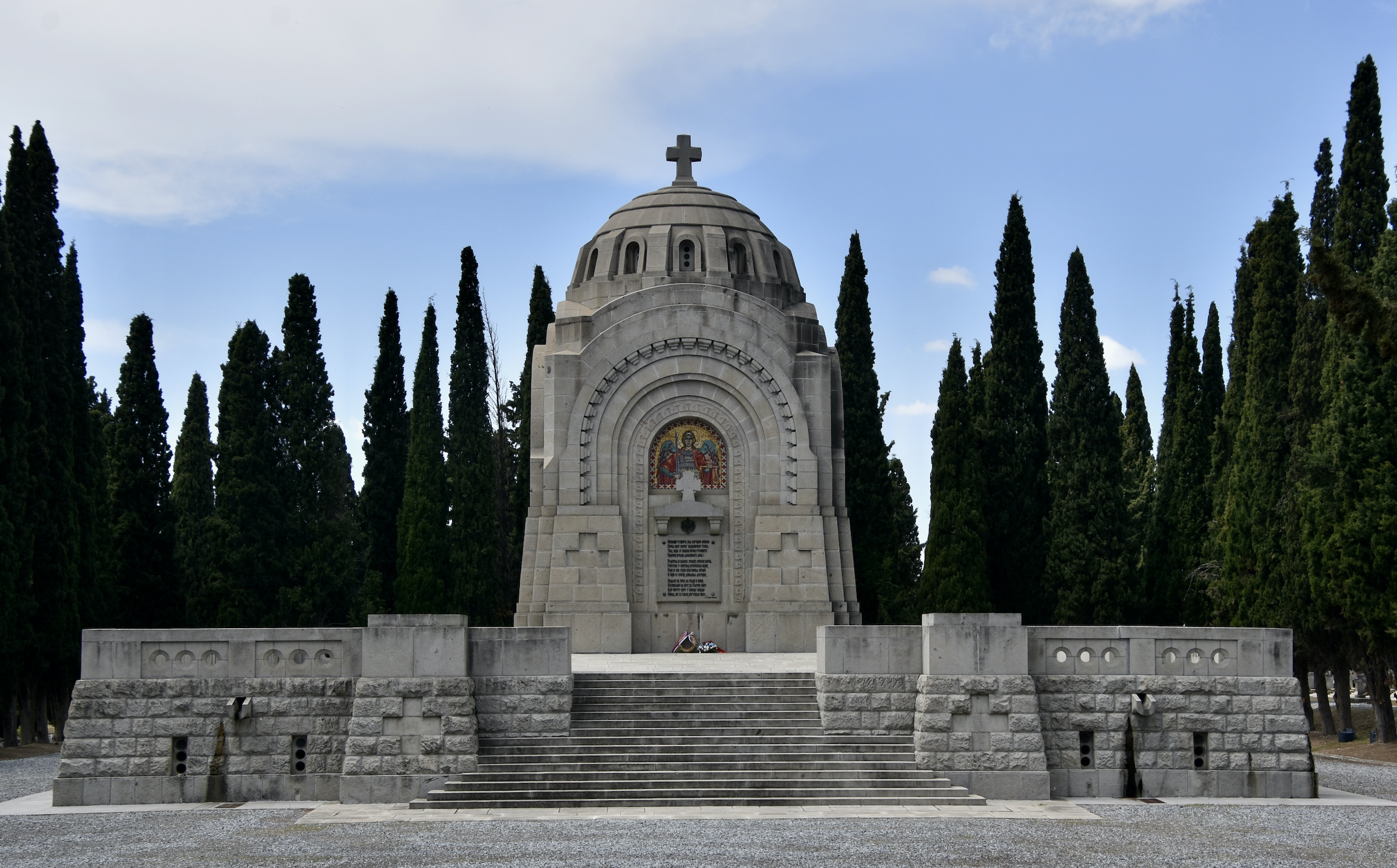
And then the French sector where a further 8,000 are interred.
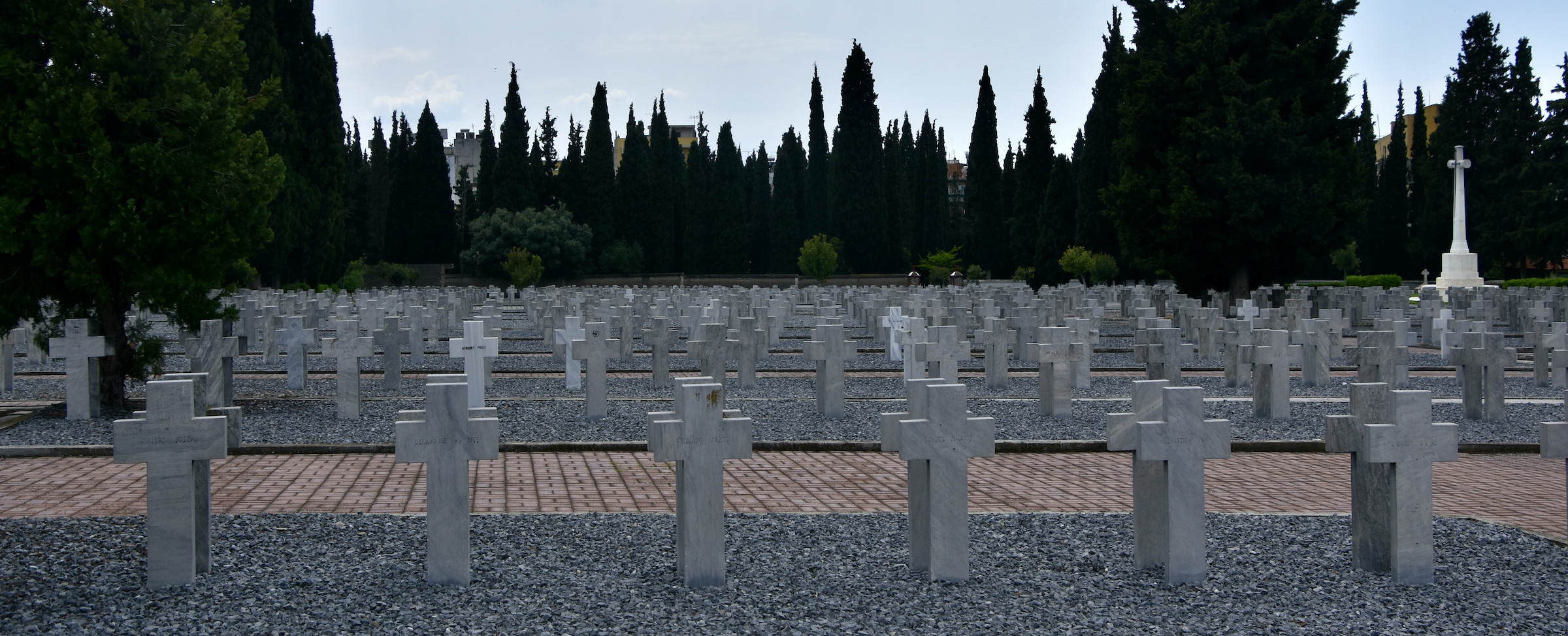
And behind that the Commonwealth graves. One stands out before we get to the area where we will find the Book of Rembrance which will help us find the graves we are looking for.
This is the grave of woman only referred to as Madame Harlay. She was in fact Katherine Mary Harley (not Harlay), the sister of Sir John French the commander of the British forces on the Western Front until 1916. She was working with the Red Cross when she was killed by Bulgarian shell fire in Serbia. She received the French Croix du Guerre for her efforts in ministering to French soldiers on the Salonika Front.
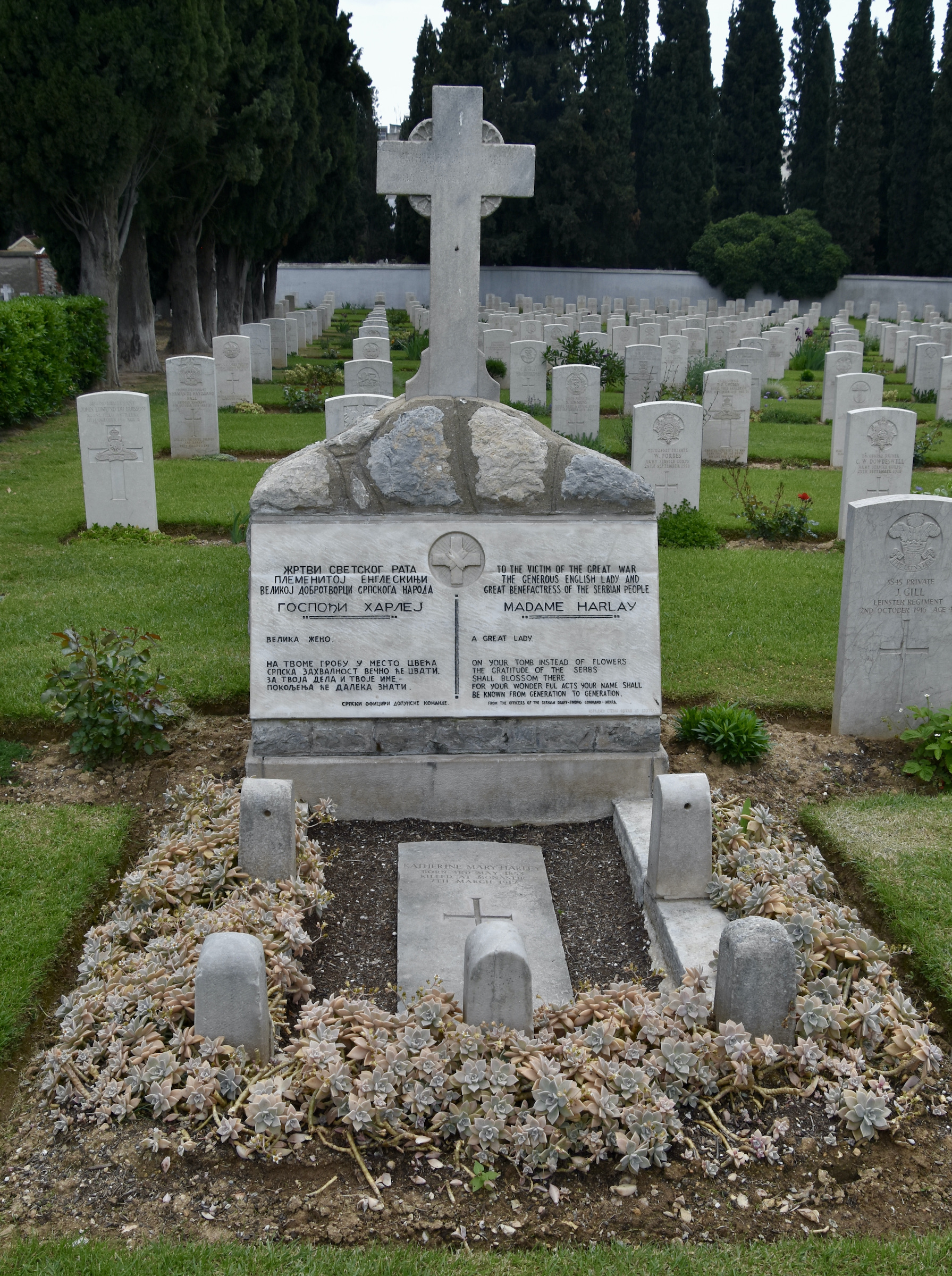
I found the graves of the three Canadians. This is Redmond John Furlong from Saint John, New Brunswick.
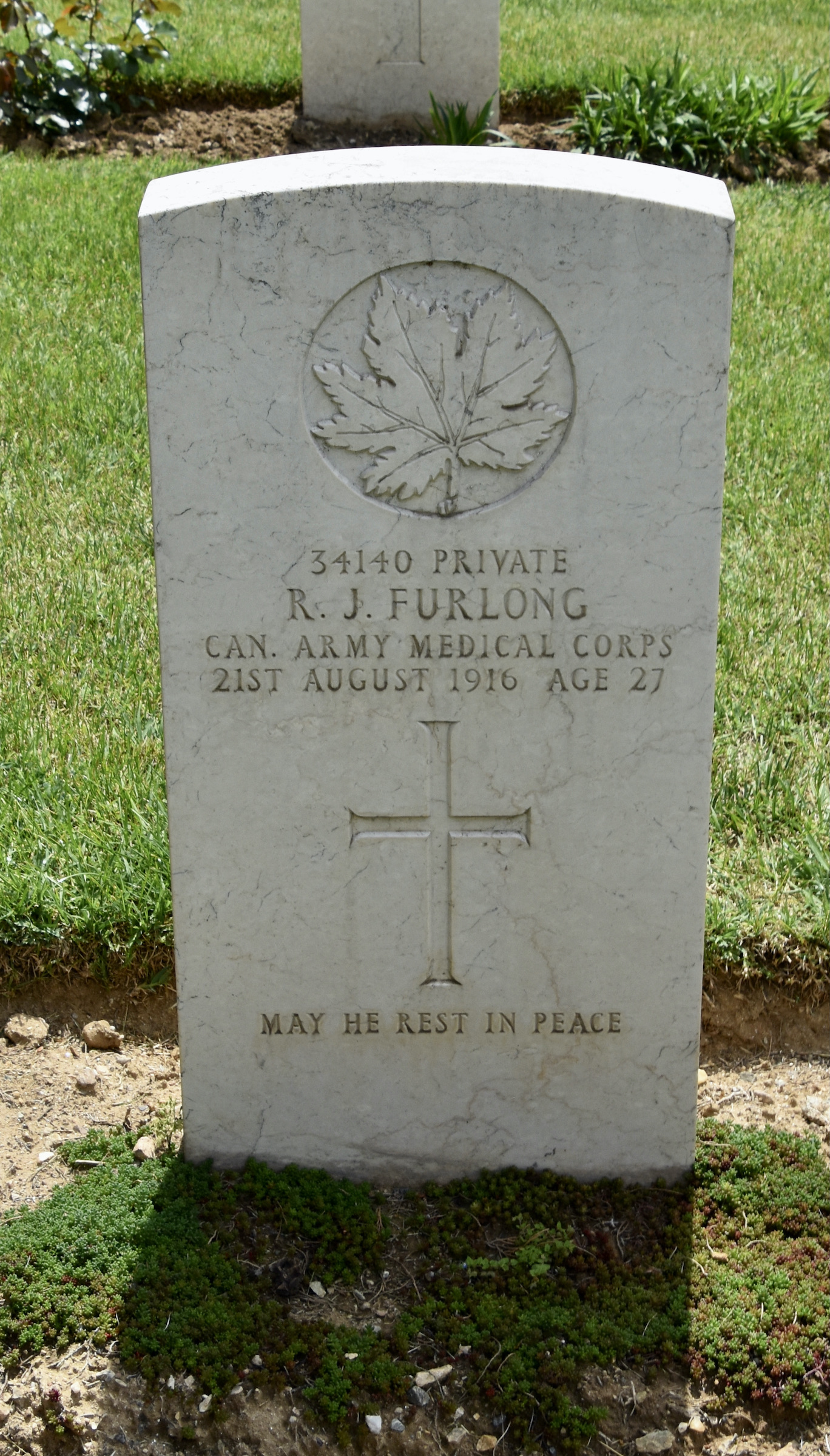
This is Corporal E. Hoare about whom I can find nothing, not even his first name.
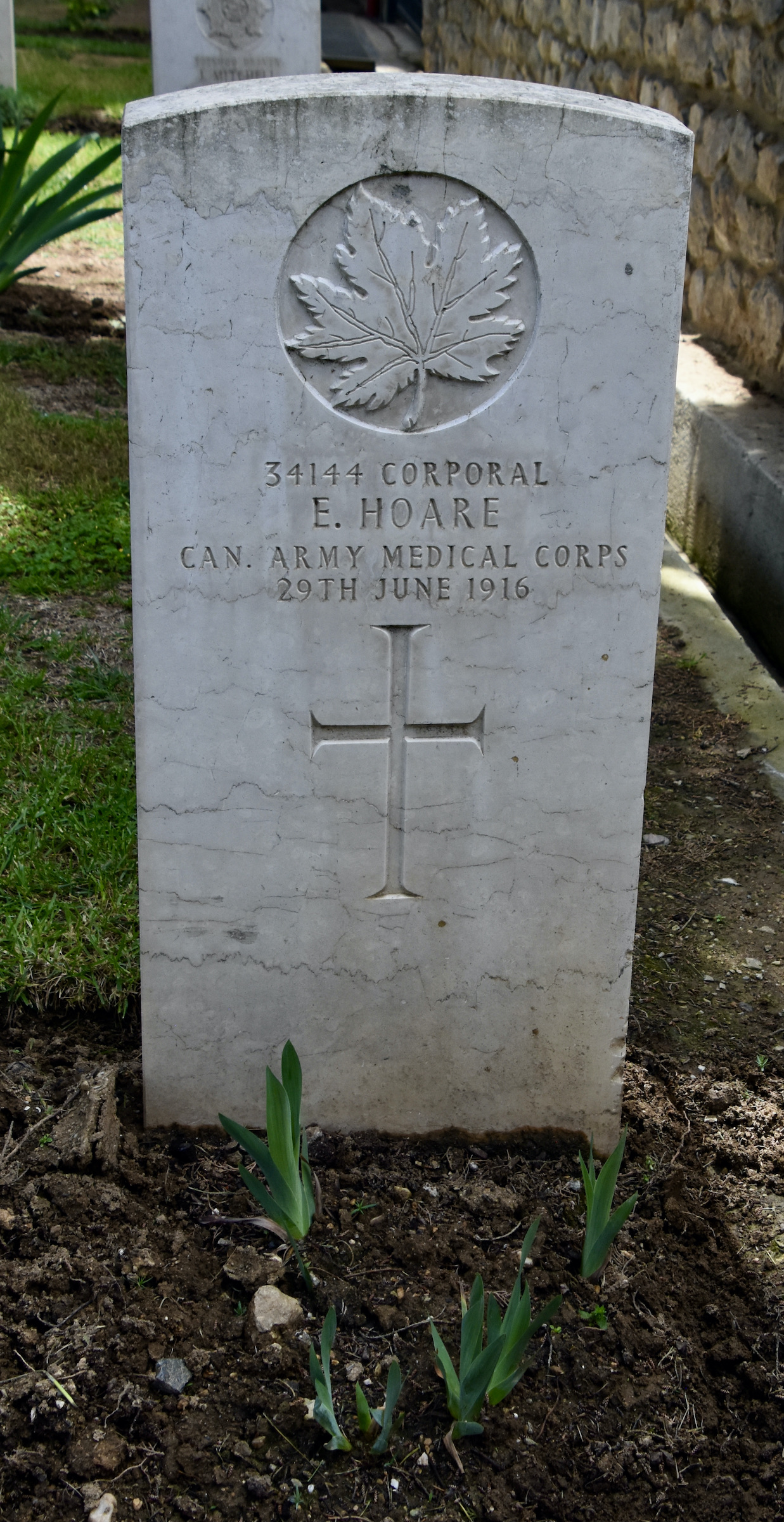
And lastly Captain Norman James Lang Yellowlees who was a doctor on staff at Toronto General Hospital at the outset of the war. He was the first Canadian doctor in the Balkans and accidentally drowned according to a story I found in the Toronto Star.
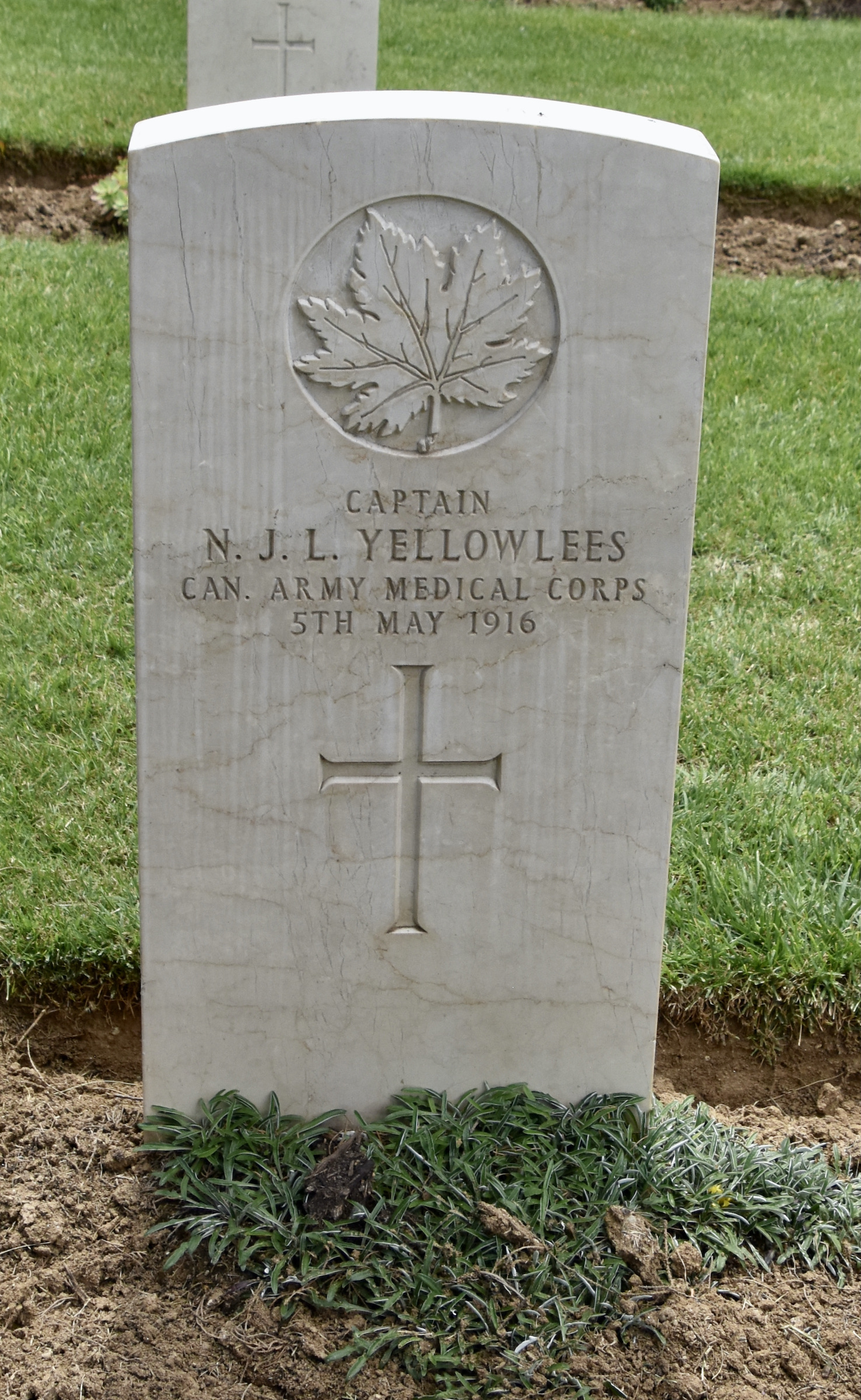
And Victor found his great-uncle, Thomas Neil McMenigall who served with the Argyle and Sutherland Highlanders. At 38 he was much older than most of the casualties and had a wife Isabella, son Edward and daughter Christina who would have been back home in the village of Currie, just outside Edinburgh.
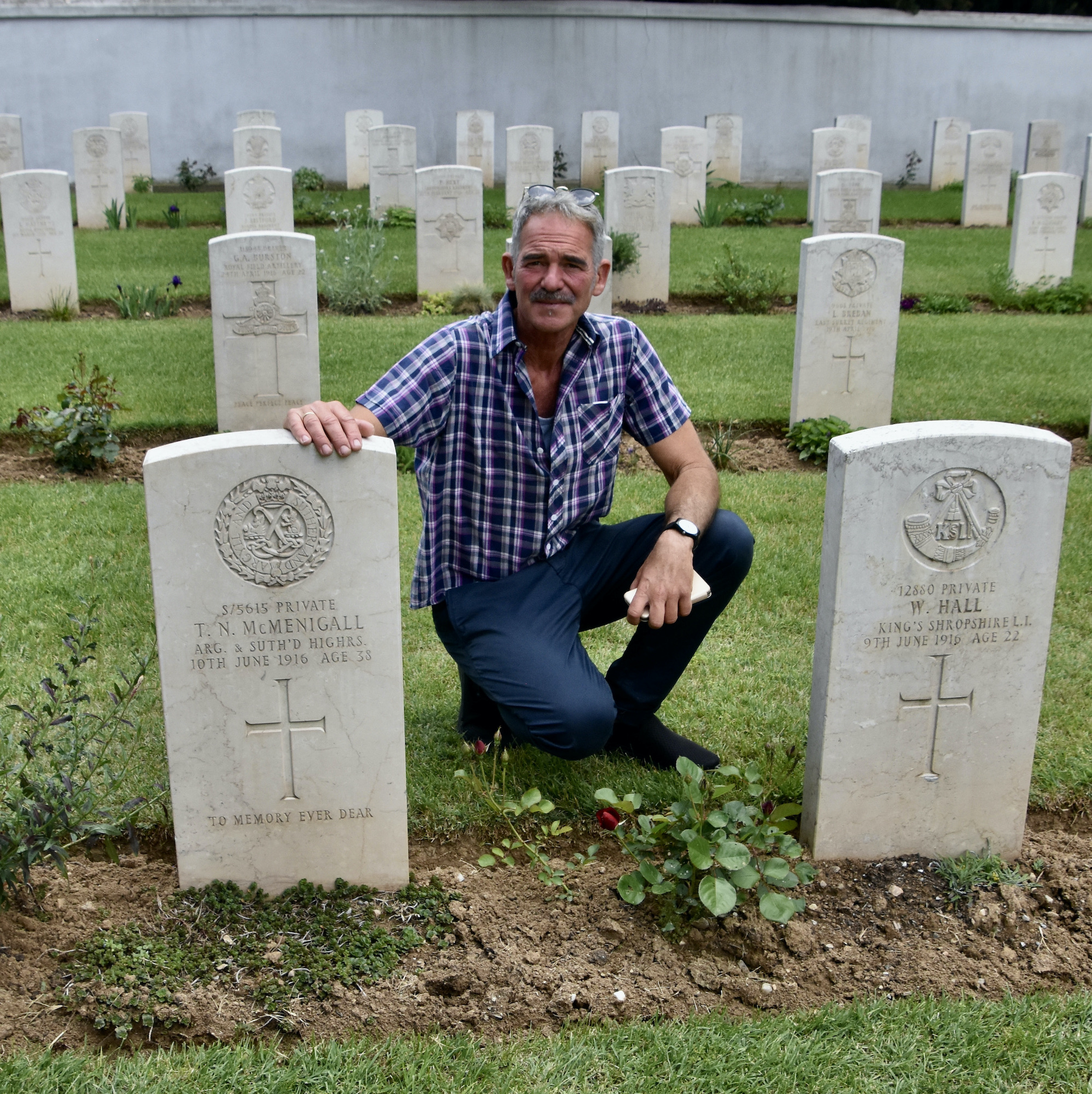
Well on that rather wistful note I’ll end this rather long post from Thessaloniki, a city that not only lived up to my expectations, but far exceeded them.
In the next few posts we’ll visit a number of sites associated with Alexander the Great and his father Philip.


